Better Sailing
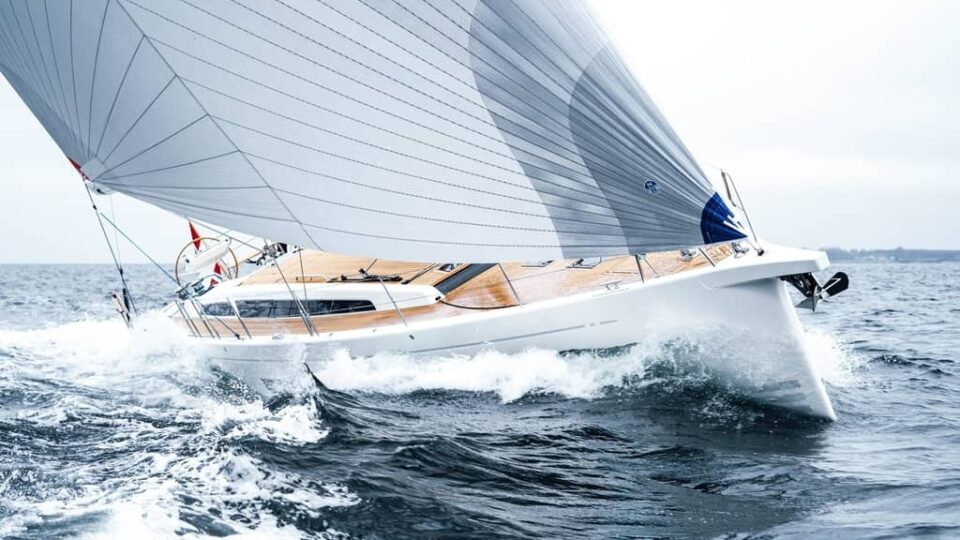

Names of Sails on a Sailboat
Are you a beginner sailor and want to get acquainted with the names of the sails? Are you an experienced sailor and want to learn more details about the sails on a sailboat? Then this article is written for you! Sails form a crucial part of the sailboat because without them, there’s no starting up. For that reason, there are many details about different types of sails concerning their utility, functionality, fabrication materials, and performance. Simply put, each sail serves different purposes when out on the water. Since the sail is the engine of your sailboat, in terms of it being the basic source of propulsion, it’s important to know when best to use either type of sail and why.
Types of Sails on a Sailboat
So, in order to better explain the types of sails, let’s look at their characteristics. The first important distinction between sails is their placement. Generally, the mainsail is placed aft of the mast , which means behind. On the contrary, the headsail is in front of the mast. There are also other sorts of sails that are used for specific conditions. These can be the spinnakers or balloon-shaped sails for downwind use. The second important distinction for the sails is their functionality. The specialized sails have different functionalities and are used in different sailing circumstances and weather conditions. A rule about sails is that large sails are appropriate for downwind use, whereas small sails are good for upwind use. Moreover, large sails perform better on weak winds while small sails are good for strong winds.
The Parts of a Sail and its Shapes
- Head: This is the top of the sail.
- Luff: The forward edge of the sail.
- Leech: Back edge of the sail.
- Tack: The lower front corner of the sail.
- Clew: The bottom back corner of the sail.
- Foot: Bottom of the sail.
There are two sail shapes, the fore-and-aft rigged sails, and square-rigged sails. Nowadays, fore-and-aft sails are more popular, have better performance and maneuverability. To grasp the idea square sails are the ones that Vikings had on their ships and are good at sailing downwind because they run from side to side. But they’re not suitable at all when sailing upwind. On the other hand, a fore-and-aft sail is tied from the front of the mast to the stern and is much better at sailing upwind.
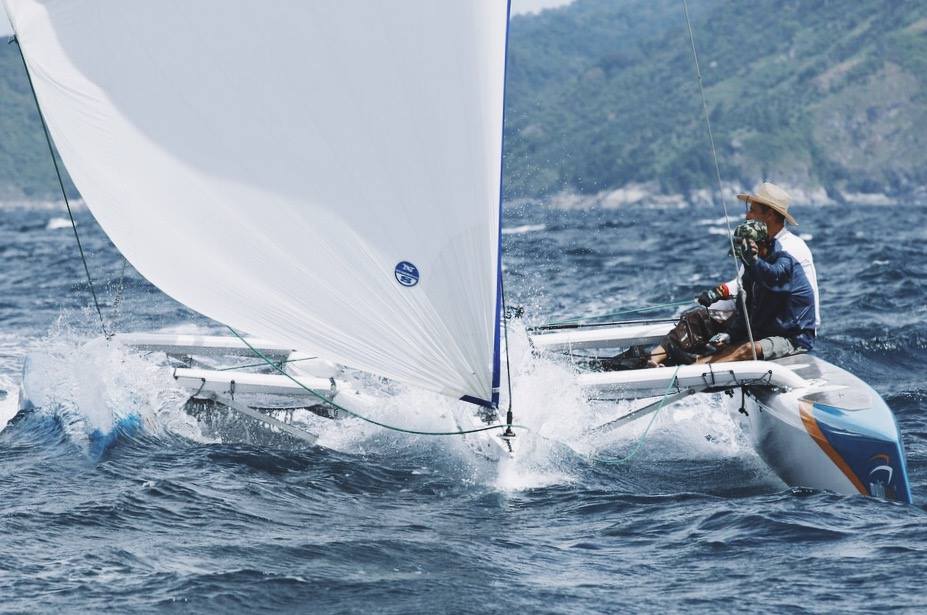
Also Read: What is Sailboat Rigging?
Types and Names of Sails
There are a lot of reasons why you’d want to put one sail over another, but the most important thing to remember has to do with the point of your sail and the wind strength. These points help you understand how your sailboat generates wind power. These points of sail include: into the wind (in irons), beam-reaching, broad-reaching, close-hauled, close-reaching, and running. They all go from windward to leeward and are symmetric from port to starboard . So, let’s get to the point and see the names and explanation of each sail:
- Mainsail : The large sail behind the mast which is attached to the mast and the boom, is called the mainsail. Mainsails cover a lot of surface area concerning incoming winds and by doing that they don’t need very strong winds to provide forward propulsion on a sailboat.
- Headsail or Jib : The small sail placed in front of the mast, attached to the mast and forestay (ie. jib or genoa), is called the headsail. Headsails are smaller than mainsails, thus their surface area is smaller. As a result, they can’t catch the same wind as a mainsail does. However, this is important because in case that the current wind is strong and the mainsail has been enough trimmed, being able to remove the mainsail and depend on the headsail alone, is a good strategy in order to reduce speed.
- Genoa : A genoa is like a large jib and it’s attached to the front of the forestay, like a headsail. When you use a genoa sail then you are expecting light to medium winds. Also, your sailboat would be somehow in a rush point of sail, meaning that the wind comes directly from the rear. Moreover, the surface area of a genoa sail is quite large, so it’s important to use it when winds are relatively low.
- Spinnaker : These downwind sails are symmetrical which makes them more sensitive to the reaching points of the sail and therefore more suitable for the running point of sail. Spinakkers are lighter than other types of jibs, and they don’t cover the mast like a genoa sail. Moreover, they remain unattached to the forestay and stretch out toward and past the bow of a sailboat.
- Gennaker : Gennakers are a mixture of genoa and spinnaker sails. There are small and big gennakers and both are downwind sails. They aren’t as symmetric as a spinnaker and aren’t attached to the forestay like a headsail. Furthermore, the gennaker sail is able to take on a more flexible point of sail while taking advantage of softer winds.
- Drifter Reacher : A drifter is a light air sail, and it’s basically a larger genoa for use in light winds. Its extra sail area offers better downwind performance than a genoa. It’s mostly made from lightweight nylon.
- Code Zero Reacher : This sail is a type of spinnaker, but it looks like a large genoa. However, code zero is designed for better reaching which makes it much flatter than the spinnaker.
- Windseeker : This sail is small, and it’s designed to guide light air onto the lee side of the mainsail. Moreover, it’s tall and thin and ensures a smoother flow of air.
Sail and Mast Configurations
Now that you got an idea of the different types of sails on a sailboat, it would also be an advantage to know how these types of sails are related to the configuration of a sailboat’s mast. There are numerous combinations when it comes to sails and mast configurations, let’s see some of them!
- Cat: A cat is similar to a dinghy and has one mast and one sail. The mast is located at the bow of the sailboat.
- Sloop: The sloop has the classic single mast and a double sail setup. The headsail can be different kinds of jibs, is connected with the forestay on the mast, and runs all the way up to the mast.
- Fractional Rig Sloop: A fractional rig sloop is different from the sloop because its forestay doesn’t reach the top of the mast. Its headsail is restricted to a fractional amount of space and this means that less wind can be captured, therefore the speed of the sailboat is reduced.
- Cutter: Having two forestays on the mast and cutters that are able to house two headsails this setup allows easy cruising because it offers a wide combination of points of sail for different strengths of wind.
- Ketch: Just like a sloop the ketch has a mast that enables the mainsail and headsail to a full range forestay. However, it also has a smaller mast between the mainmast and the stern of the sailboat.
- Schooner: A schooner is when a sailboat has two or more masts but it has a couple of sails to manage. A schooner’s aft mast is taller than the forward mast and sometimes a schooner can have up to six masts.
Names of Sails on a Sailboat – Summary
So, how many types of sails are there? In general, sailboats have one mainsail and one headsail. The rigging also affects the types of sails you can use. As we’ve explained before, the mainsail is a fore-and-aft Bermuda rig. Then, for a headsail, we use a jib or genoa. Most experienced sailors use extra sails to ensure better performance for their sailboat. For example, the spinnaker (a common downwind sail), the gennaker, the code zero (for upwind use), and the storm sail. Keep in mind that every sail has its own use and performance. Want to go downwind fast? Use a spinnaker. Don’t just raise any sail you think suits you best and go for it! It’s of great importance to understand the functionality, use, and performance of each sail.
Peter is the editor of Better Sailing. He has sailed for countless hours and has maintained his own boats and sailboats for years. After years of trial and error, he decided to start this website to share the knowledge.
Related Posts

Lagoon Catamaran Review: Are Lagoon Catamarans Good?

Best Inboard Boat Engine Brands

Are O’Day Sailboats Good? A Closer Look at a Classic Brand

Why Do Sailboats Lean?
- Buyer's Guide
- Destinations
- Maintenance
- Sailing Info
Hit enter to search or ESC to close.
Sail Types: A Comprehensive Guide to 8 Types of Sails
Sailboats come in all shapes and sizes. And that means there are many types of sails on the market! For those who might not know, sails are made of canvas and use wind power to propel sailboats through the water.
Understandably, different sails are required for different types of sailboats . And sailboats are categorized by the number of hulls they have. Monohulls have a single-hull design, catamarans have two hulls, and trimarans have three. Generally, sailors use catamarans for upwind sailing (but they can be used to sail downwind in certain conditions).
The type of sail you'll need for your sailboat depends on the kind of sailboat you have. Additionally, sails are highly dependent on the wind and weather conditions. Therefore, it's always a good idea to have different types of sails on board to navigate the ever-changing weather conditions.
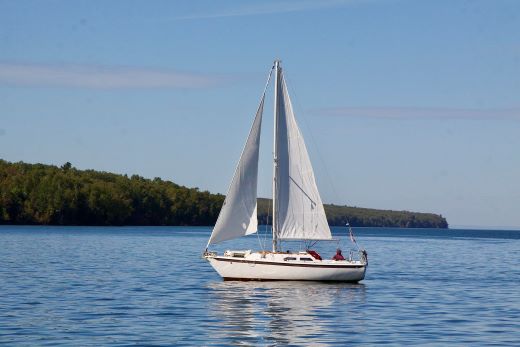
8 Types of Sails for Sailboats
As mentioned, you should carry multiple sails when sailing to prepare for various weather conditions. Here's a brief overview of the types of sails for sailboats:
1. Mainsails
The mainsail is the largest and most important sail. Therefore, it's probably the first sail to come to mind when you think of camping. Typically, it's situated directly behind the mast — connected to the boom — and uses wind energy to move the vessel. The mainsail plays a significant role in tacking and gybing, making it essential for any voyage.
Since the mainsail is a larger sail, it doesn't require wind to propel it forward. And the fact that it can be moved by moving the boom makes it uber-easy to operate.
Learn More About Sailing
2. Headsail
The headsail often accompanies the mainsail, though it is smaller in size. Regardless of your sailboat type, the headsail is positioned at the front of the mast – over the sailboat's bow.
Because headsails are small, they are helpful when navigating through windy conditions. Smaller sails catch less wind, preventing them from propelling your boat as strongly as larger sails. Additionally, headsails help lift, balance, and protect the vessel from inclement weather conditions.
While the term 'headsail' refers to any sail in front of the mast, the jib is the most common type of headsail. (And when a jib is so large that it overlaps the mast, it's called a genoa.)
Learn More About Sailboats
3. Genoa
The genoa is a large sail that attaches to the front of the forestay. (In this instance, it's similar to a headsail.) However, the genoa is larger than the headsail and overlaps the mainsail partially or completely to help the boat go faster.
Genoa sails are useful when sailing through light or medium wind. You can also use it when the wind comes directly from the rear. If you use a Genoa sail during high winds, you'll probably start sailing too quickly and put yourself and your boat at risk.
4. Spinnaker
The spinnaker is a large and whimsical (often colorful) sail. Spinnaker sails are usually symmetrical, allowing them to reach different points of sail. Generally, these are lighter sails and don't cover the mast like the genoa.
Because spinnaker sails are on the larger side, you have to be incredibly careful with them. Don't use them in rough conditions. Instead, save them for sailing in low winds and calm seas.
5. Gennaker
As the name suggests, the Gennaker sail combines a spinnaker and a Genoa sail. They are as large as the spinnaker, although they're not symmetrical.
They come in handy whenever the wind changes from a pure dead run to a reaching point of sail, as sailors can navigate various wind types with the same sail. It's still only meant for lighter and milder winds, but it's more versatile than the spinnaker and genoa.
6. Light Air Sails
Light air sails are useful in calmer conditions when the headsail and mainsail alone aren't cutting it. They include:
- Code Zero : A code zero sail is a gennaker sail ideal for sailing in light to mild winds. It's designed to create lift and boost boat speed whenever regular sails don't generate enough power. For that reason, many racers and cruisers use code zero sails to improve performance and gain control in various situations.
- Windseeker : This small, special sail is reserved for no wind or light wind. Essentially, it helps boats remain maneuverable in extremely calm conditions. And for that reason, it's valuable to long-distance sailors.
7. Storm Jib
Storm jibs can be used as a headsail whenever the weather is particularly rough and windy. Because it functions as a safety seal, it prevents boats from capsizing by reducing the sail area exposed to the wind. Therefore, it's a necessary sail for every sailor.
Read Next: Boating in Inclement Weather
During strong winds and storms, sailors can raise a trysail — a small, triangular sail near the boat's stern — for better control and stability. Generally, sailors do this whenever the mainsail becomes too large and challenging to maneuver.
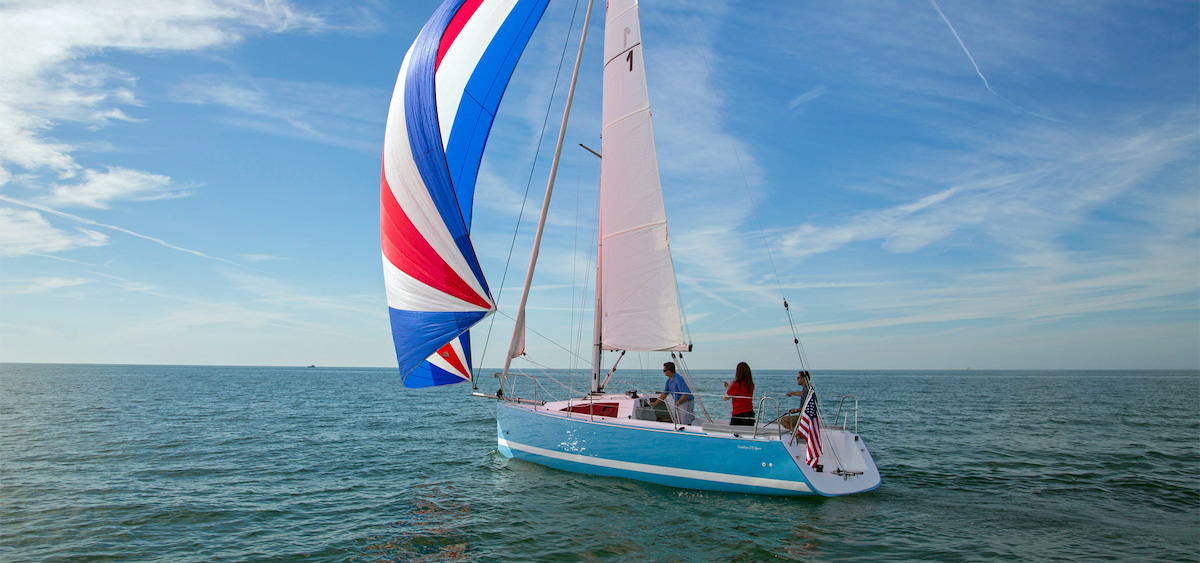
Join Our Newsletter!
Get community news, buying bargains, and how-to guides at your fingertips.
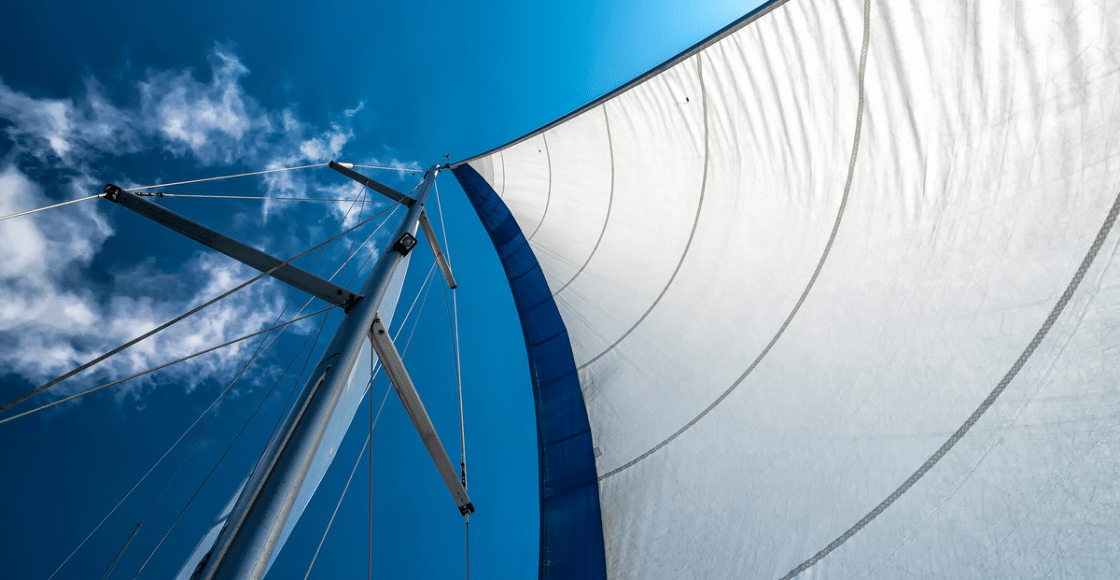
Type Of Sails: A Complete Guide

Table of Contents
Last Updated on September 29, 2023 by Boatsetter Team
If you are approaching sailing and sailboats from a very beginner’s perspective , then the concept of different kinds of sails can be a strange one. We often believe we see one kind of sailboat with one kind of sail, and our simple minds lead us to believe you are only meant to move them around, and you will get to where you need to go.
However, you would not have landed on this article if you did not suspect that there was more to sails and sailboats. So here, you can have a kind of in-depth, kind of summarized review of the different kinds of sails and the most popular sail and mast configurations out there.
It is also important to understand why there are so many different kinds of sails. When you are out on the water, different weather conditions can occur. Your sail acts as a motor of some sort, moving your sailboat forwards, but your sail is also highly dependent on the wind conditions around it. This is why having different kinds of sails can help you navigate your weather conditions and turn them to your own advantage while sailing.
Different sails also come with different danger levels in case of strong wind, so knowing what kinds you might need to watch out for is also extremely important. So, without further ado, let us get into it.
You may have heard of this one before or seen it portrayed in movies and TV shows. As the name suggests, the mainsail is the most popular kind of sail on any sailboat, and they are found behind the mast. They are also attached to the boom. Because they take up so much space on your sailboat, they are also one of the most important sails to take care of and keep an eye on.
Since the mainsail is such a large sail, it does not require too strong a wind to propel it forward , as its large surface area will easily catch a breeze. At the same time, the fact that it can be moved around by moving the boom makes it, so it is easy to steer. This makes it so that the mainsail is the most important sail on your sailboat.
Headsail/Jib
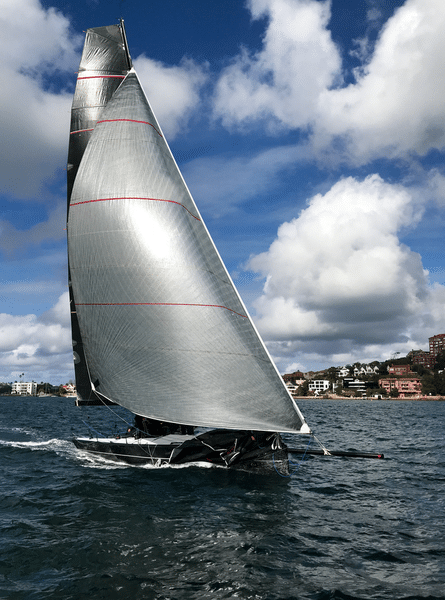
The headsail, or the jib, is likely the second most popular kind of sail found on sailboats. This is because it often accompanies the mainsail, the most popular kind. On all sailboats , the headsail is put at the front of the mast over the sailboat’s bow . It is always a smaller sail than the mainsail.
The fact that the headsail is smaller can be especially useful if you are caught in strong winds. In this situation, you likely do not want to use your mainsail (or trim it as much as possible) to move slower and not be thrown around by the winds. Smaller sails catch less wind, meaning they do not propel your boat as strongly as larger sails.
Having a good headsail can be an incredible safety measure, especially if the seas you are trying to sail are known to be wild and unpredictable.
You may have seen a genoa sail before if you have been around boats or have ever lived in a coastal town. This kind of sail is a large sail that you can attach to the front of the forestay (similarly to the headsail). This is a larger sail than the headsail and can even cover the mainsail either partially or completely. For this reason, the genoa also used to be called an “overlapping jib.”
You should use a genoa if you are sailing through either light or medium winds and if your sailboat is at a dead run point of sail (this means that the wind is coming directly from the rear. If you attempt to use a genoa sail in stronger winds , you might start going too fast and put yourself and your boat at risk since it is such a large sail. So, it is important to be careful .
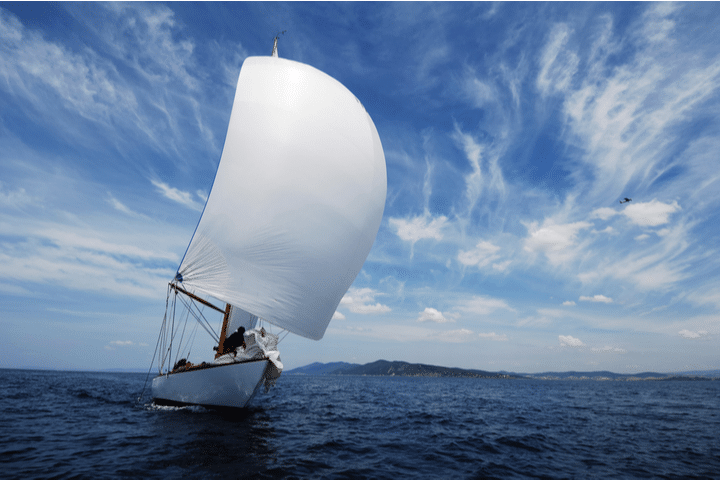
The spinnaker is the most whimsical kind of sail since it is a large and colorful kind. They are also often symmetrical, which means they are more appropriate for reaching different points of sail, such as the running point of sail. They are lighter sails, and they do not cover the mast as the genoa sail does. You do not attach a spinnaker to the forestay and instead let it stretch out past the boat’s bow.
The large surface area of the spinnaker means that you have to be even more careful than with others on the kind of conditions you choose to use this sail in. If the winds are too strong, you could be putting yourself and your passengers at serious risk using this sail, so you should choose to use it only at times when the wind is low or in seas that are known for their low winds and tranquility.
As the name suggests, the gennaker sail mixes the genoa sail and the spinnaker sail. These kinds of sails are more recent inventions. They are as large as the spinnaker sail, but they are not symmetrical. Unlike the genoa or the headsail, they are also not meant to be attached to the forestay, like the spinnaker sail.
The usefulness of this sail is that if the winds change from a pure dead run to a reaching point of sail, then sailors do not have to resort to using a spinnaker from a genoa, instead of being able to take advantage of different winds while still using the same sail as they were before. This kind of sail is still only meant for lighter and milder winds , but there is more flexibility with the gennaker than the genoa and the spinnaker sails.
Popular Sail and Mast Configurations
There are many different ways to place the sails we have learned about in the above section. We have compiled a list of some of the most popular ones so you can understand how these sails can be used to make a sailboat move through the oceans.
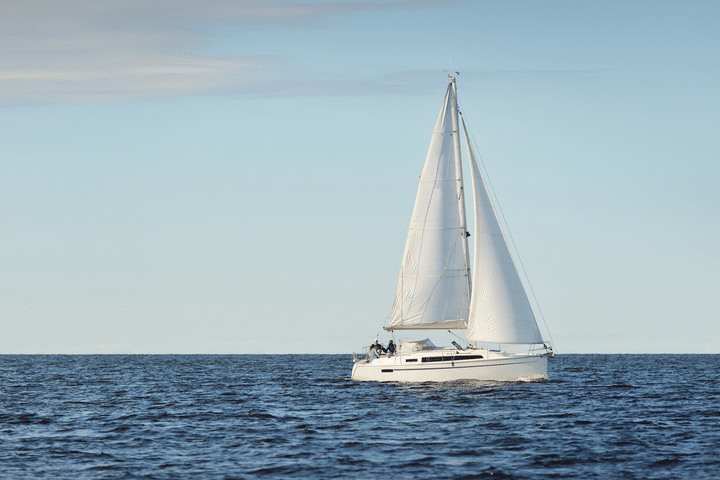
A sloop is by far the most popular configuration. It features a single mast, double sail (the mainsail and the headsail), and mast configuration. The headsail is located from the forestay on the mast to the top of it. The type of headsail used can also vary from a genoa, a spinnaker, or a gennaker sail.
Fractional Rig Sloop
A fractional rig sloop also features a single mast with a double sail setup similar to a sloop. However, what makes the fractional rig sloop different is that the forestay does not reach the top of the mast. This means the headsail is constricted to a smaller amount of surface than on a regular sloop, making it so that your sailboat captures less wind and moves slower .
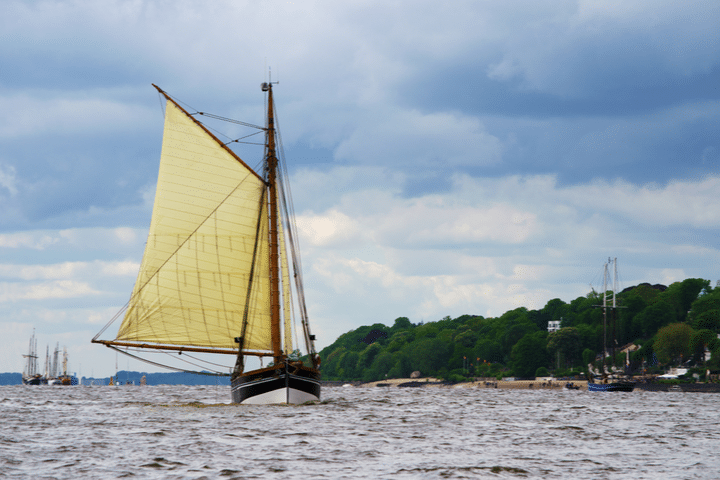
Cutters are interesting because they’re like a sloop but with a second forestay. This can be useful because it allows them to carry two headsails (a mainsail and one of the jibs). Cutters are good for cruising because they offer a range of wind options, giving you more time to get from place to place.
This is a less common mast configuration than previous others on this list. This is because a ketch features two masts. There is a larger mast fit for the mainsail and the headsail and a smaller mast between the mainmast and the stern (the rear) of the boat. This kind of mast configuration is more commonly found among Northern European freighters or fishing boats. This mast configuration is also called the mizzen mast.
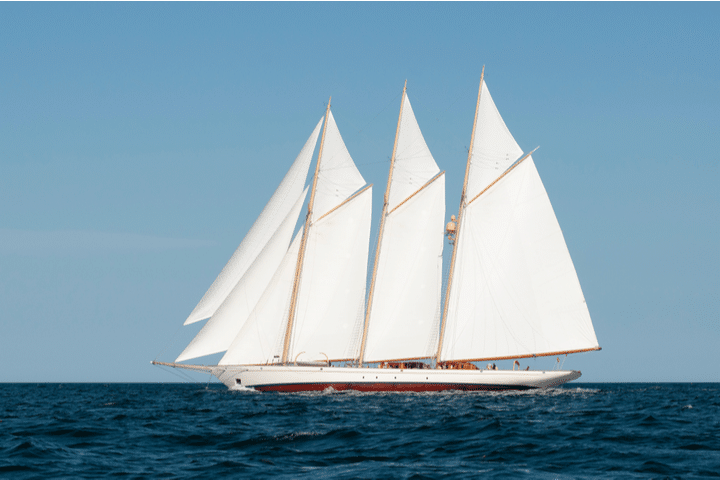
A schooner mast configuration features two or more masts. This is similar to the previous configuration, the ketch. It also features multiple sails. While a ketch’s aft mast (also known as the rear mast) is higher than the forward mast, a schooner’s aft mast is shorter than the forward mast. A schooner can also have up to six masts (although two are the most common). These are the main differences between the two.
This one is quite similar to a ketch mast configuration (mentioned above). The only real difference between them is that the mizzen mast is put directly behind the sailboat’s rudder post in a yawl.
A cat sail will have one mast and one sail. The mast is put at the bow of the sailboat. This kind of mast configuration is often found on smaller boats, more specifically on dingy boats. Boats with the cat mast configuration are also often called catboats.
Final Verdict
Having the appropriate kind of sail on your sailboat is incredibly important. At the same time, being aware of the kinds of sails that there are and the kind of sail and mast configuration can make you into a more well-rounded and informed sailor. With that in mind, we hope that you leave this article feeling more confident in your skills when you are out at sea.

Boatsetter empowers people to explore with confidence by showing them a world of possibility on the water. Rent a boat, list your boat, or become a Boatsetter captain today.
Browse by experience

Explore articles
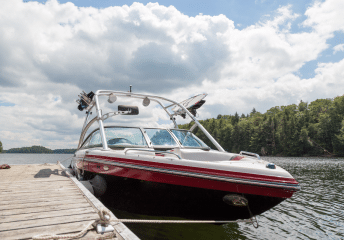
The Ultimate Guide to Choosing a Boat
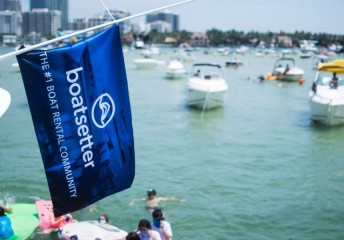
How to Rent Out Your Boat? (How Much Can You Actually Make?)
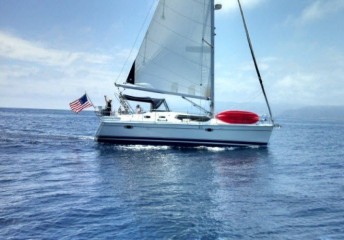
5 Reasons To Add Chesapeake Bay Boat Rentals To Your Boating Bucket List

Millennials leaving boating: How Boatsetter is reversing the trend

The Different Types Of Sails And When To Use Them – Complete Guide

Sail forms an integral part of a sailboat. When you sail on the open water and observe other boats (in various sizes), you’d have noticed how each boat type has a specific model of sail. If you’re a beginner in boating, you must know that there are a ton of different sails and they each have their own purpose.
As a general setup, sailboats will use three common sails, including headsail, mainsail, and specialty sail. Due to the varying wind conditions and the model of the sailboat, there are many types of sails including jib, genoa, trysail, storm jib, code zero, gennaker, and spinnaker.
While that sounds like too many models of sails, you can easily differentiate between them and choose the ideal model based on your purpose. This article guides you on this aspect. Let’s begin!
Different Types of Sails & When To Use Them
1. mainsail.
Mainsail is by far the most widely spotted sail model, and it’s usually fixed to the boom and fitted behind the mast. This offers the highest mileage to your sailboat, thereby maximizing speed and performance.
You can use a mainsail if:
- You’re concerned about the performance
- You need to go faster and utilize all wind power
- You need to steer your boat irrespective of the wind’s status
- You’ve a large boat and can offer adequate space to this sail.
This mainsail displays a wide surface area to make the most out of the available wind condition. As a result, you can steer your boat quite easily. However, the downside is its size. It is very large and hard to store if you need to take it down for some reason.
Check out my other article all about maintaing sails!
2. Headsail
Similar to a mainsail, it’s very easy to spot a head sail. Just look at the bow of the boat and see if there is a sail. If you see one then yes that’s a headsail. Also called a jib or genoa, a headsail is smaller in size compared to a mainsail and attaches in front of the mast to the forestay. The Foresail will not have a boom for the clew of the sail to attach to. The clew will be attached to the foresails sheet. It can be used without the mainsail in certain conditions but for the most part the two sails are used together. The foresail is always forward of the main.
The headsail comes in many different forms such as a jib, genoa, spinnaker or storm jib. The most common headsail is a jib or genoa.
You can use a headsail if:
- Your sailboat is set up for it.
- You don’t want to use the mainsail at this time.
- Your mainsail is not usable.
The biggest advantage of a headsail is the option to protect yourself even if the wind turns unpredictable or wild. This all depends on the type of headsail you are using.
So, what are the different types of headsails? Let’s take a look!
As more boaters chose to use a headsail for their boats, the jib was introduced as one of its forms. The Jib is a form of headsail that is attached to a shackle present on the deck’s front region.
The Jib is a sail that does not go past the mast when it is raised and in use. If it goes past the mast then you probably have a genoa.
You can use a jib if:
- You are out for a normal day of sailing in moderate wind speeds
- You have a roller furling. Which is a sail that wraps up around itself.
Some weather conditions can make maneuvering harder or tighter than usual. As a result, it’s essential to use a jib in such cases. It functions well with boats containing a roller furling as the jib handles different positions and tackles the movement of the boat at ease.
2.2 Genoa
Just when you’ve got acquainted with the jib, genoa comes into the picture as a larger version of the jib. If you’re boating along a coastal region, the genoa sail is the one widely used and is attached to the front area of the deck as well.
Here’s a quick trick to find out if a boat has a genoa sail. This genoa is usually larger than a Jib. This means that the genoa effortlessly overlaps and extends itself beyond the mast, thereby covering the mainsail as well.
You should use a genoa sail if:
- You’re planning to sail in minimum wind conditions. Less wind means you need more sail.
- You find the wind to originate from the rear area.
- You own a large boat. Remember that genoa can partially or completely cover the mainsail too. Larger sails for larger boats!
While it’s great for sailing in regular conditions, there are downsides associated with it. A genoa can put you in a dangerous situation if you are sailing in high wind conditions and don’t have the ability to furl in the sail. Furling in the sail will reduce the area of the sail and catch less wind.
Genoas do come in many sizes as well such as 110% or 120%.
The next section of the sail list are ones that aren’t necessary but can be helpful in certain situations. Let’s look at specialty sails!
3. Specialty Sail
While headsails and mainsails are quite commonly used, there are also specialty sails in the market to address specific requirements. Some of the widely seen specialty sails are spinnakers, storm jibs, and code zeros.
3.1 Spinnakers
Spinnaker is a sail dedicated to downwind and is quite large. Think of a beautifully covered parachute.
It’s easy to spot spinnakers as they resemble kites or parachutes. However, it crosses the bow of the boat and isn’t attached to the forestay.
Unlike the genoa sail that covers the mast, a spinnaker fails to do so. The advantage of a spinnaker is the surface area. When the wind is light, the spinnaker can catch a lot more wind giving you more speed. The Spinnaker is usually fixed to three points – pole, halyard, and sheet.
You should use a spinnaker if:
- You have minimal wind on a run.
- You are trying to harness as much wind power as you can.
While it has a wide surface area, the downside is its inability to steer the boat during strong wind conditions. It can even put the passengers at risk when the wind is at high speeds.
Make sure you have experience before trying out the spinnaker.
3.2 Storm Jibs
Storm jib is another type of specialty sail meant exclusively for rough weather. It’s a tiny, triangular structure that helps during offshore racing or cruising. Just think of it as a smaller jib.
You should use a storm jib if:
- You’re going to sail in heavy weather conditions.
- You anticipate high wind speeds.
- You’re going to be in an offshore race and they are an approved sail type.
Note: In the case of an offshore racing requirement, it’s critical to take prior permission from the regulatory authority for using a storm jib.
3.3 Code Zeros
Code zero is another updated version of a spinnaker that’s meant to be a combination of genoa and gennaker sails. It resembles the look of a genoa but is a lot bigger.
You should use a code zero if:
- You’re looking for an overlapping flying headsail.
- You’re sailing only in light air conditions.
- You’re looking for an alternative to a Genoa.
Having said that, a code zero or a screecher does the job of a genoa with better efficiencies.
3.4 Trysail
Trysail is another type of specialty sail that’s tiny, triangular, and can be fixed right above a gooseneck on the sailboat.
The Trysail is less known in the market as most boaters go ahead with common mainsails and headsails. It’s essential to acknowledge trysail as a front-and-aft mainsail model. It offers excellent performance and contains a permanent pennant in it.
You should use a trysail if:
- You’re sailing in heavy weather conditions.
- You’re looking for a storm replacement.
- You are experienced with using them.
The quadrilateral sail in a trysail is usually turned and bent to a mast, and this helps in heading the vessel during windy conditions.
3.5 Gennakers
If you’ve been able to spot genoa and spinnaker in the past, identifying a gennaker is incredibly easy. A gennaker is a hybrid sail form that is small, slow, and requires no pole attached to the mast.
You should use a gennaker if:
- You’re looking for a smaller version of a spinnaker.
- You’ve no space to fix a pole to the mast.
- You require the sail to be easily manageable.
- You’re sailing in a region requiring minimum downwind levels.
Choosing a hybrid sail has a lot of benefits as it combines the usefulness of 2 sail models. However, being aware of their cons is critical to planning a safe sail.
As you begin using these sails, you can also look for better customizations. There are drifters, wind seekers, and other jib types that are meant to handle different wind conditions.
How Many Sails On A Sailboat ?
In general, a sailboat contains two sails. Two sails is the typical setup for the best performance of the boat during different wind conditions. It’s essential to pick your two sails based on your sailing plan.
Why Are There Two Sails On A Sailboat?
A sailboat uses two sails because the wind left over by the first sail is easily caught by the second sail. This helps in steering the sailboat to a better extent and gives the sailboat more power.
Final Thoughts
Sails are one of the major assets of a sailboat. From managing wind to maximizing the performance and longevity of a sailboat, the type of sails you use, plays a huge role. From the various sail types listed in this article, you can choose the best model that fits your sailing routine. Just make sure to remember to check and make sure they are the correct size for your vessel.
Make sure to plan ahead and have the right sails for your sailing weekend. Cheers!
Boatlifehq owner and author/editor of this article.
Recent Posts
How to Repair a Sailboat Hull: Step-by-Step Guide
Maintaining your sailboat's hull is crucial for ensuring its longevity and performance on the water. Hull damage can occur due to various reasons, such as collisions, grounding, or general wear and...
10 Steps For Anchoring Your Sailboat
Anchoring a sailboat is a fundamental skill every sailor must master. Proper anchoring ensures your boat remains secure, preventing it from drifting and potentially causing damage. Whether you're...

Boat Sailor
Type of sails: a comprehensive guide to sails.
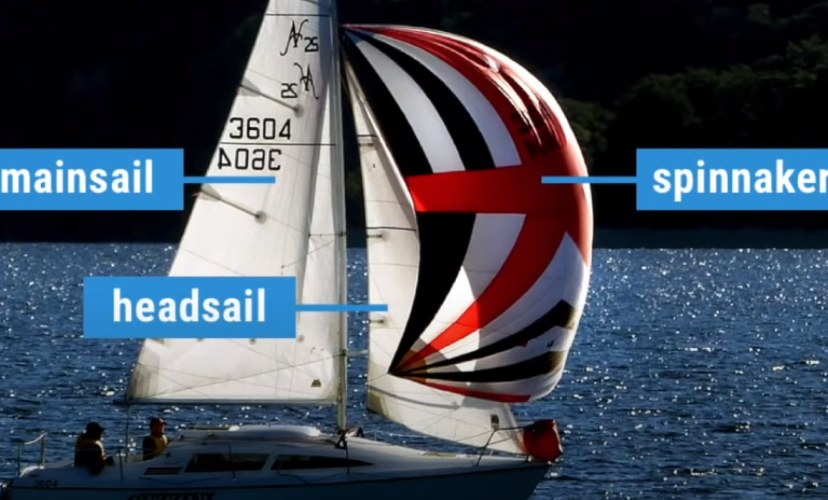
As an avid sailing enthusiast and advisor, I am excited to share a complete guide to different types of sails for sailboats. Choosing the right sail is crucial for optimizing sailing performance and ensuring safety in various weather conditions. In this article, we will explore the main type of sails, their advantages, and when to use them effectively. So let’s set sail and delve into the world of sails!
The Main Types of Sails
Mainsail: The Backbone of Sailing
The mainsail, being the largest and most essential sail on a sailboat, plays a central role in driving the vessel forward. It is a fore-and-aft rigged sail attached to the mast and the boom. Mainsails are incredibly versatile and suitable for various wind conditions, making them the go-to sail for most situations. They are easy to steer, even in light winds, making them ideal for relaxed cruising.
Headsail/Jib: Your Go-To Sail for Safety
The headsail, also known as a jib , is a smaller sail located forward of the mast. Its primary purpose is to maintain stability and balance the boat in strong winds. When the wind picks up, the mainsail can become overpowering, and that’s when the headsail steps in to ensure safe and controlled sailing. It’s like having a safety net during rough weather conditions.
Genoa: Power and Versatility Combined
The genoa is a type of headsail that offers more sail area and power compared to a standard jib. It’s perfect for boosting speed and maneuverability, especially in light winds. Genoas are incredibly versatile, making them an excellent choice for sailors who want to get the most out of their sailboat in various conditions.
Sailing Ship Rigs: A Historical Perspective
In the era of the “golden age of sail,” different sail plans were used on sailing vessels to optimize their performance and accommodate smaller crews.
Fore and Aft Rig
The fore-and-aft rig, consisting of sails aligned along the length of the boat, includes popular designs like schooners and sloops. These rigs required smaller crews and were well-suited for coastal and fishing trades.
Square topsail schooners with athwart sails were also prevalent during that time. They were used for cargo ships and long voyages, but their complex rigging required larger crews to handle the sails effectively.
The Golden Age of Sail
This period marked the peak of sailing ship technology and saw remarkable advancements in shipbuilding and sail design. It’s a fascinating chapter in the history of sailing that continues to inspire sailors to this day.
Type of Sails Names: Decoding the Terminology
Mainsail and Foresail
The mainsail, as mentioned earlier, is the principal sail that catches the wind to move the boat forward. Foresail is a general term that includes various sails positioned near the bow of the sailboat, such as the jib and genoa.
Genoa and Jib
The genoa and jib are both types of foresails. The genoa is larger and overlaps the mainsail, providing additional power and efficiency. The jib, on the other hand, is smaller and is used when the wind is stronger.
Staysail and Spinnaker
Staysails are triangular sails set between masts and stays, used to improve stability and balance. Spinnakers are large, balloon-shaped sails used for downwind sailing, providing an extra boost of speed.
Choosing the Right Sail for Different Conditions
Sailing in Light Winds
In light winds, the mainsail is your best friend. It’s highly efficient and capable of catching even the slightest breeze, propelling the boat forward smoothly.
Sailing in Strong Winds
When the wind picks up, it’s time to rely on the headsail or jib. These sails provide a reduced surface area, preventing the boat from becoming overpowered and ensuring a controlled sail.
Navigating Challenging Weather
Different weather conditions call for different sails. Understanding the intricacies of each sail and when to use them will help you navigate through challenging weather with ease.
Type of Sails Materials: Quality Matters
Traditional Canvas Sails
Traditional canvas sails, made of materials like cotton or linen, were commonly used in the past. While they offer a classic charm, their performance and durability have limitations compared to modern sail materials.
Modern Sail Materials
Today, sail manufacturers utilize advanced materials like Dacron, Mylar, and Kevlar. These materials offer superior strength, low stretch, and better shape retention, contributing to improved sailing performance.
Pros and Cons of Each Material
Understanding the pros and cons of different sail materials will help you make an informed decision when purchasing or maintaining your sails.
Understanding Sail Shapes and Configurations
The Science of Sail Shape
Sail shape is crucial for maximizing performance and efficiency. Properly trimmed sails allow you to sail efficiently, whether you’re sailing upwind or downwind.
Balancing Performance and Stability
Finding the right balance between performance and stability is essential. Adjusting sail shape and trim can significantly impact your sailing experience.
Fine-Tuning Sail Trim
Sail trim is an art form. Mastering the art of fine-tuning sail trim will make you a more skilled sailor and enhance your overall sailing experience.
The Evolution of Sail Designs
From Classic to Cutting-Edge
Sail design has come a long way. From classic traditional sails to modern, innovative designs, sailmaking has witnessed significant evolution.
How Technology Impacted Sail Design
Technological advancements have revolutionized sailmaking, resulting in more efficient, aerodynamic, and performance-oriented sails.
Innovation in Sailmaking
Sailmakers are continually exploring new materials and construction techniques to create sails that are lighter, stronger, and more efficient than ever before.
Sailing Techniques: Getting the Most Out of Your Sails
Tacking and Gybing
Tacking and gybing are essential sailing maneuvers used to change the direction of the boat and optimize the use of wind.
Maximizing Speed
To get the most out of your sails, understanding how to trim them properly and sail at optimal angles is crucial for achieving higher speeds.
Safety Precautions
Sailing is exhilarating, but safety should always be a top priority. Understanding safety procedures and precautions will ensure a safe and enjoyable sailing experience.
Maintaining and Storing Sails
Sail Care and Maintenance
Proper care and maintenance are essential to prolong the life of your sails and keep them in top condition.
Storing Sails Properly
When not in use, storing sails correctly can prevent damage and maintain their performance over time.
Extending the Lifespan of Sails
With proper care and attention, you can extend the lifespan of your sails, making them a worthy investment.
Sustainable Sailing: Eco-Friendly Sail Materials
The Impact of Traditional Sails on the Environment
Traditional sail materials, while charming, may have a more significant environmental impact compared to modern, eco-friendly alternatives.
Eco-Friendly Sail Options
Eco-conscious sailors can explore sustainable sail materials that minimize environmental harm without compromising performance.
Embracing Sustainable Practices
As sailors, we have a responsibility to protect the oceans and environment. Embracing sustainable practices in sailing is essential for the well-being of our planet.
As we conclude this comprehensive guide to different type of sails, I hope you now have a deeper understanding of the critical role sails play in sailing. Choosing the right sail and mastering sail techniques will elevate your sailing experience to new heights. Remember, sailing is an ever-evolving journey of learning and adventure.
Which sail is best for light winds?
The mainsail is the most suitable sail for light winds as it can efficiently catch even the slightest breeze and keep the boat moving smoothly.
What is the purpose of a genoa?
The genoa is a type of sails that provides additional power and versatility, making it an excellent choice for boosting speed and maneuverability in various wind conditions.
What sail material is most durable?
Modern sail materials like Dacron and Kevlar offer superior strength and durability compared to traditional canvas sails made of cotton or linen.
How do I maintain my sails?
Proper care and maintenance, including regular cleaning and inspection, will help prolong the life of your sails and ensure they perform optimally.
Are there eco-friendly sail options?
Yes, eco-conscious sailors can opt for sustainable sail materials that minimize environmental impact, contributing to a greener and more sustainable sailing experience.

Michael Thompson
Embarking on a lifelong love affair with the sea, I found solace and exhilaration in the art of sailing. From navigating treacherous waters to harnessing the wind's untamed power, my passion has evolved into a mission to inspire others. Join me on a voyage of discovery as we explore the vast horizons of sailing's timeless allure.
More to Explore

Spiridakos Sailing Cruises: An Unforgettable Adventure
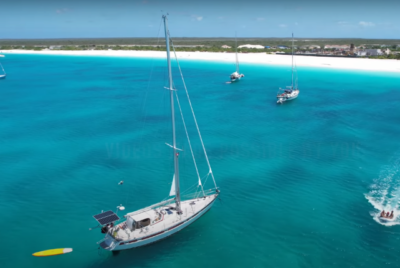
Sailing in the Caribbean
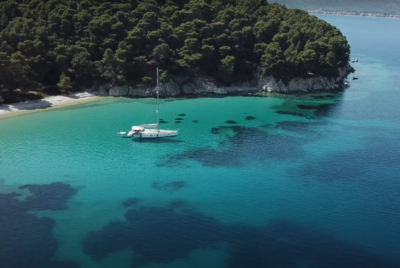
Sailing Greek Islands
- PRO Courses Guides New Tech Help Pro Expert Videos About wikiHow Pro Upgrade Sign In
- EDIT Edit this Article
- EXPLORE Tech Help Pro About Us Random Article Quizzes Request a New Article Community Dashboard This Or That Game Happiness Hub Popular Categories Arts and Entertainment Artwork Books Movies Computers and Electronics Computers Phone Skills Technology Hacks Health Men's Health Mental Health Women's Health Relationships Dating Love Relationship Issues Hobbies and Crafts Crafts Drawing Games Education & Communication Communication Skills Personal Development Studying Personal Care and Style Fashion Hair Care Personal Hygiene Youth Personal Care School Stuff Dating All Categories Arts and Entertainment Finance and Business Home and Garden Relationship Quizzes Cars & Other Vehicles Food and Entertaining Personal Care and Style Sports and Fitness Computers and Electronics Health Pets and Animals Travel Education & Communication Hobbies and Crafts Philosophy and Religion Work World Family Life Holidays and Traditions Relationships Youth
- Browse Articles
- Learn Something New
- Quizzes Hot
- Happiness Hub
- This Or That Game
- Train Your Brain
- Explore More
- Support wikiHow
- About wikiHow
- Log in / Sign up
- Cars & Other Vehicles
How to Sail a Boat
Last Updated: May 13, 2022 Approved
This article was co-authored by Nitzan Levy . Captain Nitzan Levy is a Sailor, Social Entrepreneur, and the Founder of Sailors NYC, a recreational sailors’ club based in Jersey City, New Jersey that specializes in cruising boats and a variety of community programs. Capt. Levy has over 20 years of sailing experience and has sailed in many places around the world including: the Atlantic Ocean, the Mediterranean Sea, The Caribbean, and the Indian Ocean. Capt. Levy is a U.S. Coast Guard Licensed Master of vessels up to 50 Tons with Auxiliary Sail and Assistance Towing Endorsements. Capt. Levy is also a NauticEd Level V Captain Rank Chief Instructor, an American National Standards Assessor, an SLC instructor, an ASA (American Sailing Association) Certified Instructor Bareboat Chartering, and an Israeli licensed skipper on Boats for International Voyages. There are 9 references cited in this article, which can be found at the bottom of the page. wikiHow marks an article as reader-approved once it receives enough positive feedback. This article received 25 testimonials and 92% of readers who voted found it helpful, earning it our reader-approved status. This article has been viewed 976,964 times.
For centuries, the sea has captured the spirits of sailors and adventurers all over the world. In his poem "Sea Fever", John Masefield claimed that all he needed was "a tall ship and a star to steer her by" to feel complete. Breaking into the sailing world can be challenging, but this article will help guide you through the ebb and flood of the nautical world. As a note, this article will help get you started, but it cannot be overstated that before you begin, have an experienced sailor show you the standing and running rigging on your boat and their functions before you venture out on the water on your own.
Gaining a Basic Knowledge of Sailing

- Block: This is the nautical term for a pulley.
- Boom: The horizontal support for the foot of the mainsail which extends aft of the mast. This is what you want to watch out for when changing directions in a sailboat. It can give you quite a wallop on the head if it hits you.
- Bow: This is what the front of the boat is called.
- Centerboard: This is a (usually fiberglass) plate that pivots from the bottom of the keel in some boats and is used to balance the boat when under sail.
- Cleat: Cleats are what lines (or ropes) get fastened to when they need to be kept tight.
- Halyard: Lines that raise or lower the sails. (Along with the sheets, aka running rigging.)
- Hull: The hull is the body of the boat and consists of everything below the deck.
- Jib: This is the sail at the bow of the boat. The jib helps propel the boat forward.
- Genoa: A foresail which is larger than a jib.
- Keel: The keel is what prevents a boat from sliding sideways ("making leeway") in whatever way the wind is blowing and stabilizes the boat.
- Line: Lines are ropes. They are everywhere on boats. There is only one "rope" on a sailboat, the bolt rope which runs along the foot of the mainsail.
- Mainsail: As the name implies, this is the mainsail of the boat. It is the sail attached to the back of the mast.
- Mast: The mast is a large, vertical pole that holds the sails up. Some boats have more than one mast.
- Painter: This is a line positioned at the front of small boats. It is used to tie the boat to a dock or another boat.
- Rudder: The rudder is how the boat is steered. It is movable so that when you turn the wheel or tiller, the rudder directs the boat in the direction you would like the boat to go.
- Sheets: The lines that control the sails. (aka running rigging.)
- Spinnaker: The usually brightly colored sail used when sailing downwind or across the wind.
- Stays and Shrouds: Some wires make sure the mast stays upright, even in very heavy winds. (aka standing rigging.)
- Stern: This is the term for the back of the boat.
- Tiller: The tiller is a stick attached to the rudder and is used to control the rudder.
- Transom: This is what we would call the butt of the boat. It is the back part of the boat that is perpendicular to its centerline.
- Wheel: The wheel works the rudder, steering the boat.
- Winch: Winches help tighten the sheets and halyards. When these lines are wrapped around a winch (in a clockwise direction), a sailor can turn the winch with a winch handle, providing mechanical advantage which makes it easier to bring in the lines.

- Sloop : Sloops are the most common type of sailboat (when you think of a sailboat this is probably the one you picture in your mind.) It has a single mast and is rigged up with a jib in the front and a mainsail attached to the back of the mast. They can range in size and are ideal for sailing upwind.
- Catboat : A Catboat has a mast set up near the front of the boat and is a single-sail boat. They are small (or large, for that matter) and easily operated by one or two people.
- Cutter : Cutters have one mast with two sails in the front and a mainsail on the back of the mast. These boats are meant for small crews or groups of people and can be handled relatively easily.
- Ketch : A Ketch has two masts, with the second mast called the mizzen mast. The mizzen is shorter than the mainmast and is in front of the rudder.
- Yawl : Yawls are similar to ketches with the difference being that their mizzen masts are located behind the rudder. The reason for this placement is that the mizzen on yawls is for keeping balance, rather than for moving the boat forward.
- Schooner : Schooners are large sailboats with two or more masts. The mast in the back of the boat is either taller or equal in height to the mast at the front of the ship. Schooners have been used to commercially fish, transport goods and as warships.

- Port: When you are facing the bow (the front of the boat) the side to your left is the port side.
- Starboard: Starboard is the right side of the boat when facing the bow.
- Windward: As the name might imply, windward is the direction from which the wind is blowing, upwind.
- Leeward: This is also called ‘Lee’. This is the direction to which the wind is blowing, downwind.
- Tacking: Tacking is when you turn the bow of the boat through the wind so that the wind switches from one side of the boat to the other. This is when you most need to be mindful of the boom, as the boom will swing from one side of the boat to the other when you tack (you don’t want to be in its way when it does that.)
- Gybing (Jibing): This is the opposite of tacking, which means that it is when you turn the stern (or back) of the boat through the wind so that wind shifts to the other side of the boat. This is a more dangerous maneuver in a strong breeze than tacking since the boat's sails are always fully powered by the wind, and may react violently to the change in the orientation of the boat to the wind. Care must be exercised to control the boom during this maneuver as serious injury is a possibility if the boom travels across the cockpit uncontrolled.
- Luffing: This is when the sails begin to flap and lose drive caused by steering the boat into wind or easing (loosening) sheets.

Preparing The Boat

- Check the lines ( running rigging ) that raise and control the sails ( halyards and sheets respectively). Make sure that they are separated, not wrapped around each other or fouled on anything else, and that they all have a figure-eight knot or other stopper knot on the free ( bitter ) end so they cannot pull through the mast or sheaves.
- Pull all lines out of their cleats and off their winches. There should be nothing binding any line; all should be free to move and be clear at this point.
- If you have a topping lift—a small line that holds the back of the boom up and out of the way when the sail isn't in use—let it out until the boom sags downward freely, then re-tie or re-cleat it. Watch out for the boom; it's just swinging around at this point; it will cause a painful "clunk" if it happens to hit you or your crew. The boom will return to its normal, horizontal position when you hoist the mainsail completely.
- If so equipped, be sure that the tiller is properly attached to and controls the rudder. Your sailboat is now prepared for you to hoist the sails!

- If your boat doesn't have a windex, tie a couple of nine-inch pieces of old cassette tape, VHS tape, or oiled yarn to the shrouds—the rigging cables that hold up the mast. Place them on each side, about four feet up from the sides of the boat. These will show you from which direction the wind is blowing, although some sailors find cassette tape to be just too sensitive for this purpose.

- If your boat has a motor, use the motor to keep the boat pointed into the wind while you hoist sail.
- Here's a handy tip: if the water is not deep at your dock, or if you have no side pier, walk the boat out away from the dock and anchor it into the sand, and the boat will automatically point itself into the direction of the wind!
Hoisting The Sails

- There will be a small line ( outhaul ) attaching the rear corner of the mainsail ( clew ) to the end of the boom. Pull it so the foot of the main is taut, and cleat. This helps the mainsail have a smooth shape for the air flowing over it.
- Hoist the mainsail by pulling down on its halyard until it stops. It will be flapping around ( luffing ) like crazy, but that's OK for a short period of time. (Excessive luffing will drastically reduce the life and durability of the sail).
- The leading edge of the sail ( luff ) must be tight enough to remove folds, but not so tight as to create vertical creases in the sail.
- There will be a cleat in the vicinity of the halyard where it comes down from the top of the mast. Cleat the halyard. Using the jib halyard, raise the front sail ( jib , genoa or simply the headsail ), and cleat the halyard off. Both sails will be luffing freely now. Sails are always raised mainsail first, then the jib, because it's easier to point the boat into the wind using the main.

- Turn the boat to the left ( port ) or right ( starboard ) so it's about 90 degrees off the wind. This is known as a beam reach .
- Pull on the main sheet ( trimming ) until the sail is around 45 degrees away from straight back ( aft ). This is a safe place for the main while you trim the jib.
- You will start moving and tilting ( heeling ) away from the wind. A heel of more than 20 degrees usually indicates that you're being overpowered. Releasing the mainsheet momentarily ( breaking the main ) will lessen the amount of heel, and you will return to a more comfortable sailing angle of 10 to 15 degrees.

- The jib will form a curve or pocket; trim the sail until the front edge just stops luffing. Keep your hand on the tiller (or helm ) and stay on course!

- If you or the wind hasn't changed direction, this is the most efficient place to set the sails. If anything changes, you have to adjust them in response.
- You have just entered the world of the sailor, and you will have to learn to do many things at once, or suffer the consequences.
Sailing Your Boat

- When the wind is at your back and side ( aft quarter ), it's called a broad reach . This is the most efficient point of sail as both sails are full of wind and pushing the boat at full force.
- When the wind is at your back, you are running with the wind . This is not as efficient as reaching, because air moving over the sail generates lift and more force than just the wind pushing the boat.
- When running with the wind, you can pull the jib over to the other side of the boat where it will fill. This is called wing-on-wing , and you have to maintain a steady hand on the tiller to keep this sail configuration. Some boats have a "whisker pole" which attaches to the front of the mast and the clew of the jib which makes the jib much easier to control and keep full of wind. Be sure to be vigilant of obstacles and other vessels, as having both sails in front of you blocks a significant portion of your view.
- Be careful —when the boat is running, the sails will be way off to the side, and because the wind is basically behind you the boom can change sides suddenly ( jibe or gybe ), coming across the cockpit with quite a bit of force.
- If you have a wind direction indicator at the top of your mast, do not sail downwind (run) so that the wind indicator points toward the mainsail. If it does, you are sailing with the boom on the windward side ( sailing by the lee ) and are at high risk of an accidental jibe. When this happens the boom can hit you with enough force to knock you unconscious and out of the boat ( overboard ).
- It's a good practice to rig a preventer (a line from the boom to the toe rail or any available cleat) to limit the travel of the boom across the cockpit in case of an accidental gybe.

- On most sailboats this will be about 45 degrees from the wind direction.
- When you've gone as far as you can on this tack, turn the boat through the wind (or changing direction by tacking ), releasing the jib sheet out of its cleat or off the winch drum as the front of the boat ( bow ) turns through the wind.
- The main and boom will come across the boat. The mainsail will self-set on the other side, but you will have to quickly pull in the jib sheet on the now downwind side to its cleat or winch, while steering the boat so the mainsail fills and begins to draw again.
- If you do this correctly, the boat won't slow down much and you will be sailing to windward in the other direction. If you're too slow tightening the jibsheet again and the boat bears off the wind too much, don't panic. The boat will be pushed sideways a little until it gains speed.
- Another scenario would be to fail to put the bow of your boat through the wind quickly enough and the boat comes to a complete stop. This is known as being in irons , which is embarrassing, but every sailor has experienced it, whether or not they'll admit it is another story. Being in irons is easily remedied: when the boat is blown backwards you will be able to steer, and as the bow is pushed off the wind you will achieve an appropriate angle to the wind to sail.
- Point the tiller in the direction you wish to go and tighten the jib sheet to windward, ( backwinding the sail ). The wind will push the bow through the wind. Once you've completed your tack, release the sheet from the winch on the windward side and pull in the sheet to leeward and you'll be on your way again.
- Because speed is so easily lost when tacking, you'll want to perform this maneuver as smoothly and quickly as possible. Keep tacking back and forth until you get to your destination.

- Reefing almost always needs to be done before you think you need to!
- It's also a good idea to practice capsize procedures on a calm day too. Knowing how to right your boat is a necessary skill.

Storing the Sails

Community Q&A
- Try learning to determine the wind direction using your ears. Let the wind blow onto your back, then slowly turn your head left to right and back until you feel it "equalize" over your ears. Once you find that point, you now know the wind direction, and using this method, you can understand the wind more without having to use your eyes. [7] X Research source Thanks Helpful 2 Not Helpful 0
- Know how to read clouds and the weather they may bring. [8] X Research source Thanks Helpful 2 Not Helpful 2
- If something bad happens—too much wind, man overboard, etc.—remember that you can bring the whole thing to a halt simply by pulling all three sheets out of their cleats or off their winches. The boat will (mostly) stop. Thanks Helpful 3 Not Helpful 0

- Going overboard is a serious matter, especially if you are alone. Cold water, currents, and other boats all can account for serious dangers, and if the sails are up, the boat will take off much faster than you might expect. Additionally, many boats float so high on the water ( freeboard ) that it is difficult to climb in or haul people in without assistance. When sailing at night, always wear a shoulder-mounted flashlight and strobe emergency signaling device, which makes it much easier for a SAR (Search And Rescue) crew to spot you in the water. Thanks Helpful 36 Not Helpful 4
- In sailing, your very life may depend on doing things before they need to be done, when they first cross your mind. If you wait until it needs to be done, it may be too late or very difficult. Follow your instincts. Thanks Helpful 30 Not Helpful 5
- Remember the old maxim "It's better to be on the dock, wishing you were on the lake, than to be on the lake, wishing you were on the dock". Don't let enthusiasm overcome your good judgement on a day you should not go out. The apparent wind while tied alongside at the dock may be very different out on the water. Many novices (and experienced sailors, for that matter) get into trouble venturing out when there is too much wind to sail safely. Thanks Helpful 4 Not Helpful 0
- It is highly recommended that you at least have working knowledge of the nomenclature of the boat and have done some reading of in-depth material before attempting this sport yourself. Some highly recommended reads are: The Complete Idiot's Guide to Sailing , Sailing for Dummies , and Sailing the Annapolis Way by Captain Ernie Barta. Thanks Helpful 2 Not Helpful 1
- Know how how to use VHF radio to make a Mayday call from a Marine Vessel . In an emergency, it is usually the quickest way to summon help. Cell phones may be used, but VHF will be able to contact a nearby vessel much more quickly should you need assistance or be able to render same. [9] X Research source Thanks Helpful 2 Not Helpful 0
Things You'll Need
- A life vest (Personal Flotation Device) is mandatory on all boats for all passengers. (A pealess whistle attached to the PFD is an excellent idea!) You should wear one at all times. If you have children with you, they should wear one even when you are at the dock.
- Every vessel, regardless of length is required to have a certain amount of safety gear aboard. This ranges from an anchor with sufficient rode, flares, and other equipment as may be mandated by the Government. These regulations are for your safety and should be adhered to.
You Might Also Like

- ↑ http://www.lovesailing.net/sailing-theory/sailing-basics/parts-of-a-boat/parts-of-a-boat.php
- ↑ https://www.boats.com/resources/sailing-101-sailboat-types-rigs-and-definitions/
- ↑ http://www.discoverboating.com/resources/article.aspx?id=243
- ↑ https://www.uscgboating.org/images/486.PDF
- ↑ https://www.cruisingworld.com/learn-to-sail-101#page-2
- ↑ https://www.discoverboating.com/resources/how-does-a-boat-sail-upwind
- ↑ https://www.dummies.com/sports/sailing/finding-the-winds-direction/
- ↑ https://weather.com/news/news/read-clouds-meteorologist-20130826
- ↑ https://www.boatus.org/marine-communications/basics/
About This Article

To sail a boat, start by performing a detailed visual check of the cables and ropes that support the mast. Next, determine the wind direction by referring to the wind direction indicator at the top of the mast, then point the boat into the wind. Secure the bottom front of the mainsail and jib to the shackles on the boom and bow of the boat, then trim the jib sheets and mainsail before letting out the main sheet! For tips on monitoring wind indicators, read on! Did this summary help you? Yes No
- Send fan mail to authors
Reader Success Stories
Sep 13, 2017
Did this article help you?

Tobias Tanti
Dec 25, 2020
Nov 19, 2017
Mar 30, 2016
Nov 22, 2016

Featured Articles

Trending Articles

Watch Articles

- Terms of Use
- Privacy Policy
- Do Not Sell or Share My Info
- Not Selling Info
wikiHow Tech Help Pro:
Develop the tech skills you need for work and life
Sail Names: Explained for Beginners (With 15 Examples)
In sailing, everything has it's own peculiar name, and the sail names are no exception. To clear things up, I'll explain the most common sail names in this article.
Sailing is exciting. Getting swamped with all the sailing terms less so. Especially since some of these terms date back to prehistoric times and are kept around for the sole purpose of elitism. So to help you navigate this world for which you often need a dictionary, here is one. These are sail names explained for beginners.
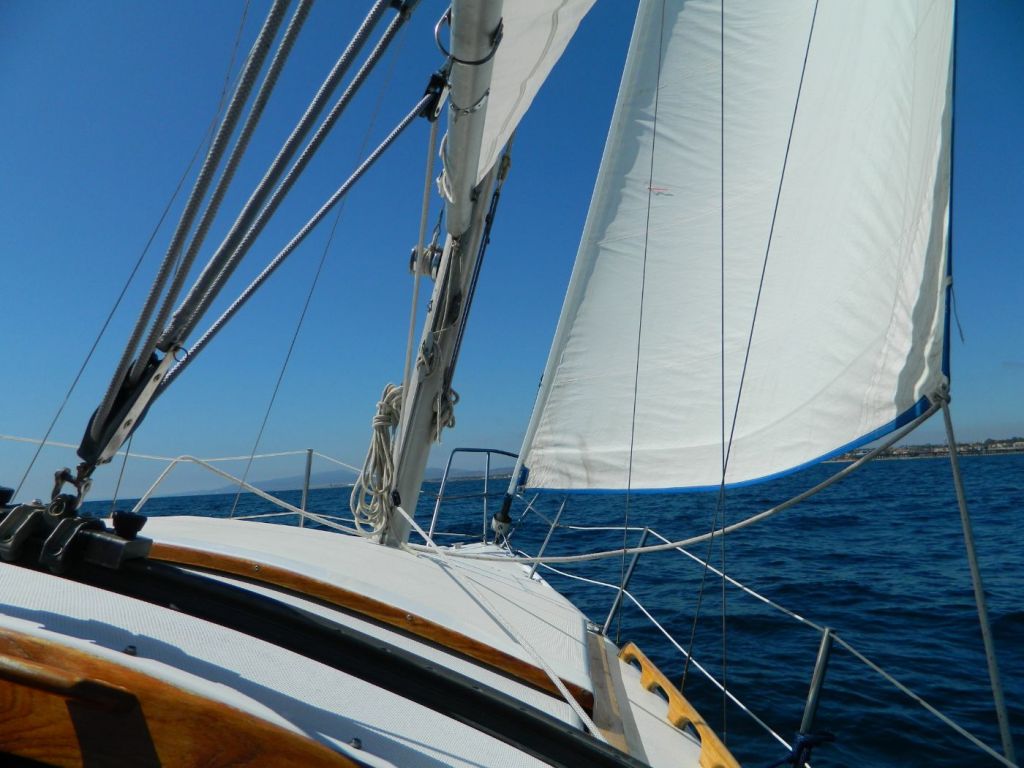
Here are the 15 most common sails:
What a bunch of odd names! Let's see what these mean.
We are starting with the more common types and will go all the way into names you can forget without feeling too guilty about it.
These days, only five or six types are used in the majority of sailboats, with the rest being nothing more than a nice-to-know party trick.
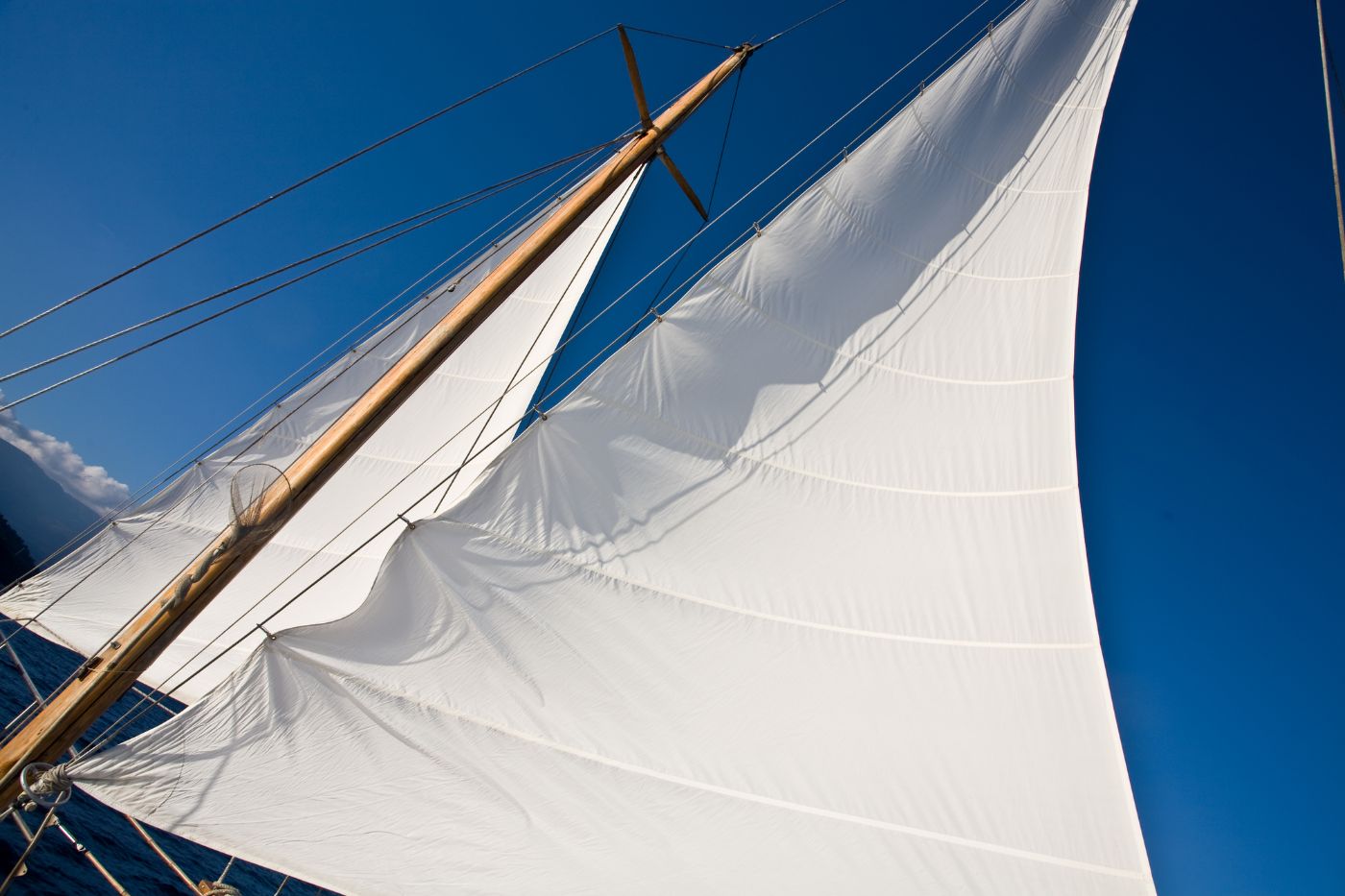
This one is easy. On the most common sailboat type, which has one mast, the mainsail is the one that goes from the mast to the back, attached to the boom on the bottom.
It is usually the largest one. When furled in, they are either stored in the mast, inside of the boom, or they sit right on top of the boom.
Their biggest advantage, and the reason why they are the most prevalent type all-around, is that, thanks to their design, they allow you to go anywhere, regardless of where the wind is coming from. Except for the ninety or so degree angle into the wind.
Just to make this complete, on older, classical ships with square sails and several masts (the ones you see in Pirates Of The Caribbean), mainsails are the bottom back ones. Nothing complicated here. Let's move on.
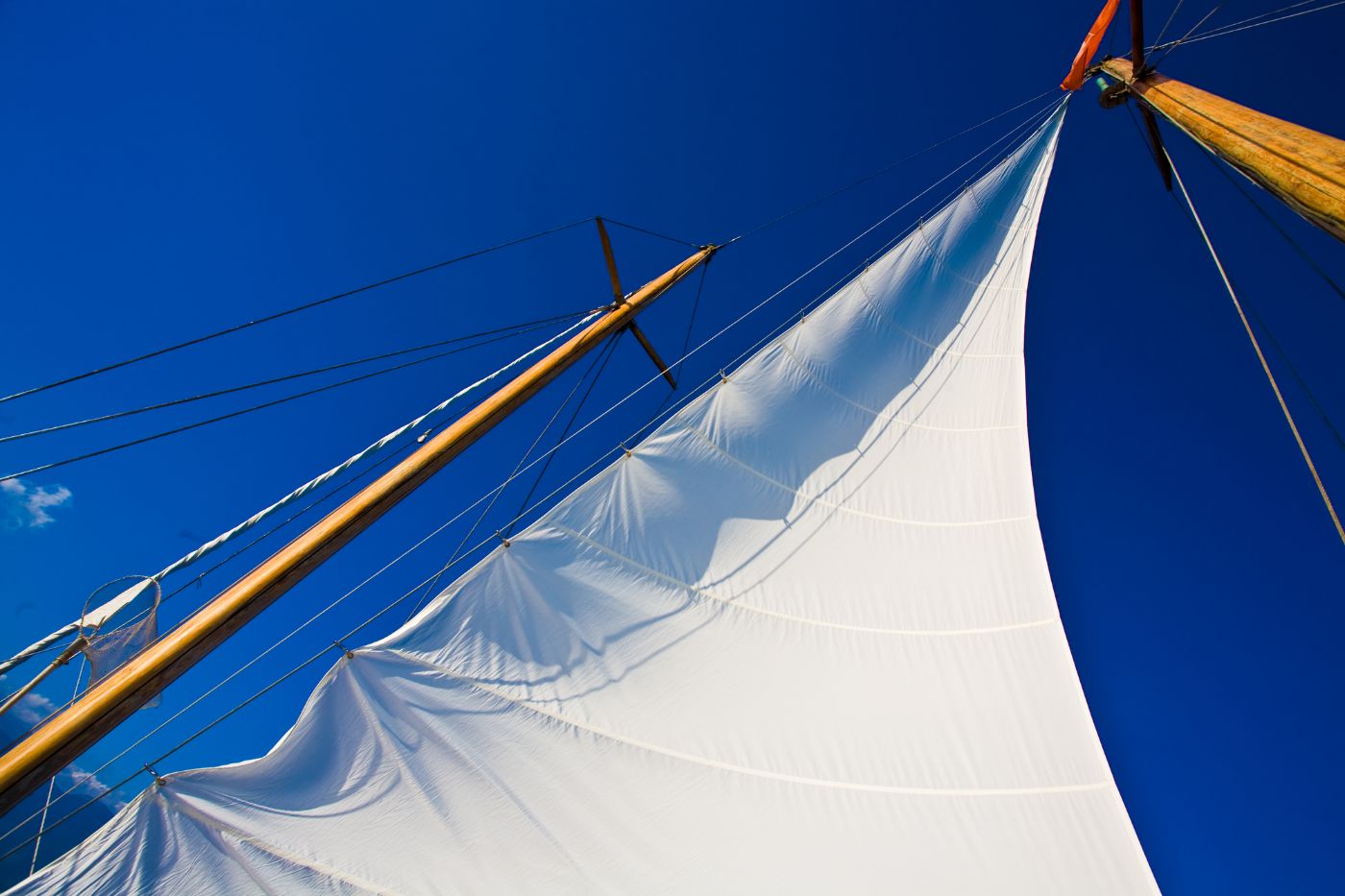
Again, you will see this one around a lot. On the most common sailboats, the term foresail refers to the front sail, which is attached to the boat's bow and mast.
It is usually rolled in the roller furling or attached to the forestay via little snaps called 'hank-ons.'
If you stumble upon the term 'headsail' or simply 'front sail,' know it is just a different name for the same thing. Oh, and on the aforementioned pirate kind of ships, the foresail would be the bottom front one, rectangle-shaped.
Foresails tend to be smaller than the mainsail, but the size isn't necessarily a disadvantage - if you find yourself too overpowered by the wind and you have already trimmed your mainsail, the foresail's smaller surface area can come in handy since the wind won't impact it as much.
You can even sail with just the foresail up. And if you aren't using hank-ons, but a roller furling, trimming it is quite effortless.
Foresails come in various shapes and sizes according to what type of a foresail it is - let's see what these are called.
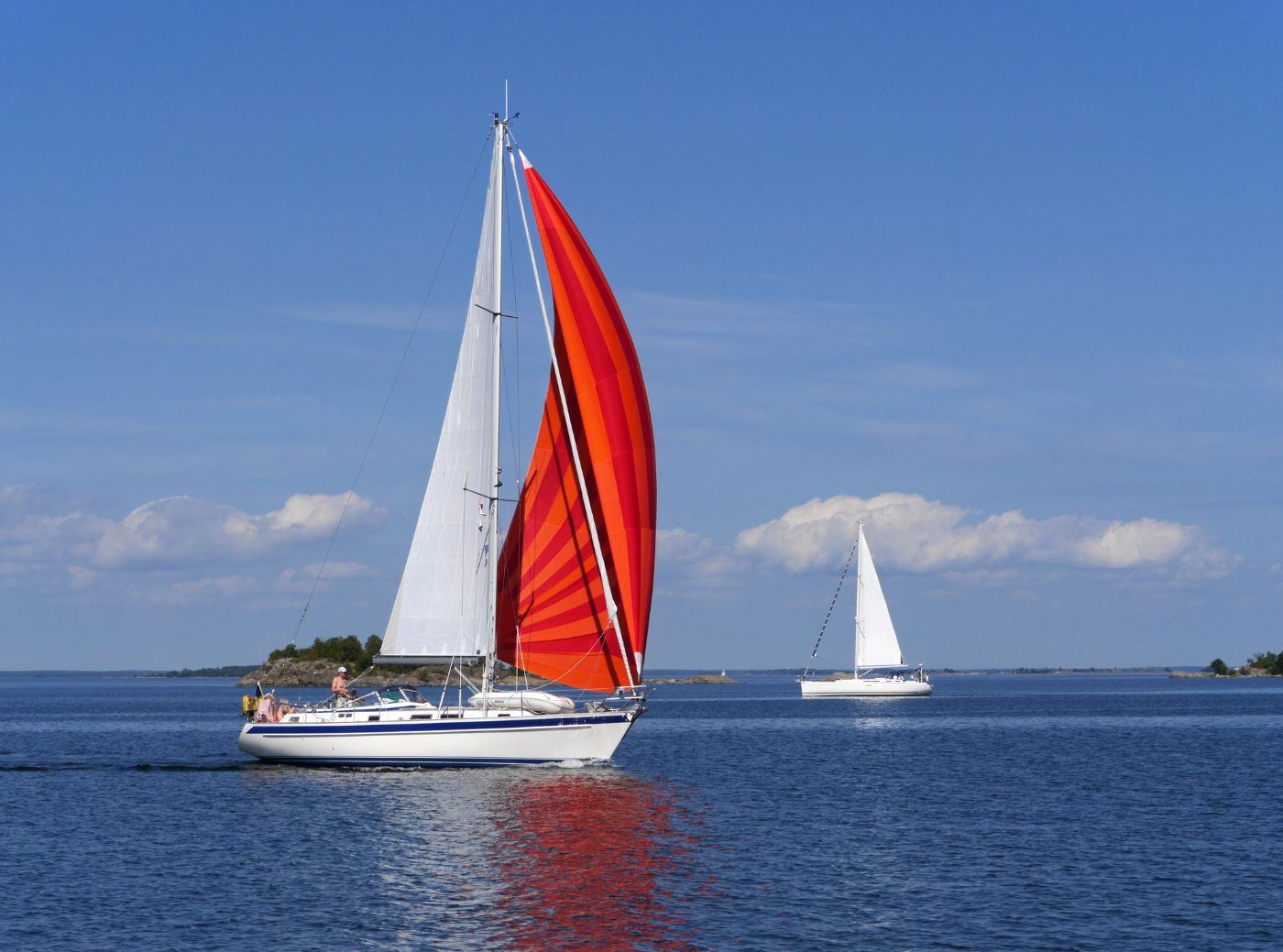
This is a foresail that extends beyond the mast. Meaning its bottom side starts all the way at the boat's bow and ends behind the mast. This gives it a larger sail area, resulting in more speed, that's why these are popular with racers.
But tacking with a genoa can be a bit annoying since you have to drag it across the mast. And it tends to get stuck in the most inconvenient of moments. Having to climb to the mast right as the boat starts to heel from one side to the other and the foresail is flapping around like hell isn't fun, I could tell you stories.
Now, how much the genoa extends behind the mast differs, from a common 110% type (meaning circa 10% of the genoa is behind the mast), which you would find on many cruisers, all the way to the 180% type. The latter is quite uncommon, though, because around 150%, the genoa starts to be in the mainsail's wind shadow.
An alternative name for a genoa is an 'overlapping jib', so if you stumble upon that word, know it refers to the same thing.
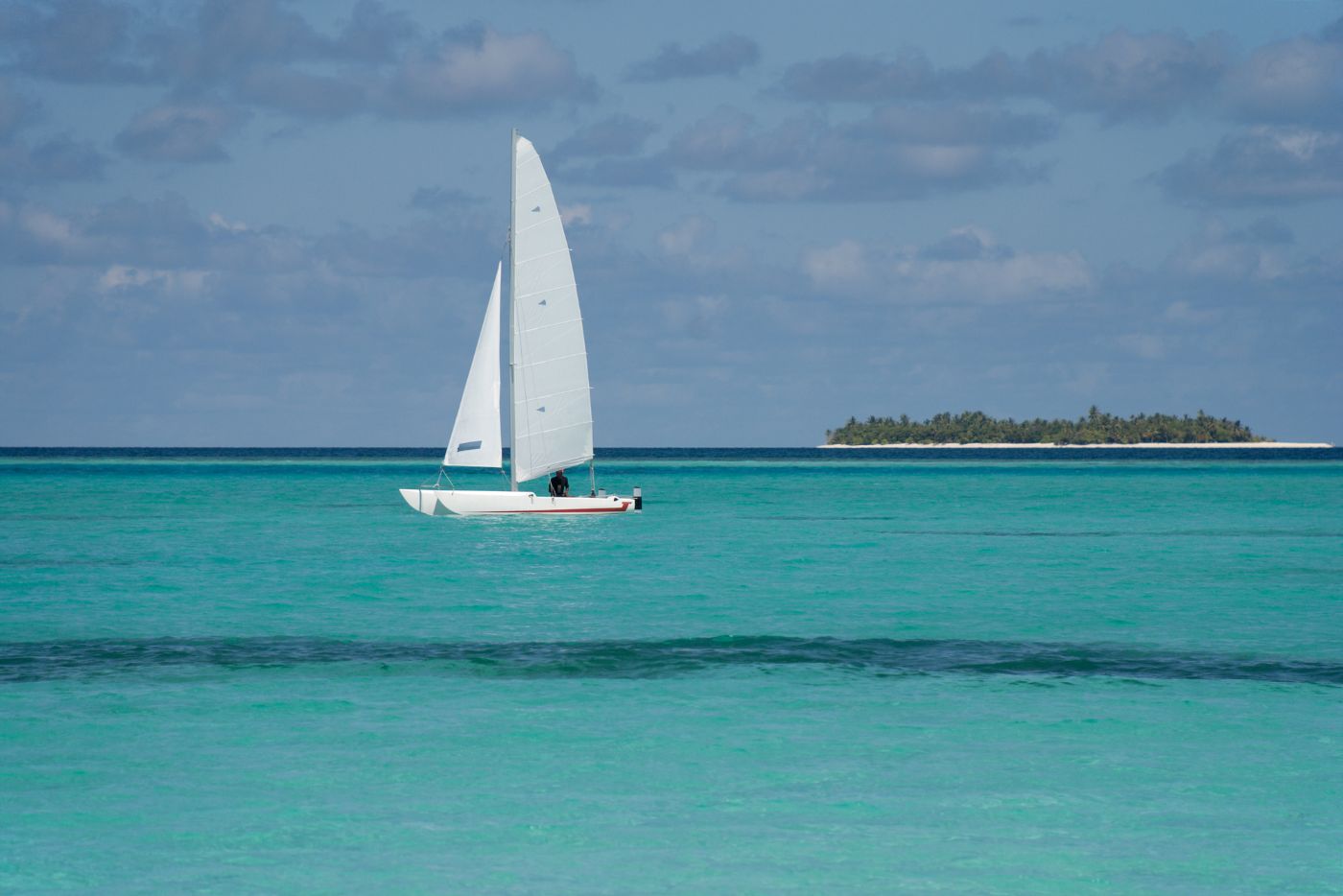
Imagine the jib as a genoa, but smaller, meaning it doesn't overlap the mast as genoa does. You will, of course, get less performance out of this setup, but the handling is easier, and since when tacking, the sail doesn't touch the mast, you can have a self-tacking system, a great thing for short-handed trips.
Speaking about performance, interestingly enough, it doesn't add as much in terms of propulsion as you would expect, but rather helps the airflow around the mainsail, helping it to function more effectively.
They are quite prevalent on modern holiday cruisers that prefer convenience and ease of use over the few knots of speed you would get from a large foresail.
You might come across the name 'windseeker', which is basically a very tall and very narrow jib, made from a light fabric - very useable in lighter winds since it can help you pick up speed even if the breeze isn't as strong.
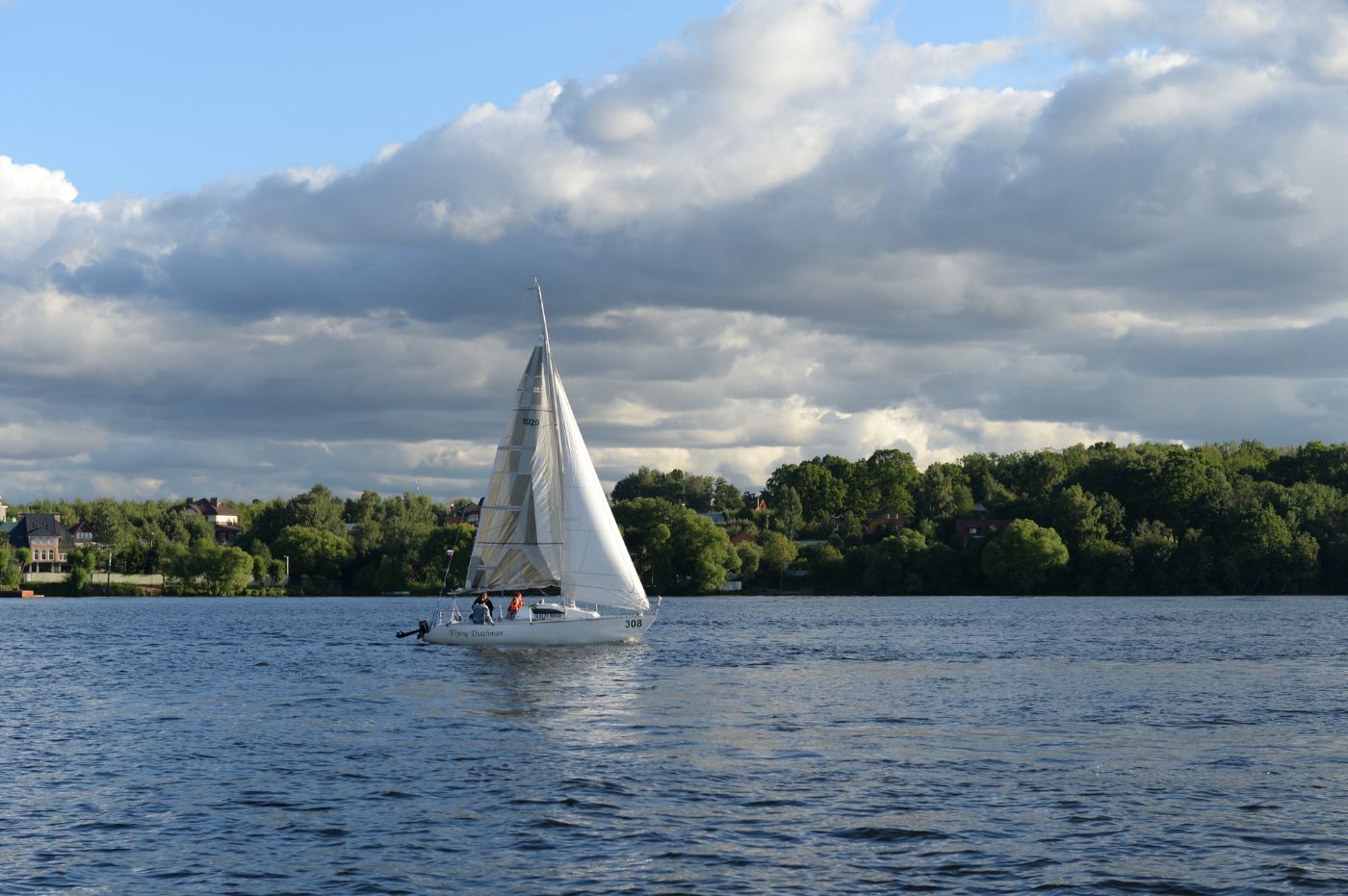
This one's a bit tricky - the term staysail refers to a bunch of different sails, usually such that complement the already existing system. This could, for instance, be a forestaysail, a smaller jib positioned closer to the mast, not as tall as the foresail.
Having two sails in the front like that gets you more speed and having one closer to the mast helps to maneuver it in heavy weather since you don't have to go as far.
That is convenient, especially in rougher seas, where the very front of the deck gets hit by waves often, and so having to go all the way there to tweak a sail can present challenges.
Also, just as was the case with the jib, staysails are sometimes used to help the airflow around the mainsail, rather than generate speed on their own.

Spinnakers are really pretty. They are humongous, parachute looking sheets used mostly for when the wind blows from generally the back. Their large area allows them to pick up a lot of wind, and so can add a lot to your speed, even in light winds.
There are symmetric spinnakers, that are, well, symmetrical in shape, used for the aforementioned back winds, and then there are asymmetrical ones, used more like a genoa, generating lift, for different wind angles.
And by the way, remember that rule saying you can't capsize a boat with sails only? Because the steeper the angle, the less the wind power and the boat will then correct itself?
Well, with spinnakers, forget that. If not manipulated with caution, they can have you go down quite easily. Use them with lighter winds.
Don't know how to use a spinnaker? Read our guide on how to set up and rig a spinnaker here.
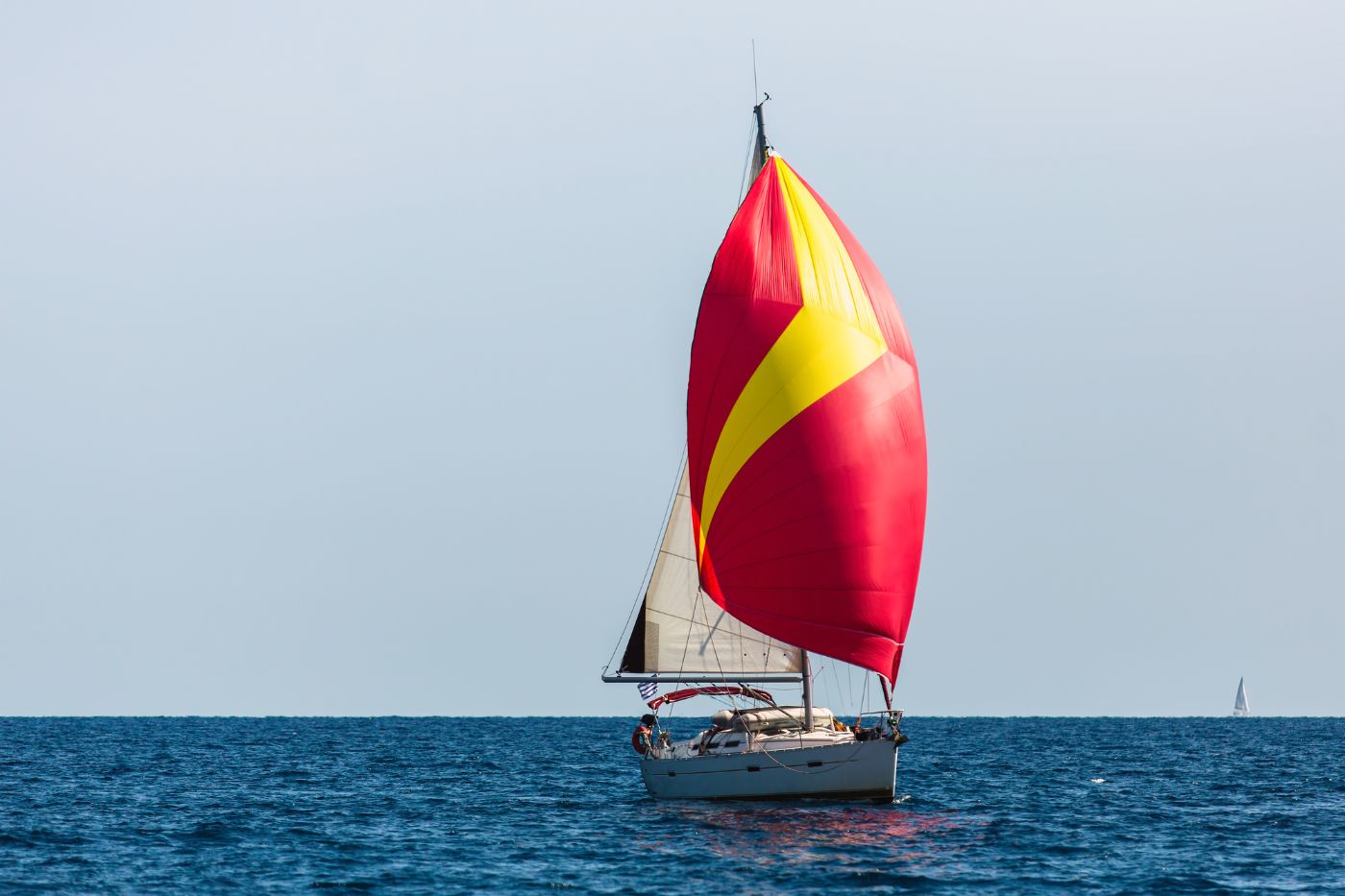
You might also come across its more badass name 'code zero', which is a sort of a mix between genoa and a spinnaker, used for close reaching. It's a relatively new invention, thought into existence in the 1990s.
Its asymmetric geometry makes it more immune to collapsing than a classical spinnaker, of course, for the price of less volume. You will find this one mostly on racers. For a cruiser, this would generally be an overkill.
Read more on the exact differences between the Gennaker and the Spinnaker here.
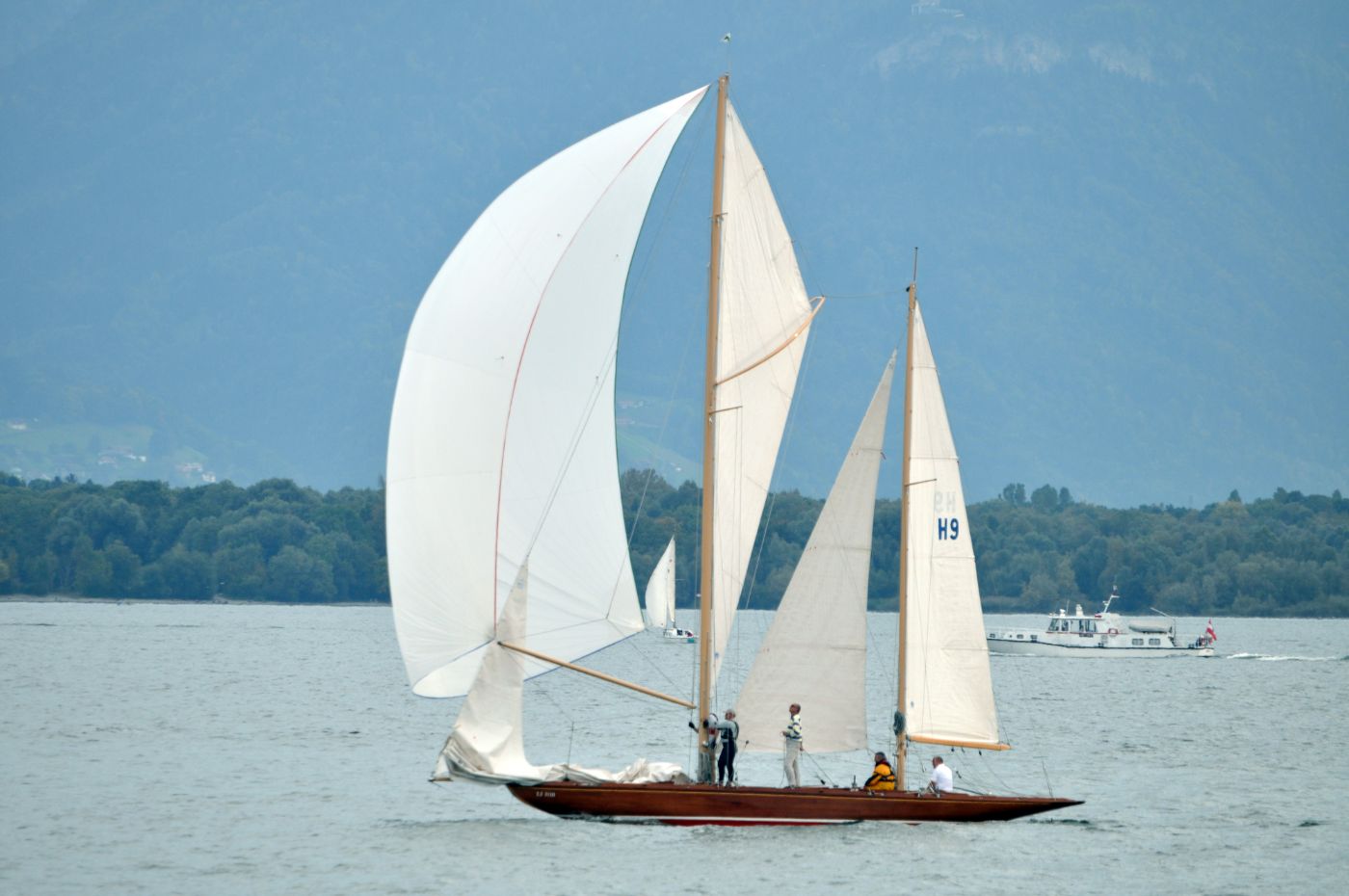
These aren't as common. The term doesn't refer to a specific shape or placement of a sail, but rather generally to smaller sails that are found at the boat's stern, behind the mainsail. So you won't find it on sloops (the most classical sailboat type), but you will on ketches (two-masted sailboats).
The reasons for its existence are multifold.
Firstly, it allows for a smaller headsail while keeping the overall sail area. The smaller headsail is easier to operate, so this is a matter of convenience.
Secondly, a sail in this position can serve as a sort of wind rudder, helping the boat keep its direction. Some people even keep them up when anchored, to make sure the boat keeps pointing in the same direction.
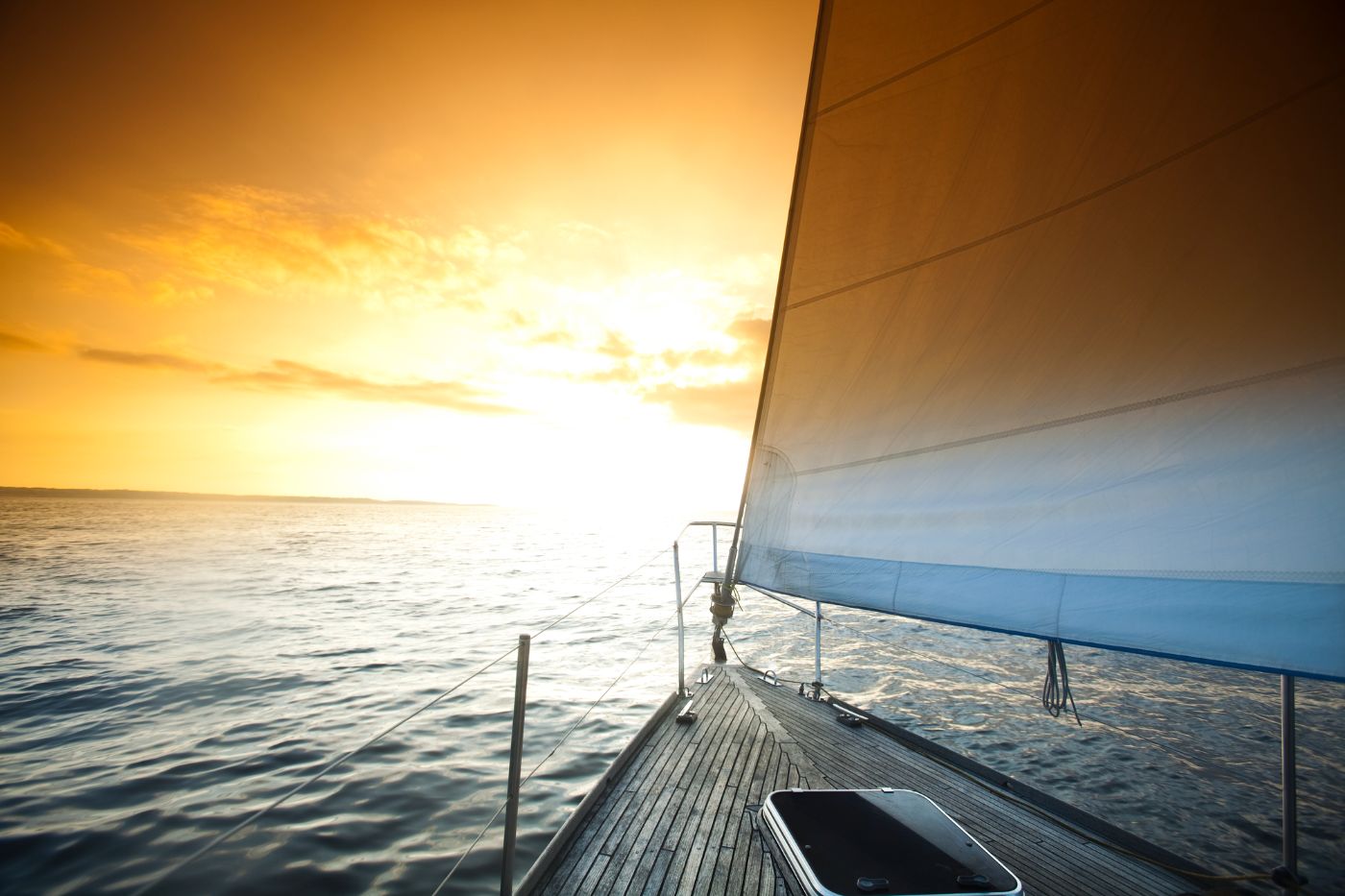
This is a weird one. Lugsails are sails that hang from a sort of a boom, called a 'yard'. Smart people thought of these as an upgrade from the classical traditional square sails - lugsails are easier to angle and thus perform better windward.
You remember those small fishing boats with a mast, boom up top, making it look like a cross and the sail being attached to it? That's the one I mean. These sails had their prime time around the eighteenth century (give or take one) and, fun fact, given their good performance, were popular among smugglers.
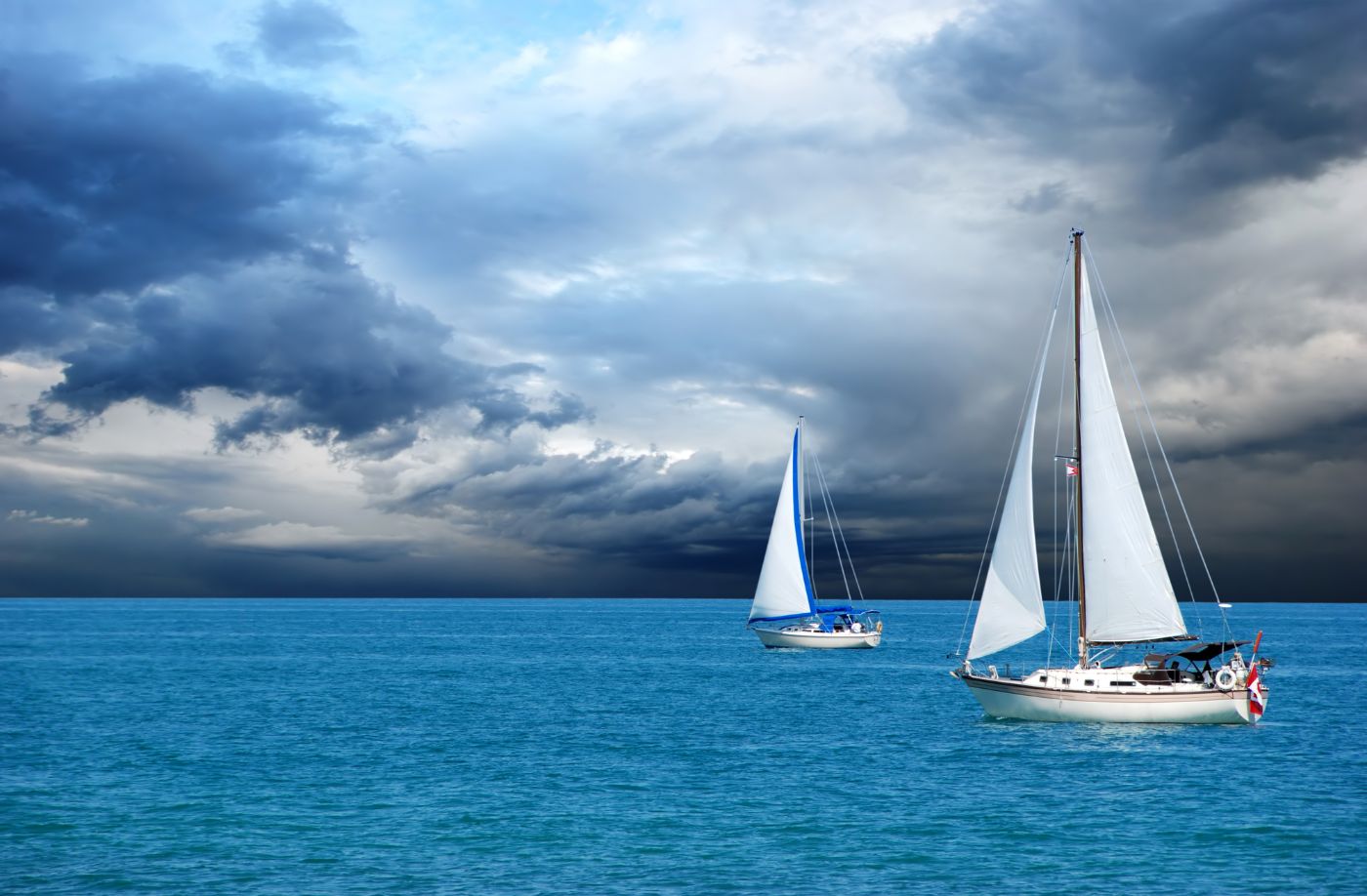
As the name suggests, these are used for storms. There is a storm jib (storm version of the front sail) and trysail (storm version of the mainsail). In essence, they look quite similar to your normal sails but are smaller. Way smaller. When in a storm, you want to keep the sail area quite tiny to cope with the strong winds.
Now, why not just reef your normal sails and keep on going, you might say? Well, you could. Up to some 30 knots, this would work. Not very well - there will be a lot of draft in the sail, and you will heel a lot - but it does the trick.
However, above 30 knots or so, you are risking damaging your sheets. Classical sails are made out of rather light fabrics that aren't likely to withstand a proper blow, unlike the tough storm sails.
They are also brightly colored so that you can see them better and are positioned higher, to keep away from the sea.
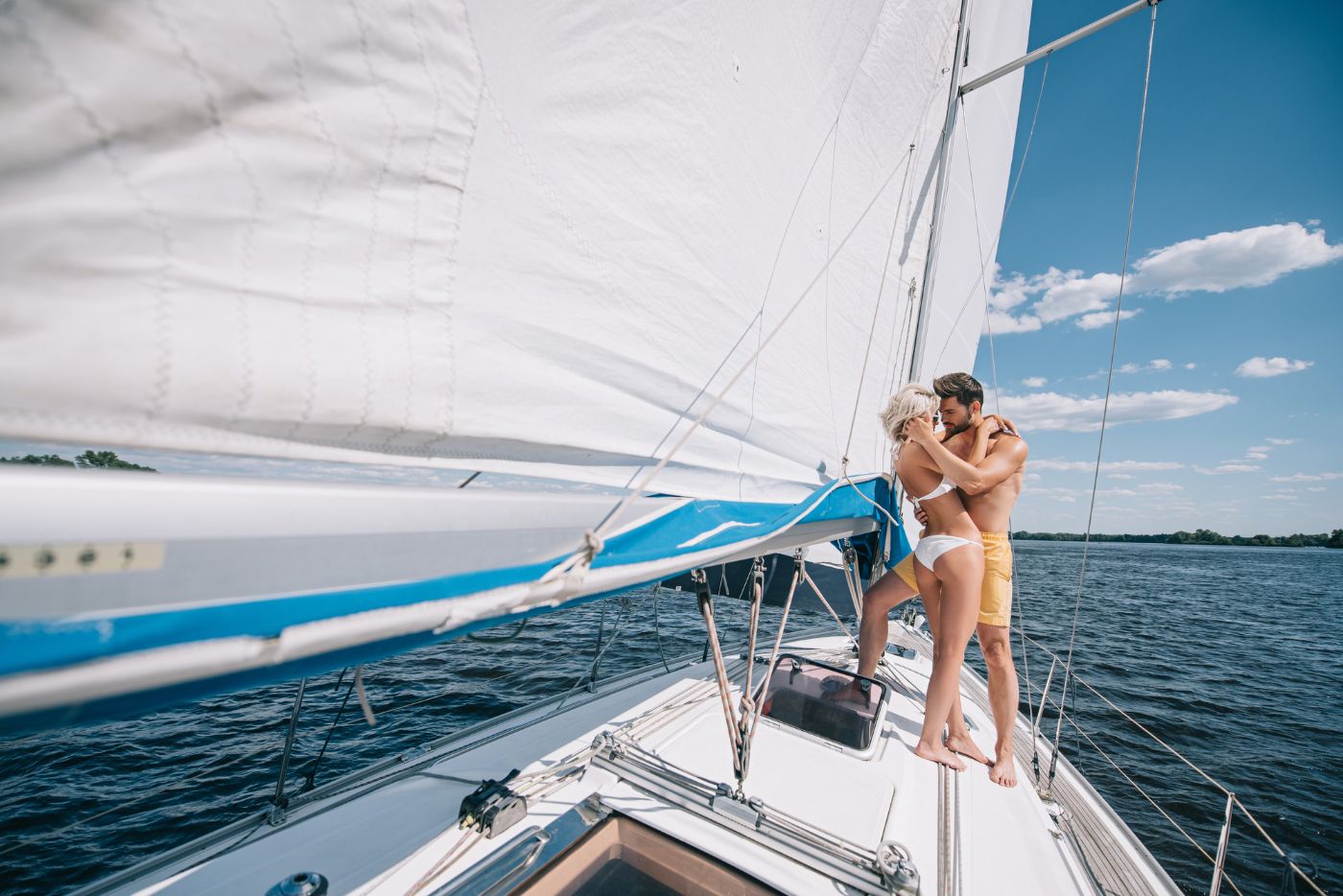
As old as the second century BC, spritsails are four-sided sheets that are supported by a diagonal boom of sorts, called sprit. Why this odd shape? For one, it is a great concept for cargo ships.
The sail's design doesn't obstruct whatever you have onboard, even if it is stacked quite high.
Spritsails are a feature of older, traditional boats, so you won't likely see them around these days much, except for some smaller dinghies, who may still use them.
They have been surpassed by more convenient designs. But if you do happen to stumble upon one, take it in, you are witnessing an important historical chapter.

Back to the Pirates of the Caribbean ships - the four following sails are those found on the old, classical ships. They are the four (although sometimes you see even six) square sails set above each other, getting progressively smaller, the higher you go.
Let's start with a topsail. It is, unlike what you would expect from the name, not the one on the top. Rather it is the second or the third one from the deck.
These once used to be the most important sails on a ship. This is because they were quite high above the deck, so the wind up there was likely to be more constant than below (especially with larger waves) and also because of their large size.
In fact, sometimes boats would just have the topsails opened, sailing with them alone.

Royals were usually set above the topsails. They were smaller and made for rather light winds. Because such a setup required a tall mast, you would find these on big ships. Not much more to say here.
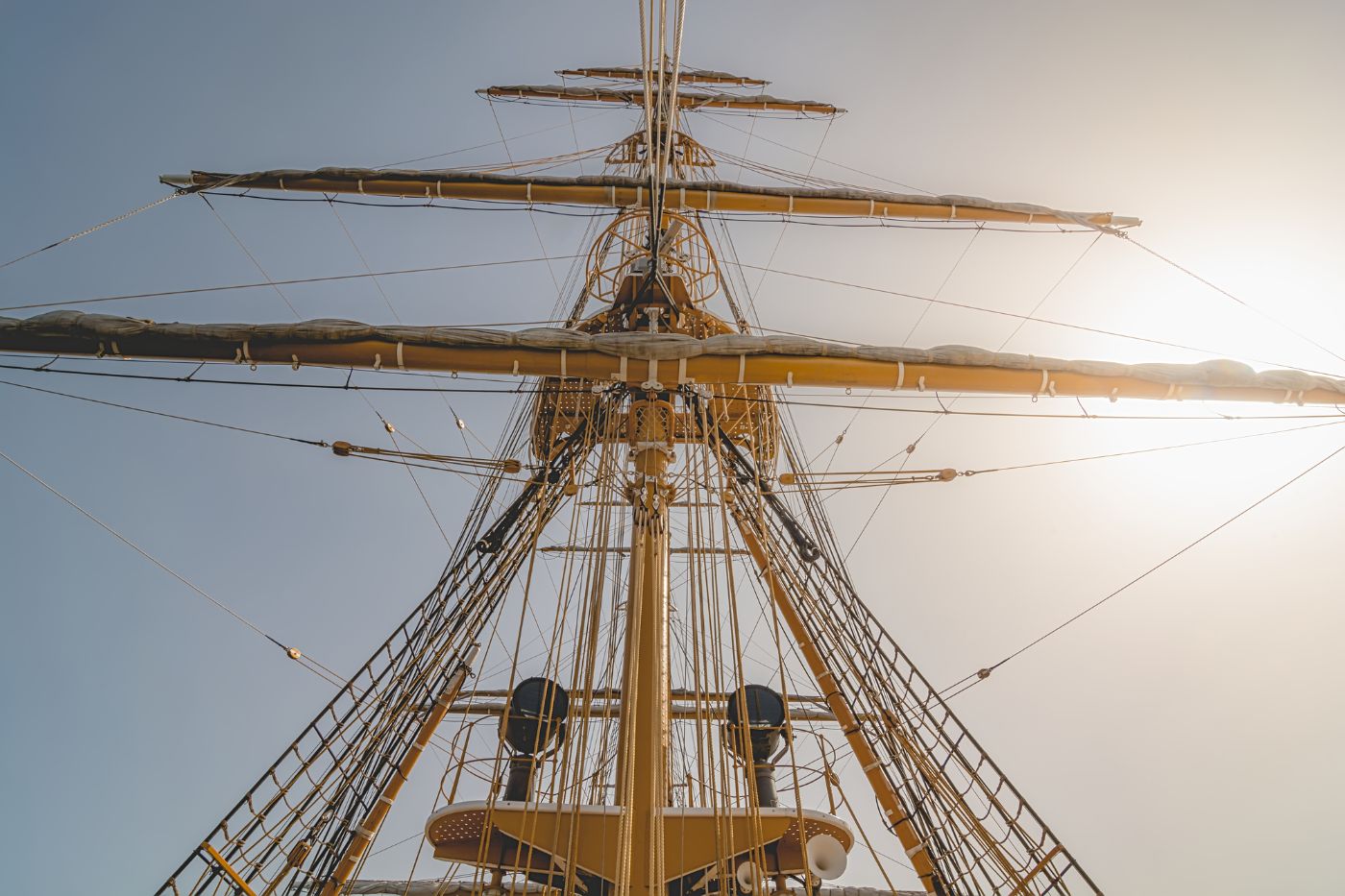
Again, a misleading name. You would expect it to be on top, but it usually sat right above the royal. And just as royal, it would be used in lighter winds.
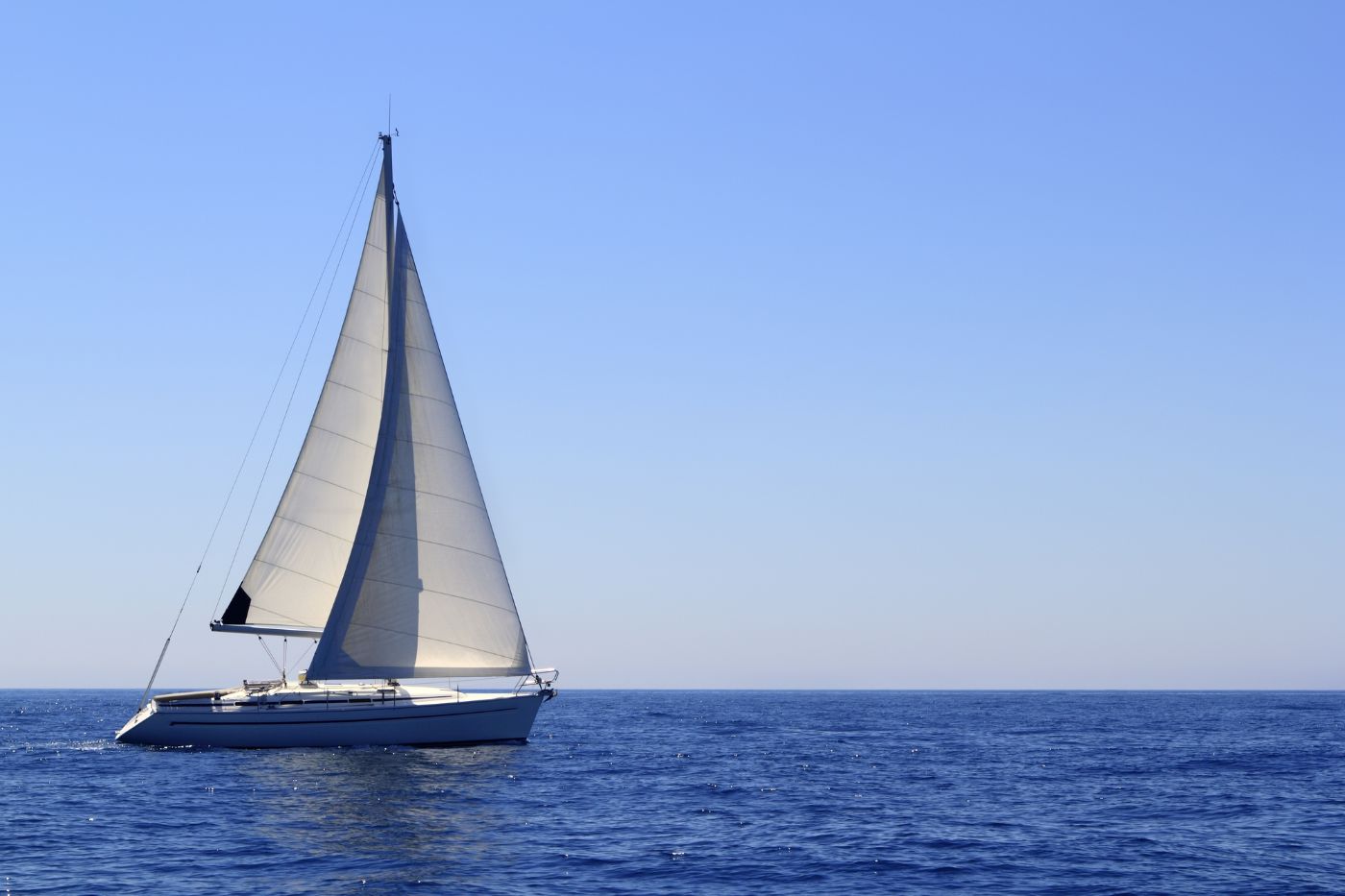
This is the top one. Moonraker was the smallest in size of the square sails and was sitting at the uppermost point of the mast. It was not that prevalent, since only boats designed for speed featured these. On rigs featuring triangular sails, it would be called a skyscraper.
So there you go. I hope I haven't confused your minds more than they were getting into this article. If you want me to make things easier for you, let me be honest - know that for most sailors, mainsail, genoa, and jib, with the occasional spinnaker, is all you need. I know, I know, many of you are now rolling their eyes - but let's be frank here - go into most marinas around the world, and these four are all you will see.
Fair winds!
Tom Schlosser
Well done, matey.
—Tom SCHLOSSER “All I need is a tall ship and a star to sail her by.” John Mansfield’s poem “ Sea Fever ”
Leave a comment

Trusted by YouTube’s Largest Sailing Channels
Sailing for a living requires sails that work. These inspirational sailors put hours on their sails in remote locations and put their trust in Precision Sails.
Custom Designed Sails
Designed for your boat, your sailing area, and the type of sailing you do. Over 15,000 Sailboat Rig Specs on file.
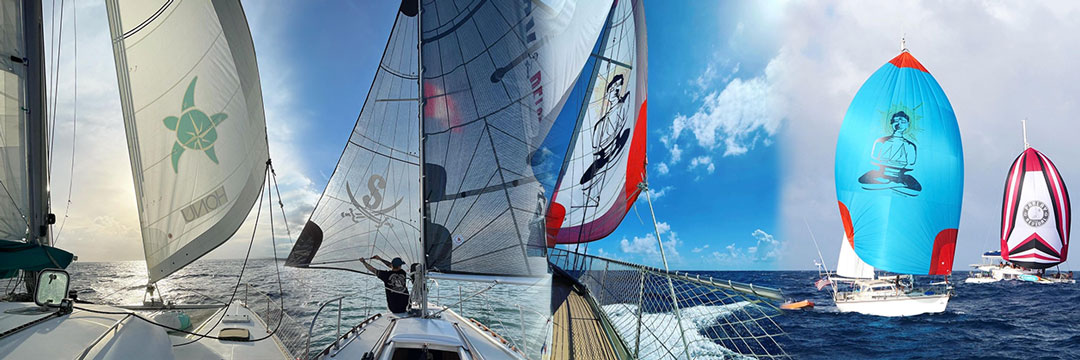
Any Sail That You Need
Mainsails, Headsails, Asymmetrical Spinnakers, Symmetrical Spinnakers, Gennakers, Code Zeros – we have it all!
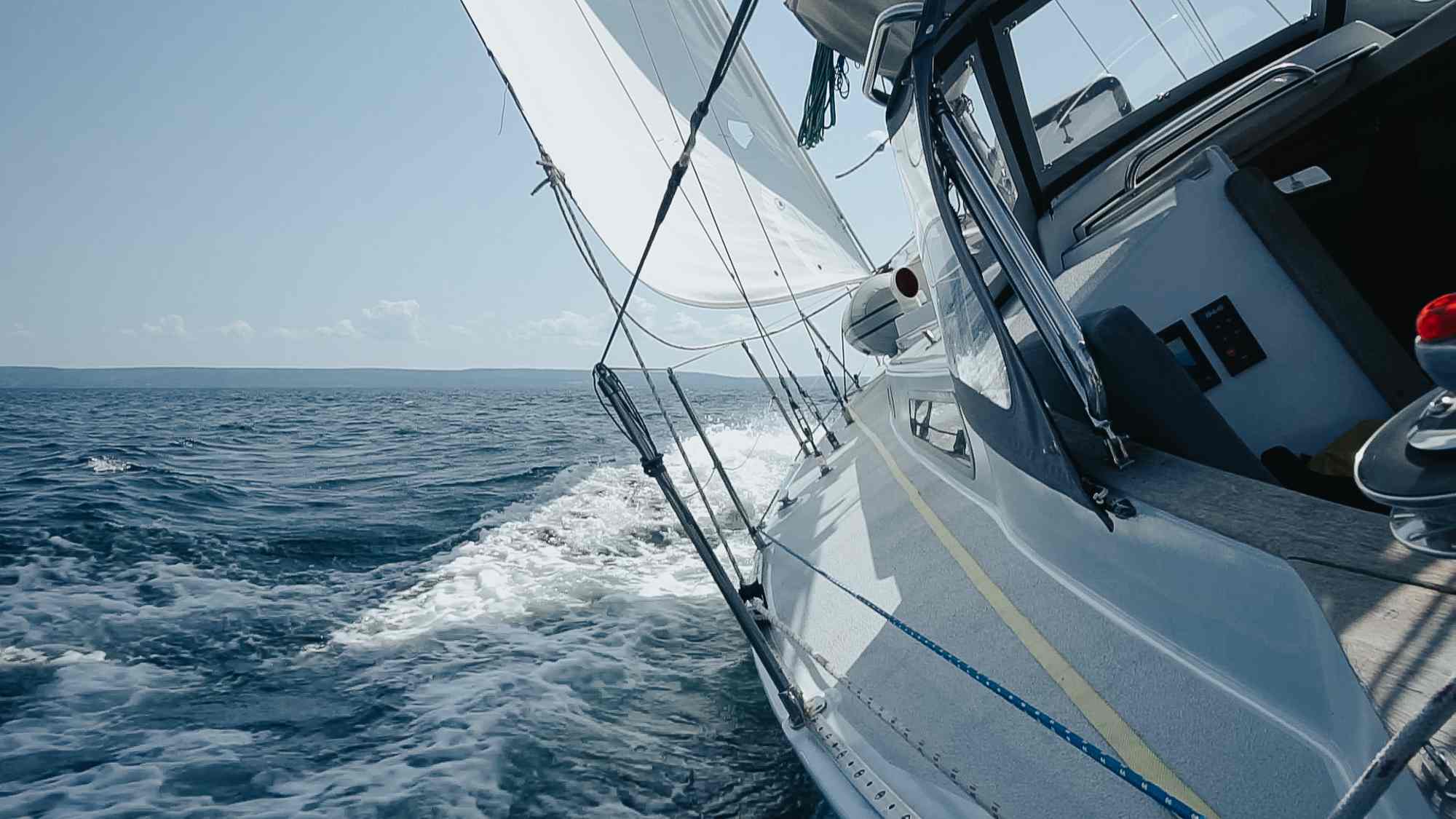
The Largest Sailcloth Selection in the Industry
With the widest selection of sailcloth available in the industry there is always a cloth suited for you. Let us help narrow down your options.
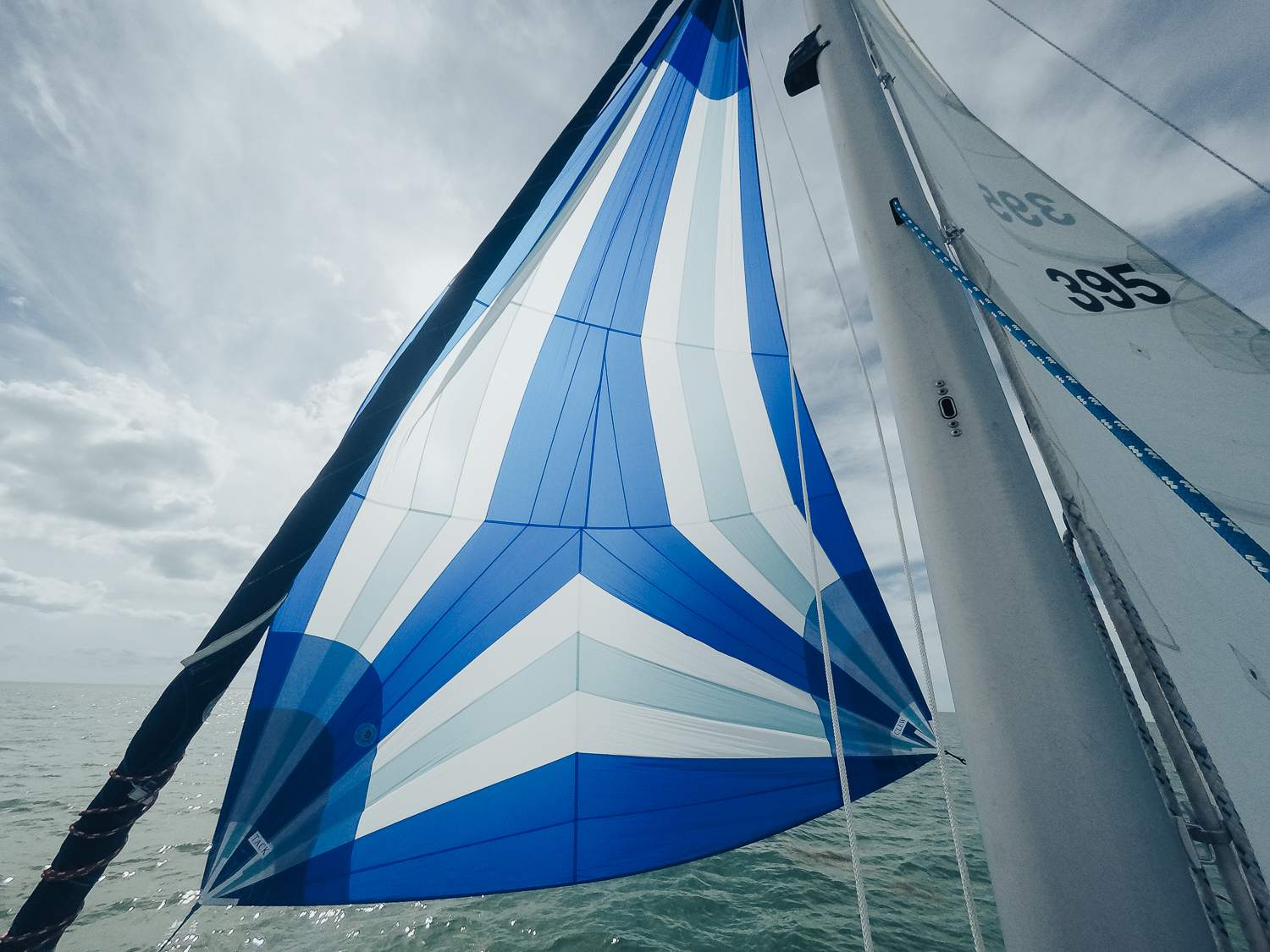
Perfect Fit Guaranteed, Every Time
Every step in our process is focused on ensuring the highest quality and satisfaction for our sailors. Smooth sailing is guaranteed with our innovative approach to production and our exceptional warranty coverage.
Mon-Fri: 8:00am to 4:00pm PST [email protected] – This opens in your default email application 1-888-958-5638 – This opens in your default telephone application
Educating & Consulting to Ensure You Get What You Need
Sails are the main propulsion force for sailboats. Unfortunately, most sailors don’t replace their sails often enough. This can lead to the assumption that purchasing new sails can be overwhelming and confusing. Precision Sails takes a new approach to the sailing industry by helping you choose what sails and sailcloth is best for you, your sailboat, the type of sailing you want to do, and the area in which you are sailing. We offer industry-leading transparency into what sailcloth is available worldwide and the importance of sail design to your sail’s performance and lifespan.
Our website is filled with educational resources related to cloth, design, and technical sailing knowledge. Our team of sail consultants is always available to walk you through the options and help you choose the sail that is right for you.
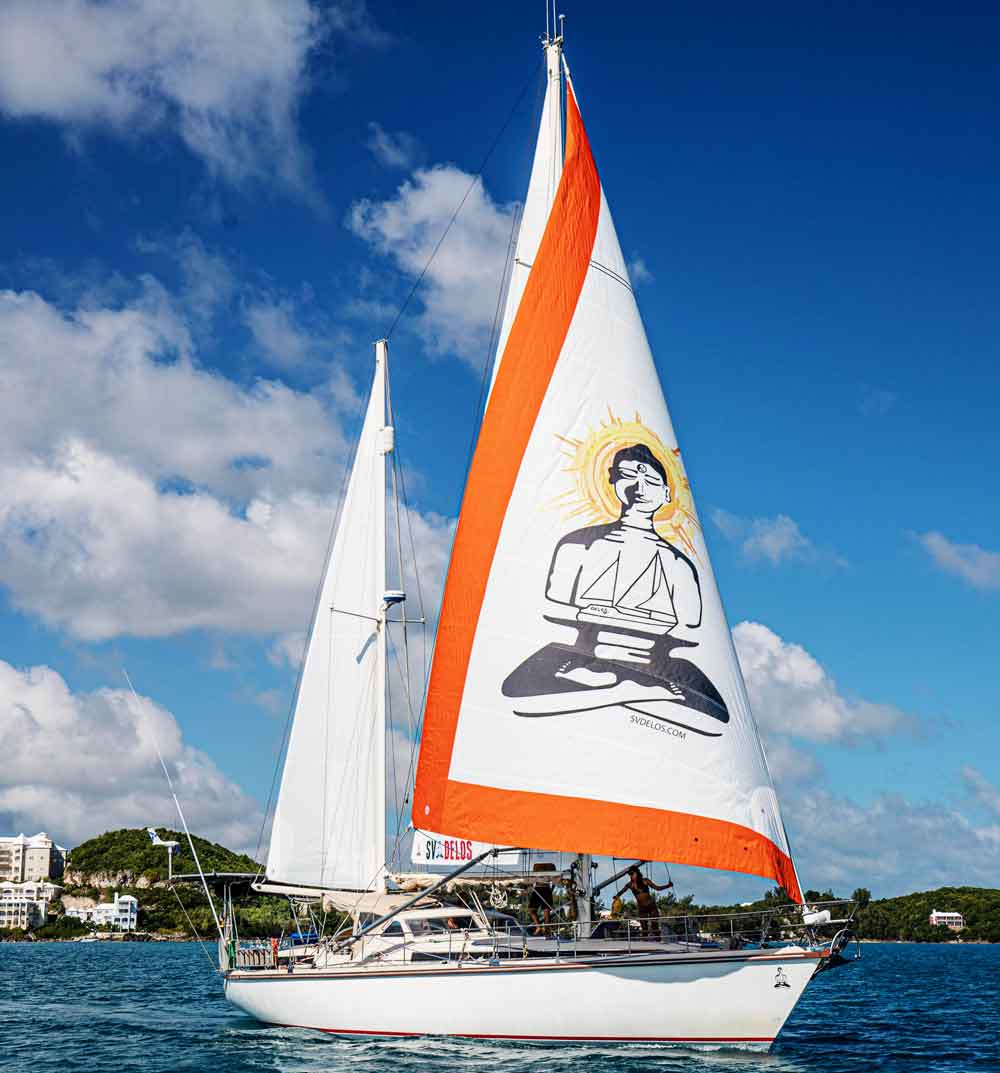
Perfect Sails Start With a Perfect Design
In order for a sail to fit and perform it needs to be designed properly. While other lofts are contracting sail designs to third-party design services, Precision Sails is building its in-house design team in Victoria BC, Canada, to work directly with sailors to ensure your new sail fits perfectly and performs the way that you want it to. Using the most modern 3D sail design software our design team will customize a sail that not only fits your rig as she sits in the water today but ensure that your sail fits and performs for years to come.
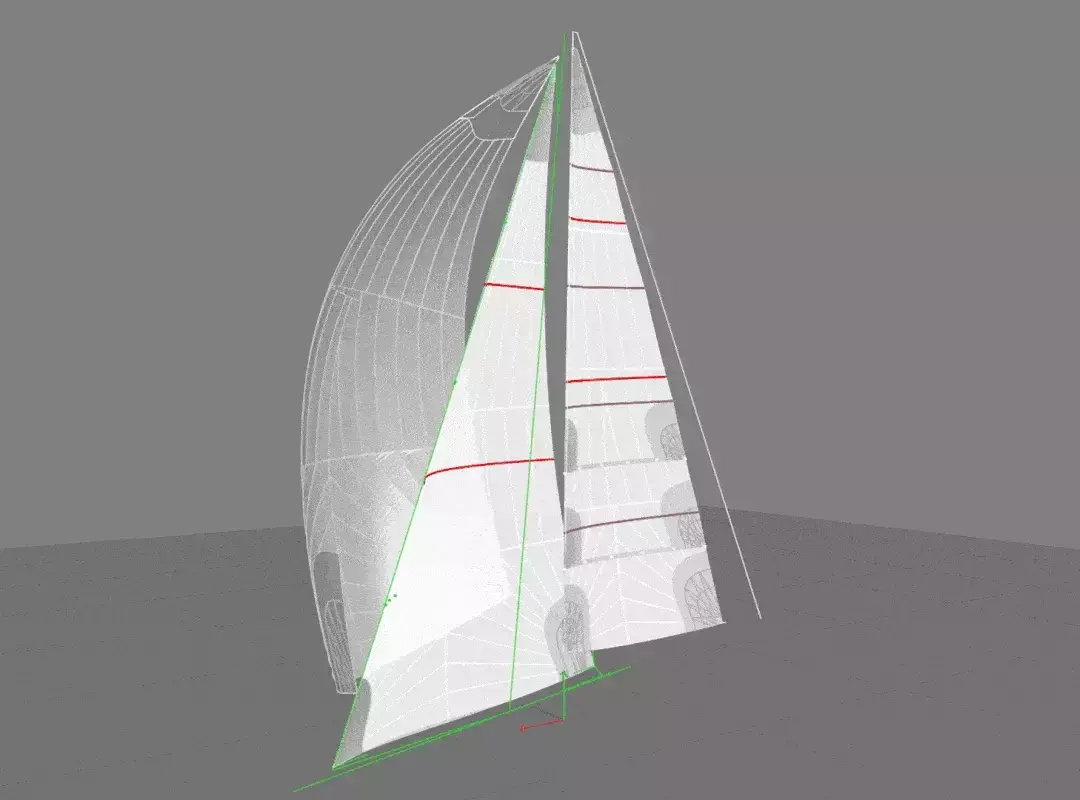
100% Fit and Performance Guarantee
Buying a new sail is a big investment. Precision Sails offers its 100% Guarantee so all our sailors have the confidence that Precision Sails has your back. Accidents are rare, but they can happen. If your sail does not fit or perform to your satisfaction your sail will be redesigned and rebuilt. As experts in our craft and with the confidence we have from supporting thousands of sailors worldwide, our team is proud to boast the widest covering sail warranty in the industry.
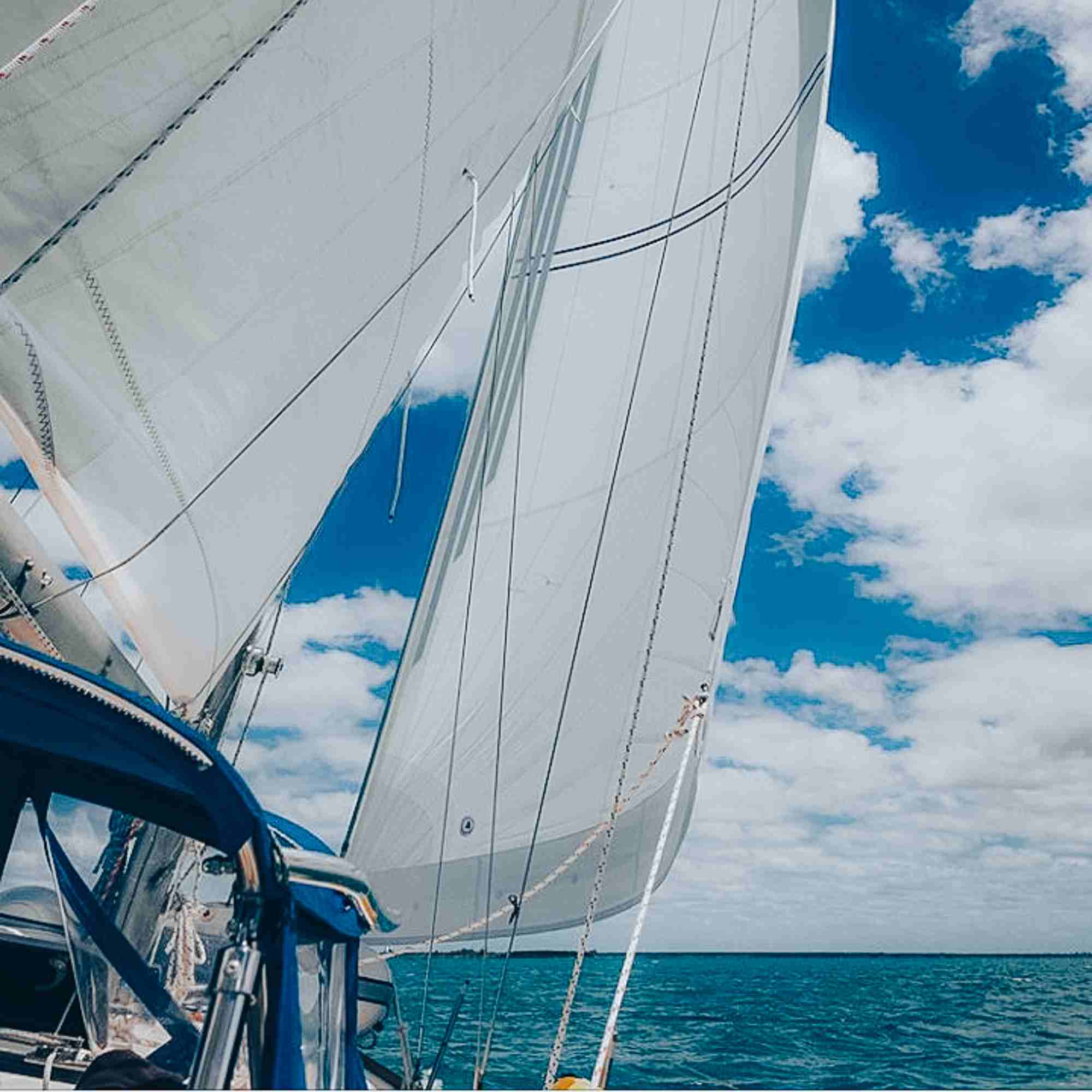
Leading the Industry in Sailcloth Options
Sailcloth manufacturers offer many different types of sailcloth in multiple different quality levels. There is always sailcloth available that will meet your sailing needs as well as your budget. Precision Sails offers all sailors full transparency into what sailcloth is offered and from which manufacture. Our team is here to help select which cloth is best suited for your sailing needs.
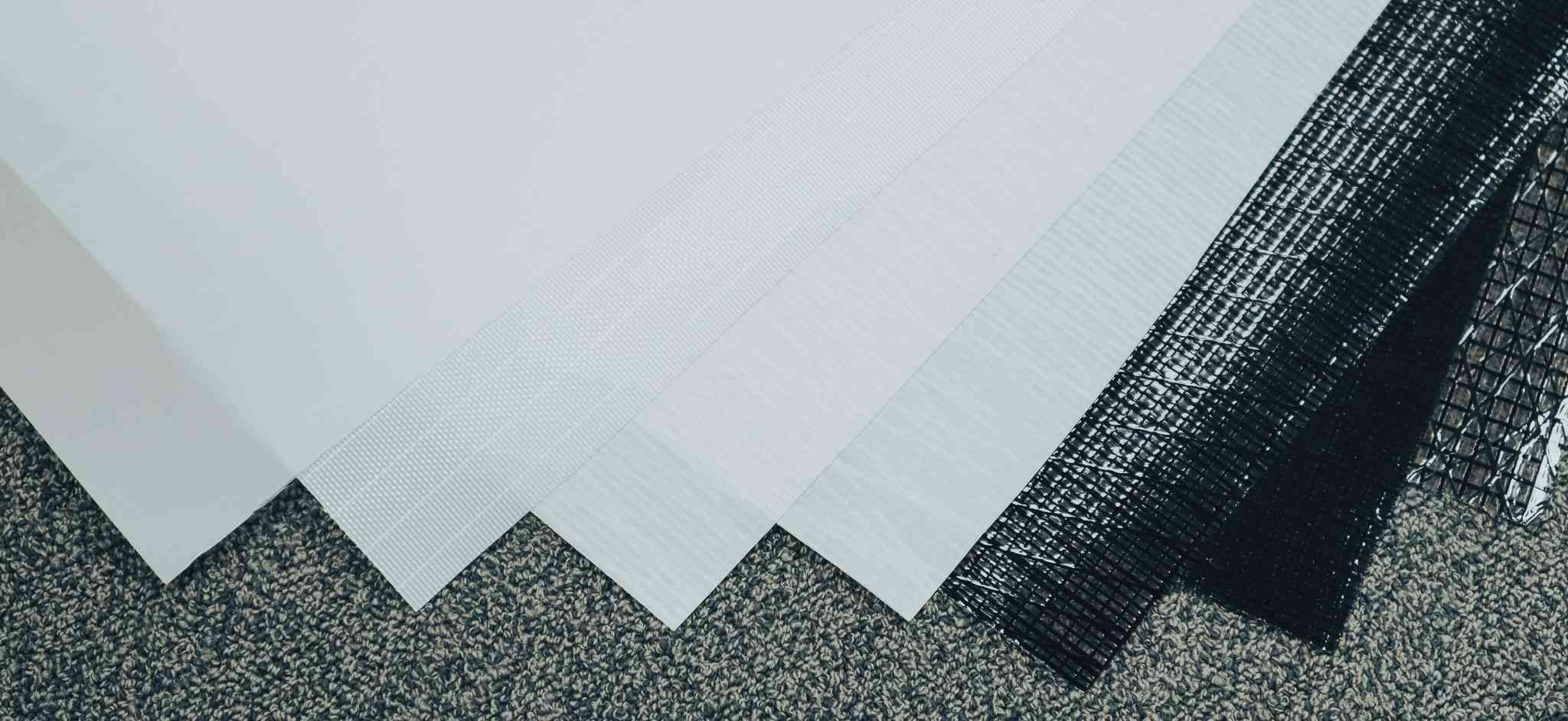
Our Partners
Precision Sails is proud to partner with these amazing sailors documenting their adventures. These sailors inspire new sailors and weekend warriors alike to learn how to sail, sail more often, and sail further than ever before. If you are looking for some inspiration to cut the lines and sail away make sure to help us support these creators by watching their episodes.
Learn More About Our Partners

Find your Sail
Your perfect sail is out there and Precision Sails is ready to make it for you. Request a quote for a sail and we’ll be in touch shortly.
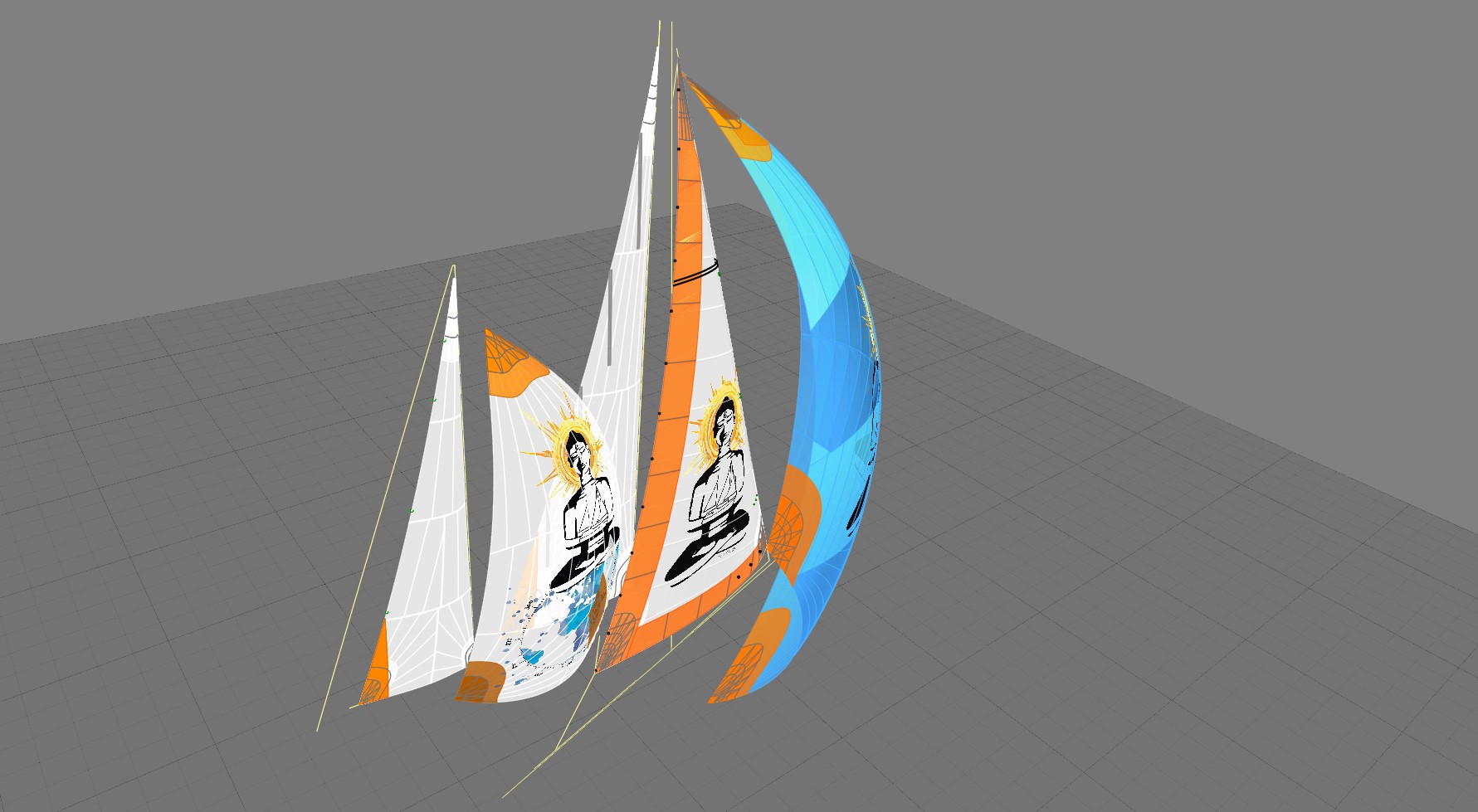
Types of Sails
Precision Sail Loft specializes in producing headsails, mainsails, spinnakers, gennakers, and code zeros. So no matter the type of sail you’re looking for, we can help. Our sails are trusted by cruisers and racers alike from around the globe. Review the sail options and craftsmanship available to customize your dream sail.
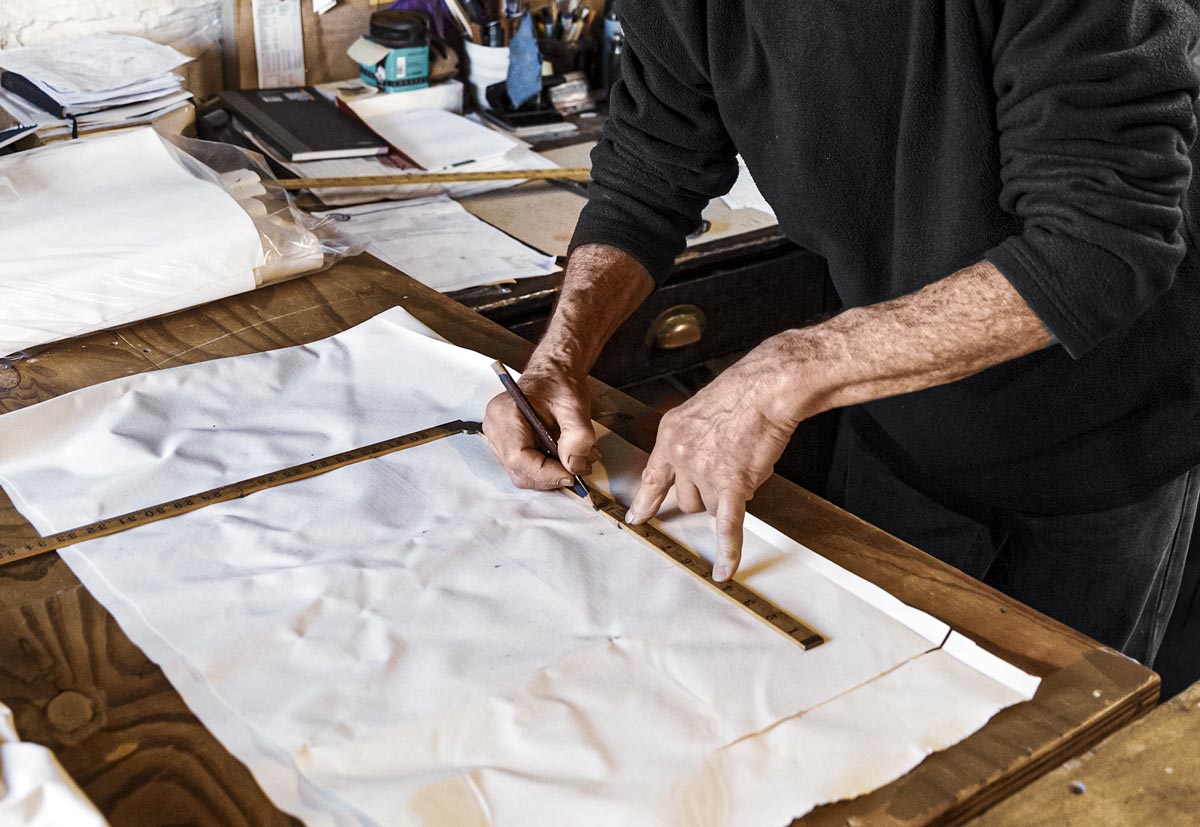
Build & Process
Every sail we craft is produced to the highest standards with the best hardware, craftsmanship, and skill-set in the industry. Pair that with Precision Sails’ approach to communication and your sailboat will be ready to set sail before you know it.
What are Sailors Saying About Precision Sails
Precision Sails thrives on communication. At each step from design to delivery, we encourage you to collaborate one-on-one with our expert sail consultants in finding the perfect sail to suit your needs. Don’t just hear it from us. Check out some reviews posted on third-party review sites by our sailors!
“ Thank you for getting the order for my mainsail and stack pack done in time for my summer trip to the San Juans! Really appreciate the effort to get this done. The mainsail fits perfectly, the stack pack works great, so I am an all-around happy customer and will be in touch whenever I need to replace my headsail and Genoa! Calling out Jeremy Roszmann, Trevor Parks, Marc Pettigrew, and Gary Boylan for great customer service. -Andy Koller
“ The new sails look and work great! No issues with the install and went from being last place in the club races to 2nd place (and probably would have snagged first if I hadn’t gotten confused about the order of the marks in the race !) -Eric Van Hensbergen
“ I have had two sails made by Precision Sails in the last 12 months. Both have exceeded my expectations. The fit to the boat and the performance of the sails are exceptional. The sail designer worked with me to make sure the resulting sail fit my objectives. Precision Sails has excellent documentation and videos to assure that your measurements are accurate. The sails are first rate and the price was very competitive. I am a very happy repeat customer. -Terry Noreault (Facebook)
“ I am very happy with the new mainsail you made for my Corsair F24 MK1. I have just returned from a week-long trip with a group of sailors and the performance of my new Dacron main is much better than my old Mylar race sail. -Brent Nielsen
“ I just received my asymmetrical spinnaker, with sock and turtle bag, along with a new 135 Genoa. The entire process was simple and both sales and the design team were in regular contact if there were any questions. The customer portal was easy to use and lets you keep track of where in the process your sails are. Great sails, great service -Graham Edwards (Facebook)
“ Very responsive, excellent quality, very fair prices. When they were not happy with the graphic on the first sail Ron called to let me know and they sent me a second sail at no charge. Highly recommended! -Gerry Beltgens (facebook)
“ We love the design, quality, construction, and performance of our new 95% furling jib from Precision Sails. The sail works well with our staysail and performs better than expected on all points of sail including poled out dead down wind. The new 95% jib does not get as overpowered as our old 135% Genoa and it is easier to tack with the staysail deployed. The design team made the process of getting accurate dimensions easy, took the time to understand our requirements, and was a pleasure to deal with. I will definitely do business with Precision again! -Charles Clark (Google)
“ Quality throughout the whole process… starting with quotation, options and cloth alternatives. Quick delivery time and the product is very good quality. I am very pleased to carry my Precision sails on my boat. I recommend them 100%! -Marcos D.
“ I just received the 2nd custom-made sail I’ve ordered through Precision Sails. The process for providing measurement information and custom images is very clearly laid out in the forms on their website, in addition to several instructional YouTube videos. The results turned out beautifully, just as I had pictured it for both sails! -Michael Shafer (Google)
“ Just received my new mainsail from Precision Sail Loft and am over the moon about it. Darryl walked me through all my options and gave great advice. The measurement form is foolproof. They keep you updated with the status of your order every step of the way. I can recommend them highly enough. -Henry Gomez (Google)
“ I was introduced to Precision Sails through Sailing Yacht Ruby Rose on You Tube. I decided to try the online experience myself. I provided the measurements and had good conversations with the sales team and with the sail designer. The new Genoa arrived in great condition and was a perfect fit! Couldn’t be happier!! -Brad Hamrlik (Google)
Sailor Resources
The Precision Sails’ team has a wealth of knowledge on all things sailing. Tap into our range of useful resources and browse all topics ranging from the best cloth types to sail maintenance tips. Check out our Ask Precision Sails series where we answer questions provided by sailors like you!
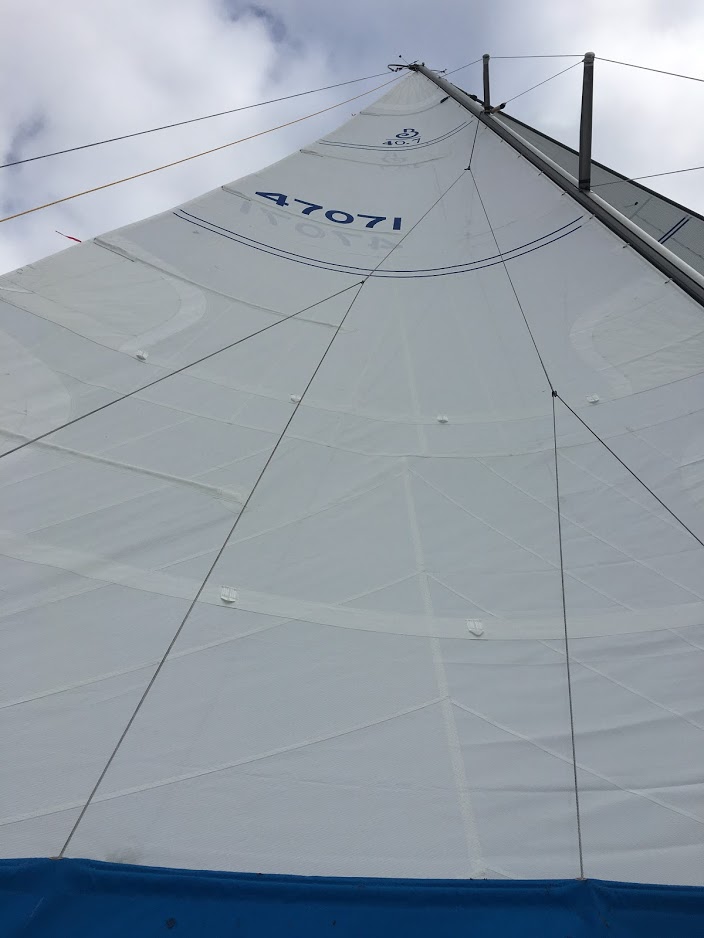
How to Measure for a New Mainsail
If you can read a tape measure you can measure your boat for a new Mainsail.
Purchasing a new Mainsail for your sailboat is one of those investments that every sailor will be faced with eventually. Sails don’t last for ever, even if you treat them like gold. Once you have decided to invest in new sails you may get that feeling of being over whelmed by the choices and the details involved. When deciding on a loft to work with make sure you choose a loft that will offer a good consultation on the cloth and sail feature choices as well as a design consultation if you want one.
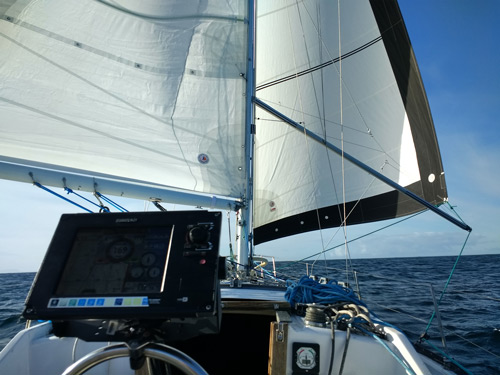
Jibs vs. Genoas
Get to know the difference!
Jibs and Genoas are triangular sails which are affixed to a stay in front of the mast. Typically they run from the head of the foremast to the bowsprit. Jibs and genoa’s are used in tandem with a mainsail to stabilize the vessel and are usually measured by their Luff Perpendicular percentage, that is, how much area within the fore-triangle they use.
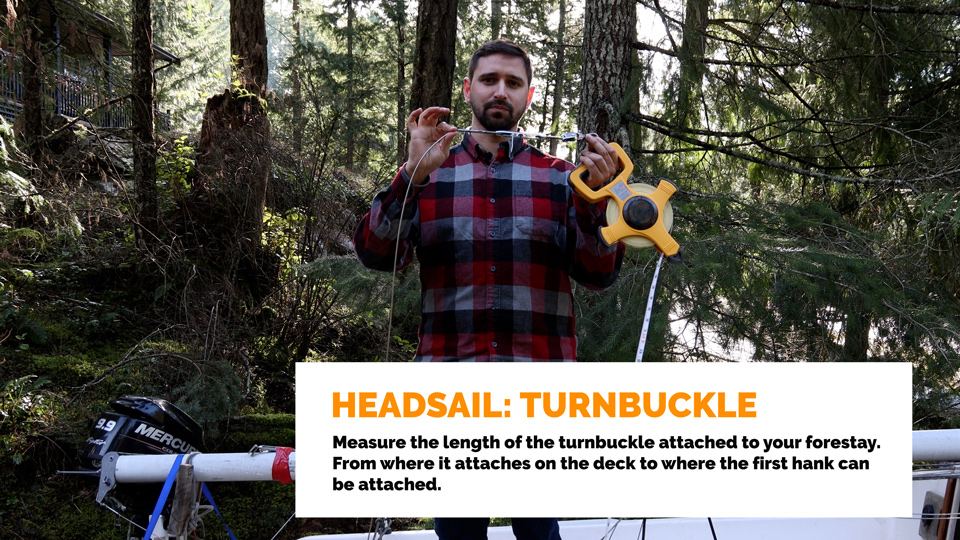
Taking Headsail Measurements with the Mast Down
Measuring your Headsail with your mast down is still possible.
Step by Step How To Instructions and Videos on how to collect your boats measurements for a your new headsail. Watch Jeremy Roszmann, sail designer, walk us through how to collecte great measurements to build a headsail with.
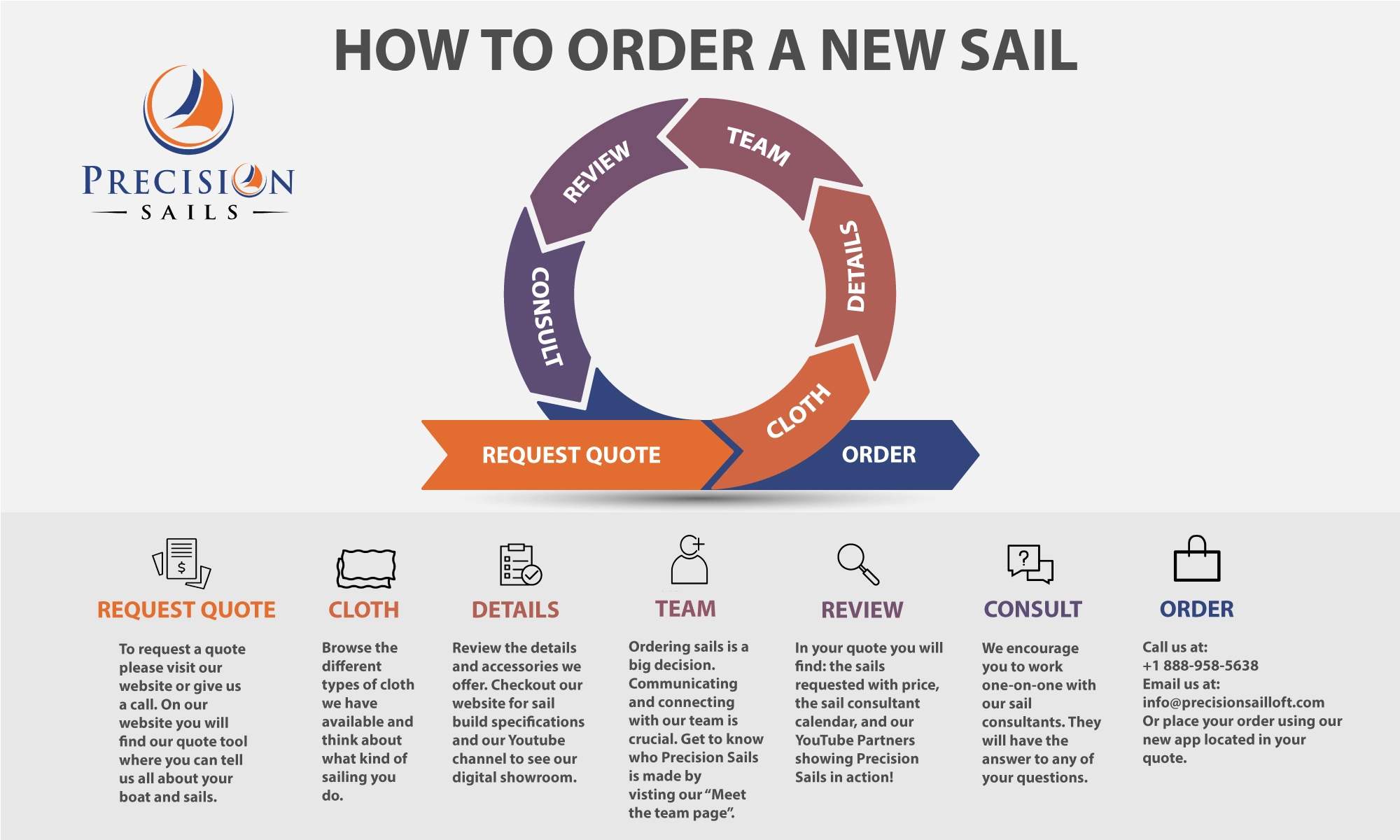
How To Measure for a New Spinnaker
Learn how to measure your boat and rig for a new spinnaker with our simple form.
Measuring your rig for a new spinnaker is easy. We need to know the location of your halyard, what your maximum hoist is, where the location you sheet to is located and what style. We also need to know if you have a bowsprit, plan to use a spinnaker sock, or other kind of furling system. Last but not least, you get to pick your colors!
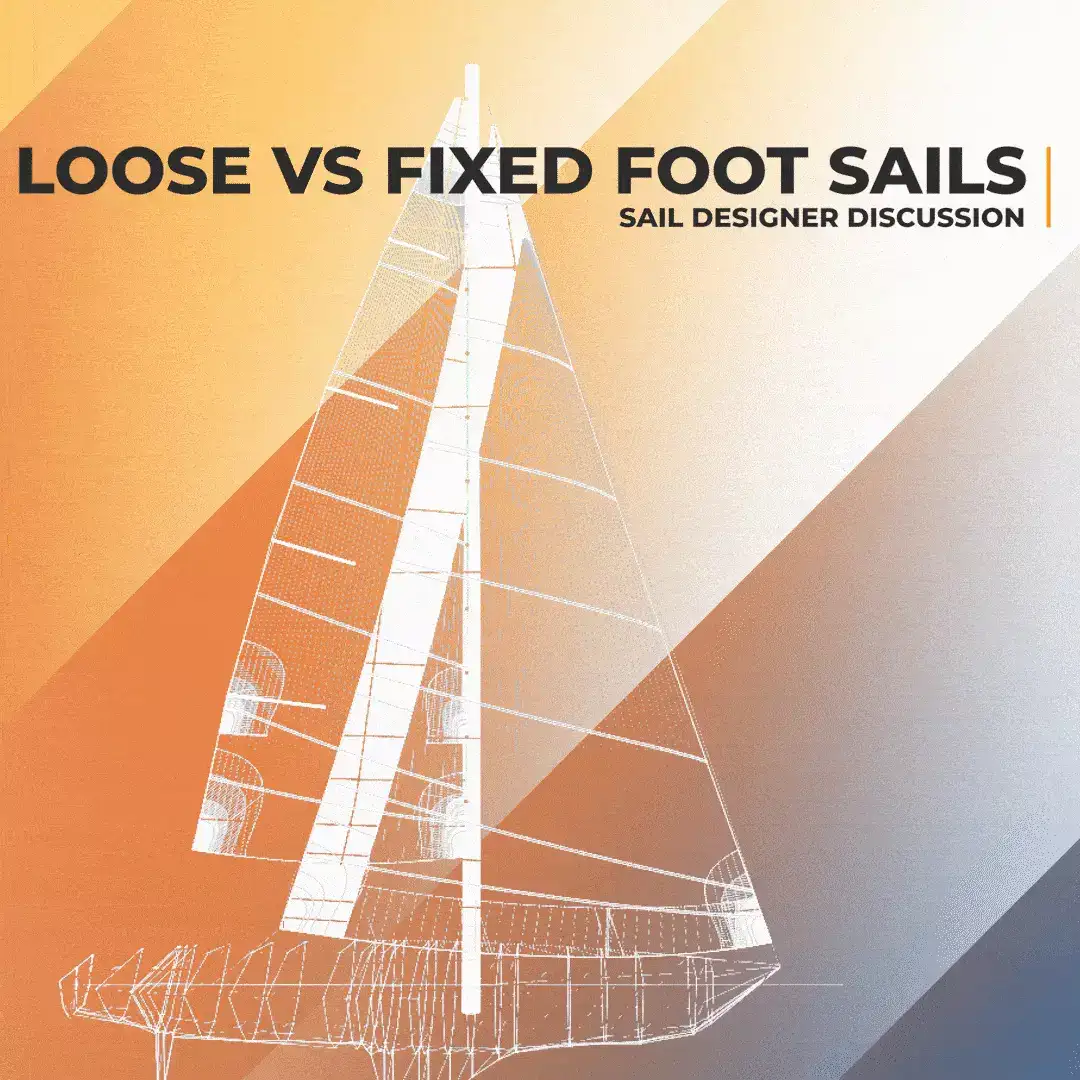
Mainsails: Loose Foot VS Fixed Foot
If you currently have a fixed footed mainsail read about the new modern design of a loose footed mainsail.
Sail design has come a long way in the past several decades. A loose footed mainsail is becoming the norm for most sailors. It allows for creating a better shaped sail. This increasings sail performance, efficency, and power. Having a loose-footed sail means having a much more versatile sail as far as trimming is concerned.
" * " indicates required fields
Thanks for telling us a bit about yourself and your boat. Our team will send you a preliminary quote based on information we have gathered from sailors similar to you.
We will give you a call in order to narrow down the options on your quote and improve the accuracy. If you want us to call you at a specific time, feel free to schedule a time on our calendar!
Thanks for telling us a bit about yourself and your boat. Our team will reach out to offer some suggestions and get started on finding you the perfect sail!
No products in the cart.
Sailing Ellidah is supported by our readers. Buying through our links may earn us an affiliate commission at no extra cost to you.
The Different Parts Of A Sailboat Explained
A sailboat consists of hundreds of parts, each with its specific term and function. From stern to bow, keel to mast, each part and its equipment plays a vital role in making the vessel seaworthy and able to sail.
In this guide, I’ll show you most of the components so you can better understand what they are and their function. We’ll begin with the main components, move to the basic features, and finish with our interior and equipment.
The main parts of a sailboat
The main parts of a sailboat are the key components that make it a vessel able to sail. You’ll notice that the structure has several distinct differences from powerboats.
We can categorize the main parts into the following:
- Hull: The main structure, or “body” part of a boat.
- Keel: The heavy fin at the bottom allows stability under sail.
- Rudder: The fin sticking down at the stern, allowing us to steer the vessel.
- Mast: The “spars” or “poles” holding the sails.
- Rigging: The standing rig is the wires that supports the mast. The running rigging is all the lines that control the sails.
- Boom: The horizontal spar supporting the bottom of the mainsail.
- Sails: The canvas used to harness the energy of the wind.
Let’s dig a bit deeper into each of the components.
Hull – The main structure
A sailboat’s hull is the vessel’s main body or structure. The shape is vital to the boat’s performance and stability, and you have probably seen boats in many different forms. Older vessels are typically narrow, with a rounded underbody and a small stern. Modern designs have a flatter belly and broad stern supporting dual helm stations.
One of the hull’s primary functions is to displace water and provide buoyancy to keep the boat afloat. The hull is also the structure that holds the vessel’s living compartments and all its equipment. The main structure must be strong enough to withstand the forces of the water and any rough weather conditions that Mother Nature might throw at it.
Fiberglass (GRP), steel, aluminum, and wood are the most commonly used hull materials, each with pros and cons.
You can learn more about hull materials and their strengths in this article .
A monohull is a type of sailboat that has a single hull. Monohulls are classified into two categories based on weight and shape: planing and displacement hulls.
Sailboats with more than one hull are called multihulls. There are two types of multihulls: catamarans, which have two, and trimarans, which have three. These boats are typically designed with planing hulls.
Keel – The fin under the boat
The keel of a sailboat is a structural fin that extends downward from the bottom of the hull. There are several types of keels, each with unique characteristics and advantages. They all serve the same fundamental purpose of stabilizing the boat when we sail by adding lateral resistance in the water and weight at the vessel’s bottom.
Standard keel designs include:
- Lifting Keel
Some sailboats have a retractable centerboard functioning as their keel, allowing them to take the boat into shallower areas.
Rudder – To steer the boat
The rudder is a flat surface that sits perpendicular to the waterline. It is connected to the boat by a pivot point, allowing it to swivel left and right. When the steering wheel or tiller is turned, the rudder moves, creating drag in the water causing the boat to turn. The size and shape of the rudder can vary depending on the size and type of boat.
The most commonly seen rudder designs:
- Full skeg-supported
- Semi skeg-supported
Skeg-supported rudders are structurally one of the most reliable and robust constructions, but they are less efficient than a balanced rudder performance-wise. Balanced rudders pivot around their vertical center, giving less drag in the water and higher maneuverability at the cost of being a more vulnerable construction.
Twin rudders are often seen on modern performance sailboats with a wide stern. When the sailboat heel over , the leeward rudder gets better track through the water than a single rudder placed at the vessel’s center line. Contrary to some misconceptions, they can’t be controlled individually, even if the boat has two steering wheels.
Mast and Rigging – Supporting the sails
The mast is the long vertical spar that extends upward from the deck of a sailboat and holds the sails. It is the tallest part of the boat and is typically made of wood, aluminum, or carbon fiber. The mast is held in place by stays and shrouds, which form the sailboat’s standing rigging.
Depending on the rig the boat is manufactured with, there are several different types of masts. For example, a sloop-rigged sailboat will have only one main mast, while a ketch-rigged vessel will have a smaller additional mizzen mast placed further aft from the main mast.
There are two types of rigging:
- The Standing rigging consists of the stays and shrouds that keep the mast or masts in place.
- The Running rigging is the lines we use to hoist, lower, and control the sails.
Pro Tip: “S par” is a general term for a pole made of a solid material like wood, metal, or composite and is used to support a boat’s sail. The mast, boom, spreaders, and poles are defined as spars.
Boom – Supporting the mainsail
The boom is a horizontal beam extending from the mast and supporting the mainsail’s tack and clew (bottom two corners). It is attached to the mast by a hinge called a Gooseneck .
We use the boom to control the shape and angle of the mainsail to optimize its efficiency and power. Some booms also have a Vang or Rod-Kicker installed to assist in trimming the mainsail.
Sails – The canvas used to harness the energy of the wind
Most vessels have at least two sails, depending on the rig type and boat setup.
The Mainsail flies behind the mast, on top of the boom. Although it may not always be the largest sail on the vessel, we commonly refer to it as “the main.”
The Headsail(s ), located in front of the mast, are often of different sizes and shapes, and many sailboats have more than one. The Jib and Genoa are two of the most common types.
Different types of sails are used for various sail plans and situations, and you can learn more about them in this guide .
Now that we had a look at the main parts of the boat, let us dive deeper and look at the rest of the vessel.
The starboard and port side of the boat
Learning about the boat’s components is very important, but we must also know how to orient ourselves on the vessel. Using the words “left and right” on onboard often leads to confusion.
If you refer to something on the left side of the boat, the person facing you will be confused. He won’t know if you are referring to his or your left. This is where the terms “Port” and “ Starboard ” make better sense.
When facing the front of the boat or the bow , your left side of the boat is the port side, and the right-hand side is the starboard . If you turn around and face the back of the boat or the stern , your right-hand side will be the port side.
- A red light identifies the port side of a vessel.
- A green light identifies the starboard side of a vessel.
Windward and Leeward
- The windward side of the boat is the side facing the wind. If the wind comes from your right-hand side while facing forward, the starboard side is windward. This will be the boat’s high side as the wind heels the boat over.
- The leeward side of the boat is the side opposite to the wind. This will be the lower side of the ship while sailing as the wind heels the boat over.
Windward and leeward are two of the most important aspects to understand when sailing and navigating. Not only to identify equipment and gear on each side of the boat but to avoid collisions when sailing close to other vessels. There are rules on the water dictating which boat is “Stand On” and which has to “Give Way” depending on whether you are the windward or the leeward vessel in the situation.
Read this article to access a free course on navigation rules .
Basic parts of a sailboat
The boat’s bow is the front part, typically shaped like a “V” to cut through the waves. Larger vessels often have a locker for their anchor chain in this section, holding the anchor at the front.
The midship section is the center of the boat. Some refer to this part as amidships.
The stern is the rear or back part of the boat. It is also referred to as the aft . I’ve had French crew calling the stern the butt of the vessel, which is funny but also correct!
The beam is the widest part of the boat. Also referred to as the sides on the middle.
The transom is a flat surface across the stern of the boat.
The waterline is the part where the hull (body) of the boat meets the water. Many vessels have a painted stripe to mark the waterline, indicating how loaded the ship is. If you have too much stuff on board, the waterline goes underwater, and it is time to do some housekeeping!
The freeboard is the vertical part of the ship side between the water and the deck. When you see a blue boat like Ellidah, the freeboard is the blue part.
The deck is the “floor” of the boat when you are outside. You have probably heard the term “All hands on deck!” The front deck is the deck space in front of the mast. Side decks are the decks on the boat’s sides.
The mid-deck is between the cockpit and the mast. The aft deck is the deck behind the cockpit. Sailboats with aft cockpits often don’t have any aft decks, but some have a swimming platform instead.
The cockpit is the boat’s steering position and where you will find the helm.
The helm is the position the helmsman uses to steer the boat. Smaller sailboats often use a tiller to navigate, while most bigger yachts have one or two steering wheels.
Main parts below deck (inside the boat)
Let us look at the interior to highlight and learn about the parts we have below the deck.
The Companionway
The companionway is the “front door” of the boat. This is where the steps lead from the cockpit or deck down below. It is usually opened and closed using a hatch, two doors, or a plate.
The Galley
The galley is the boat’s kitchen. This is where sailors prepare their delicious meals.
The Saloon
The saloon is basically the boat’s living room, usually where you find the settee and dinette. This is where delicious meals from the galley are served together with refreshing beverages in good company.
The settee is the sofa or couch in a boat. It is also used as a sea berth to sleep in when sailing.
The dinette is the area where you can sit down at a table and eat your dinner. It’s also perfect for consuming rum and a game of cards in good company.
A cabin is often used as a bedroom in a boat but is not necessarily where you sleep. Many boats have more than one cabin.
A berth is a place in the boat where you can sleep. This doesn’t necessarily have to be a bed and can often include the sleeping space in the saloon. Sea-berth usually refers to a sleeping position where you are tucked well in and can sleep when the boat is heeling over and moving around.
The head is the toilet on a boat. If your skipper tells you to go and clean the head, getting out the shampoo won’t do you any good!
Nav station
The navigation station is usually a chart table and a console with mysterious instruments like radios, switchboards, and complicated electronics. This is where adventures are planned and the skipper’s favorite seat onboard.
The bilge is a space in the bottom of the hull where water collects and sometimes a storage space for all sorts of things. It usually contains a bilge pump to pump out water that finds its way into the boat in various places.
A v-berth is a bed in the front cabin shaped like a V.
A bulkhead is a wall inside the boat, usually supporting the structure.
Hardware and Equipment
Sailboats come equipped with a variety of different hardware and equipment. While the specific items may vary from boat to boat, there are some essentials that nearly every sailboat has.
A winch is a metal drum that gives you a mechanical advantage and is used to control and tighten lines. These can be operated by turning a line around it and pulling manually or by a winch handle to get more force.
Most modern winches are so-called “self-tailing,” which means they lock the line on so you can winch the line without holding on to it. Some boats even have electrical winches operated by a button.
A cleat is a fitting used to fasten a rope. Most boats have at least 6 of these. One on each side on the bow, midship and stern. These are used to secure the boat to a mooring buoy or key. Many ships have more cleats than this for various lines and ropes, and they can be used for anything as they are strong points fitted to the hull.
The sprayhood is the boat’s windshield that protects the people in the cockpit from sea spray. Some vessels have a canvas sprayhood that can be folded down or removed. Others have solid sprayhoods, often called a hard dodger or a doghouse .
The bimini is the cockpit’s “roof.” It protects you from the elements and shelters you from spray, rain, and burning sun rays! A bimini can be made of canvas or hard material. A hard bimini can also be called a hardtop .
Dinghy
A dinghy is a little boat you use to get from the mothership to shore when you are at anchor, also called a tender or annex . It can be everything from a small inflatable rubber kayak to a RIB or even a solid boat.
An essential and valuable piece of kit as it is the daily driver for most cruisers. It is like the car of a land crab, used for all commuting on the water and hauling important stuff like beer, rum, and food onboard. Dinghies often have electric or petrol engines, which we call outboards.
Dinghies are also great to use for watersports, such as wakeboarding!
Like Captain Ron said in the movie, fenders are the rubber bumper things you hang off your boat to prevent it from scratching against something like the pontoon or another ship. It is conveniently also used to sit on or as a backrest while relaxing on deck.
A boat hook is a long stick with a hook at the end. Used to grab lines, items, and stuff that is too far to reach by hand, like cushions flying overboard. It is also convenient as a tool to push the boat away from another craft or the key. Most vessels have them on board.
The guard rail can be a flexible wire or a solid metal rail surrounding the boat to prevent us from falling overboard. Some also use a net as an addition for increased safety.
The pushpit is a metal guard rail around the stern of the boat. This is where the guard rail is secured on the stern: a common place to mount the BBQ, life raft, and the outboard for the dinghy.
The pulpit is the metal guardrail on the bow. This is where the guard rail is secured onto the bow.
The stanchions are the metal bars that keep the guard rail in place around the boat between the pushpit and the pulpit.
An arch is a typical structure made of stainless steel on the back of a boat and is often used to mount a variety of items like antennas, radars, solar panels, wind generators, etc. It is also convenient to use for lifting the dinghy and its outboard.
Ground Tackle
The ground tackle consists of several things:
- Your anchor
- Your anchor chain
- The link between the two
- The connection between the chain and your boat
It includes all equipment holding your boat to the ground. Larger boats sometimes have two anchors on the bow.
A windlass is a winch that hoists and lowers the anchor and chain. Most boats have one on the bow and some on the stern. These incredible things can be electrical or manual (some are both) and are essential to anchor your boat when not in a port or marina.
VHF stands for “Very High-Frequency Radio.” It broadcasts on the VHF network and allows you to communicate with others around you. Sadly, you won’t be able to tune in to your favorite radio show on these.
Still, they are essential for contacting other boats and port authorities. It is also the radio you will transmit an emergency mayday over in case of emergency. VHF radios sometimes require a license, depending on the country you are in.
Chartplotter
A Chartplotter is a navigation computer that shows various information on a screen, like charts, routes, radar images, etc. It is another vital piece of equipment that helps you navigate and maneuver the boat.
Final words
I hope this guide has been helpful and not too overwhelming for you. We’ve covered many of the parts of a sailboat and its terms and functions, but this article only touches on the basics. If you want to keep learning about sailing, I have written several other guides to help you get started.
Now that you have a basic understanding of sailboats, it’s time to take the next step and dive into a sailboat’s standing rigging .
Sharing is caring!
Skipper, Electrician and ROV Pilot
Robin is the founder and owner of Sailing Ellidah and has been living on his sailboat since 2019. He is currently on a journey to sail around the world and is passionate about writing his story and helpful content to inspire others who share his interest in sailing.
Leave a Reply Cancel reply
Your email address will not be published. Required fields are marked *

The 6 Points of Sail: An Illustrated Guide
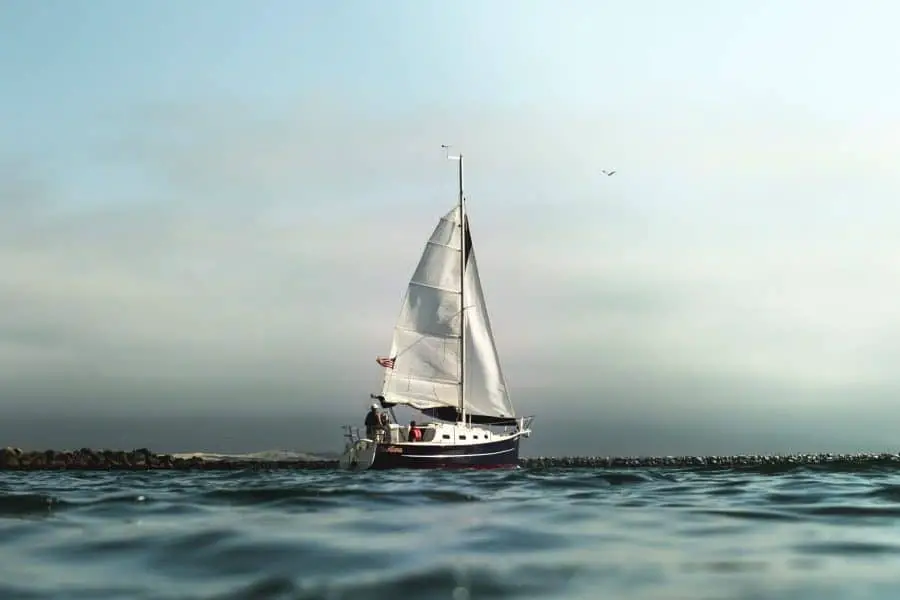
Depending on the direction of the wind and where you’d like to take your sailboat, you’ll need to consider which point of sail to be in. Whether you’re sailing upwind (windward) or sailing downwind (leeward), your sails will either take on the characteristics of an airplane wing or a parachute.
So what are the points of sail on a sailboat? The points of sail include into the wind (in irons), close hauled, close reach, beam reach, broad reach, and running, which go from windward to leeward and are all symmetric from port to starboard.
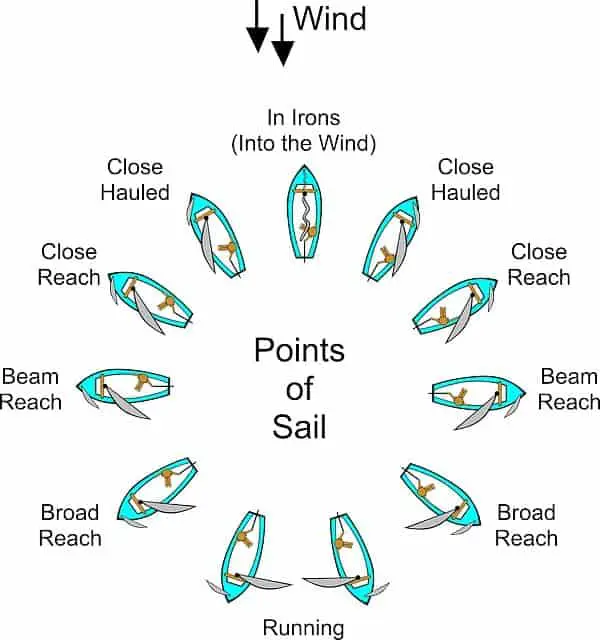
Knowing the points of sail on a sailboat is important in terms of being knowledgeable about how your sailboat generates wind power while also being able to properly communicate with your crew.
It’s also important to understand the difference between upwind sailing and downwind sailing.
There’s a lot of sailing terminology to hash out here as well, so let’s dive into all the different points of sail and learn what they all really mean.
Points of Sail
A point of sail is the direction of a sailboat’s journey while taking into consideration the direction of the true wind as opposed to apparent wind.
The difference between true wind and apparent wind is that true wind is the wind that’s felt by something or someone in one place (like on land) while apparent wind is the wind felt when on the move (like on a sailboat).
The points of sail, when combined, complete a full 360 degrees. Starting from the top (0 degrees) all the way to the bottom (180 degrees), we’ll now explore the different points of sails.
1. Into the Wind (In Irons)
Being into the wind or in irons means your sailboat is going straight into the wind (plus or minus 45 degrees from 0), which will prevent your sailboat from… sailing!
Being into the wind can’t be 100% avoided, and it shouldn’t be, but it’s generally not where you want to be if you plan on moving.
The into the wind point of sail is more often a pivot point for when performing other sailing actions including tacking as well as raising and lowering the mast.
When tacking, your point of sail will change from one side of the sailboat to another while crossing the into the wind point of sail. If you’re not able to cross this point of sail fast enough and get stuck, this is called being “taken aback”.
This is also considered the “no-go zone” or “no sail zone” because, you guessed it, you won’t be going anywhere fast when in this space for too long.
If your sailboat’s in the into the wind point of sail for a long enough time, your sailboat will lose all forward momentum and end up sitting around.
2. Close Hauled
The close hauled point of sail is a tad bit greater than the 45-degree mark on either side of the sailboat.
When at this point of sail, you’ll sail upwind and is often called “beating” as well as “working windward” since your boat is moving toward the wind. Sailing close hauled means you’ll be feeling the wind much more as a captain and crew member!
While sailing close hauled, your sail will be functioning as similar as it can to a wing on an airplane due to it cutting the wind dead on resulting in generating a lot of life.
As a matter of fact, this is when you’ll have the tightest sail trim. The closer you are to the wind (or the “no-go zone”), the more to “point” your sailboat will be.
3. Close Reach
As your sailboat “bears away” (moves away from the wind), it’ll enter the close reach point of sail. This point of sail sits right in between the close hauled and beam reach points of sail on either the port or starboard side of a sailboat. Close reach is a fun and fast point of sail for many sailors!
Close reach is the closest point of sail to the “no-go zone” as any other point of sail, so it’s important to pay attention to the wind and your boat sails.
Since sail trim is so important when it comes to your sailboats speed, it’s important in a close haul to keep your sail tight (similar to a close hauled point of sail) but loose enough so it’s just on the verge of luffing.
4. Beam Reach
When entering a beam reach point of sail, your sailboat will be perpendicular to the wind either on the starboard or port side.
Being in beam reach means you’ll be letting your sails halfway out and you’ll be moving relatively faster than other points of sail. As a matter of fact, it’s known to be the fastest point of sail when on a sailboat!
Not only is beam reach the fastest point of sail on a sailboat, but it’s also the most comfortable due to having more control.
The way in which the wind hits your sails at this point of sail means your boat will be transferring energy more efficiently from the sideways force of the wind to the propelling motion forward.
5. Broad Reach
Moving away from a beam reach and into a broad reach point of sail results in letting your sails out about 2/3 of the way.
At this point of sail, the wind is not coming astern from your sailboat and your sail will act more like a parachute than a wing. Now that you’re sailboat’s heading downwind, you’ll also feel a little less of a windy feel but still should be chugging right along.
Since a sail will be out almost the entire way when in a broad reach point of sail, it’ll start to feel like you’re going downhill when it comes to the wind.
While your sailboat won’t yet be truly going entirely downwind, you’ll be on the verge of entering it.
While not the fastest point of sail, I’m a personal fan of broad reach since we’re going at a decent speed and it feels much calmer (in terms of the wind speed) than more windward points of sail.
When you let your sails out the most they can go and the wind is coming directly behind your sailboat, you’ll sail downwind and you’re definitely on a running point of sail.
This point of sail can truly feel like you’re running downhill since you have the force of the wind directly propelling you and your sailboat forward. As a matter of fact, it acts a lot like a parachute and really feels great!
Also known as a “dead run”, the running point of sail doesn’t require critical attention to be made on the sail trim.
Depending on the strength of the wind speed, this means you can consider putting up a genoa or spinnaker sail to really get your sailboat moving when sailing directly downwind.
If you feel that the wind is fairly constant in terms of direction and intensity, this is a great time to put those massive colorful sails up!
How a Sail Works
When I first learned how to sail, I thought the sail was always acting kind of like a kite and simply floating across the water. Well, it turns out that it’s a little more complicated and interesting than that!
As I mentioned before, the sail can act in two different ways: as a wing and as a parachute.
When in the close hauled, close reach, and partially the beam reach points of sail your sailboat’s sail is acting a lot like a wing .
Based on the magnitude and angle at which the true wind and sailboat are traveling, the combination of the two will produce an apparent wind force.
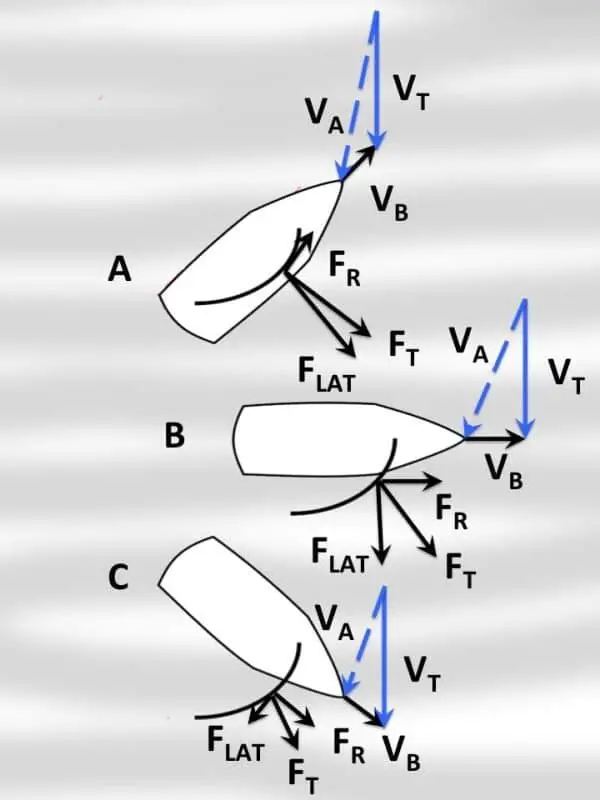
The transfer of energy to produce a forward moving force is mainly due to the sail, keel, and hull .
Essentially, the sail catches the wind’s energy forcing the sailboat to tilt to the side followed by resistance to this tilting from the keel allowing the hull to effectively cut through the water with the remaining force.
When in the broad reach and running points of sail, these forces are still at play resulting in a wing-like action, however, in these points of sail the true wind and sailboat forces are much more aligned.
Essentially, this produces more of a parachute effect as opposed to a wing since the apparent wind force is indistinguishable from the other forces.
Related Questions
What is the best point of sail? The best point of sail is based on personal preference, but the fastest and most comfortable point of sail is beam reach. The combination of the lateral force from the wind onto the sail and the resisting force from the keel produces the strongest forward-moving force on a sailboat.
What is the difference between a jib and genoa sail? Both a jib and genoa sail are sails hoisted at the fore of a sailboat with the genoa being larger in size. The genoa sail oftentimes overlaps the mast due to its size and is mainly used when in a running point of sail.
How do you turn a sailboat? Turning a sailboat occurs when performing a tack or jibe (gybe). Tacking happens when a sailboat is turning into the wind, which requires a traversal through the “no-go zone”. Conversely, jibing happens when traversing through the running point of sail.
Get the very best sailing stuff straight to your inbox
Nomadic sailing.
At Nomadic Sailing, we're all about helping the community learn all there is to know about sailing. From learning how to sail to popular and lesser-known destinations to essential sailing gear and more.
Quick Links
Business address.
1200 Fourth Street #1141 Key West, FL 33040 United States
Copyright © 2024 Nomadic Sailing. All rights reserved. Nomadic Sailing is a participant in the Amazon Services LLC Associates Program, an affiliate advertising program designed to provide a means to earn fees by linking to Amazon.com and affiliated sites.

Everything you need to know about Changing Sails on your Sailboat

Table of Contents
Step by Step Guide on How to Change Sails on a Sailboat
Changing damaged sails on a sailboat can be a daunting task, but with the right tools and knowledge, it can be done quickly and efficiently. In this blog post, we will go over the step-by-step process of changing damaged sails on a sailboat.
Step 1: Gather the necessary tools and materials Before you begin, make sure you have all the necessary tools and materials. This includes a new sail, sail repair tape, scissors, a needle and thread, and a sail repair manual.
Step 2: Remove the damaged sail To remove the damaged sail, first, lower the sail using the halyard and then remove the sail from the sailboat. Take care to fold the sail properly to prevent further damage.
Step 3: Inspect the sail Once the sail is removed, lay it out flat on a clean surface and inspect it for any tears or holes. Mark the damaged areas with a pen or marker.
Step 4: Repair the sail Using the sail repair tape, patch up any small holes or tears in the sail. For larger holes or tears, use a needle and thread to sew the sail back together. Make sure to use a strong thread that is the same color as the sail.
Step 5: Reinforce the sail To reinforce the sail and prevent future damage, use sail repair tape to create a patch around the area that was repaired. This will provide extra support and make the sail stronger.
Step 6: Reinstall the sail Once the sail has been repaired, it’s time to reinstall it on the sailboat. Start by attaching the sail to the mast using the halyard. Next, attach the sail to the boom using the outhaul and the downhaul. Finally, adjust the sail to the proper shape and tension.
Step 7: Test the sail Once the sail is installed, take the sailboat out for a test sail. Make sure the sail is properly adjusted and that there are no further issues.
Changing damaged sails on a sailboat can be a time-consuming task, but with the right tools and knowledge, it can be done quickly and efficiently. By following these steps, you can ensure that your sailboat is ready to hit the water again in no time.
Note: This is a general guidance and it’s always best to consult the manufacturer’s manual and/or consult a professional sailor or sail repair specialist if you are not sure of something.
Is it time to replace/maintain my sails?
One of the most important parts of maintaining your boat is keeping an eye on your sails and knowing when it’s time to replace or repair them.
One of the first signs that your sails may need to be replaced or repaired is if they begin to show signs of wear and tear, such as frayed edges, holes, or tears. These signs can be caused by a variety of factors, including exposure to the sun, wind, and water, as well as improper use or storage. It is important to inspect your sails regularly and address any issues as soon as they arise to prevent further damage.
Another sign that your sails may need to be replaced or repaired is if they are no longer able to hold their shape or maintain proper tension. This can be caused by a variety of factors, including stretching, shrinkage, or damage to the material. If your sails are no longer able to hold their shape, it can make it difficult to control your boat and can also increase the risk of capsizing.
If you notice any signs of wear and tear or damage to your sails, it’s important to address the issue as soon as possible. This may involve repairing or patching small holes or tears, or replacing your sails entirely. It is also important to take proper care of your sails by storing them in a dry, cool place and making sure that they are properly cleaned and maintained.
In summary, the key to maintaining your sails and ensuring that your boat is in good condition is to keep an eye on the condition of your sails and address any issues as soon as they arise.
Pros and Cons of Repairing/Replacing Damages Sails
| – Cost-effective | – Can provide a new and improved sail with updated materials and technology |
| – Can be done quickly and easily with the right tools and knowledge | – Can improve overall performance and efficiency of the sailboat |
| – Saves the environment by not disposing of the sail | – Can provide a fresh and new look to the sailboat |
| – May not be as strong or durable as a new sail | – Can be expensive |
| – May not provide the same level of performance as a new sail | – May not be the most environmentally friendly option |
| – Repaired areas may be visible | – May require more time and effort to install |
Please note that this is a general table and the pros and cons may vary depending on the specific situation and the type of sail.
Where to buy new sails
There are a variety of places where you can buy new sails for a sailboat. Some options include:
- Sailmakers and sail lofts: Many sailmakers and sail lofts specialize in creating custom sails for sailboats. They can create sails tailored to your specific needs and preferences.
- Marine supply stores: Many marine supply stores carry a wide range of sails, including replacement sails for specific sailboat models.
- Online retailers: You can also purchase new sails online from a variety of retailers. Some popular online sail retailers include Sailrite, US Sailmakers, and North Sails.
- Sailboat manufacturers: Many sailboat manufacturers also sell replacement sails for their specific models.
- Sailboat dealers: Some sailboat dealers also carry replacement sails for the sailboats they sell.
When buying a new sail, it’s important to consider factors such as size, material, and intended use. It’s also a good idea to consult with a professional sailor or sail repair specialist to ensure that you get the right sail for your sailboat.
Tips of how to choose which sail to buy
When choosing a new sail for your sailboat, there are a few key factors to consider:
- Size: Make sure the sail you choose is the right size for your sailboat. The size of the sail is determined by its luff, leech, and foot measurements.
- Material: The choice of material for your sail will depend on the intended use of the sailboat. Dacron is a popular and durable material for cruising sails, while laminate materials like Mylar or Kevlar are used for racing sails because they are lightweight and strong.
- Shape: The shape of the sail will also affect its performance. Full-batten mainsails and roller furling headsails are popular options for cruising sailboats, while racing sailboats often use a square-top main and a jib with a smaller roach.
- Intended use: Consider the type of sailing you will be doing and choose a sail that is suitable for that purpose. For example, if you will be doing a lot of racing, a high-performance racing sail would be a good choice.
- Brand reputation : Look for sailmakers that have a good reputation and a track record of producing high-quality sails.
- Price: Finally, consider the cost of the sail, and compare it to the other options available.
It’s always a good idea to consult with a professional sailors or sail repair specialist to ensure that you get the right sail for your sailboat. They can provide expert advice and help you choose the best sail for your specific needs and preferences.
How important is a Sail on a Sailboat
Sails are extremely important on a sailboat as they are the primary means of propulsion. A sailboat’s ability to move through the water is dependent on the wind and the sails’ ability to harness that wind energy and convert it into forward motion. Sails are also an important safety feature as they can be used to control the direction and speed of the boat, which can be crucial in emergency situations.
A well-designed and properly maintained sail can also greatly affect the performance and efficiency of a sailboat. The right sail can help a sailboat reach its maximum speed and maneuverability, making sailing more enjoyable and efficient.
Additionally, sails are an important part of the aesthetics of a sailboat, and a new or well-maintained sail can give a sailboat a sleek and polished look.
In summary, sails are crucial for the propulsion, safety, performance, and aesthetics of a sailboat. Proper maintenance and care of the sails are crucial for the sailboat to function properly and safely.
Are there designer brands of sails?
Yes, there are designer brands of sails available. These are typically high-end sail manufacturers that are known for producing high-quality and innovative sails for sailboats. These brands are often associated with performance, technology, and design and have a reputation for producing top-performing sails that are made with the latest materials and manufacturing techniques.
Examples of designer sail brands include:
North Sails
Doyle sails, quantum sails, uk sailmakers.
Ullman Sails
These brands have a reputation for producing high-quality and high-performing sails that are made with the latest materials and manufacturing techniques. They can be more expensive than other sails, but they offer many advantages, such as better performance, longer lifespan, and a unique look. It’s always a good idea to consult with a professional sailors or sail repair specialist to ensure that you get the right sail for your sailboat.
Do you need necessarily a specialist to change a sail for you?
You do not necessarily need a specialist to change a sail on your sailboat. However, it can be helpful to have the assistance of someone who has experience in working with sails, as they will have the knowledge and skills needed to properly measure and install the new sail. Changing a sail can be a complex task that involves working with ropes, pulleys, and other hardware, as well as dealing with wind and weather conditions. Additionally, it’s a task that requires attention to detail and the ability to work in confined spaces.
If you are not familiar with sail handling, rigging and maintenance, it is recommended to seek the help of a professional sail maker or sail repair specialist. They can also help you to choose the right sail for your boat and your needs, and will be able to repair or replace your sails with the right technique and materials.
If you choose to change the sail yourself, make sure to read the instructions carefully and practice safety precautions. Always wear protective gear, such as gloves and goggles, and never work alone. If you are not confident in your abilities, it’s best to seek the help of a professional.
Which type of sails are the most difficult to change
Some types of sails are more difficult to change than others, depending on the design and construction of the sail, as well as the type of boat it is used on. Some of the most difficult sails to change include:
- Mainsails: The mainsail is the largest sail on a sailboat and is typically the most difficult sail to change. It is attached to the mast and boom, and can be difficult to remove and replace due to its size and weight. Additionally, the mainsail is often used to control the speed and direction of the boat, so it is important to ensure that it is properly adjusted and tensioned.
- Spinnakers: Spinnakers are large, balloon-shaped sails that are typically used for downwind sailing. They can be difficult to change because they are often used in conjunction with other sails, such as the jib or genoa, and require coordination between the crew. Additionally, spinnakers are typically made of lightweight and delicate materials, which can be easily damaged if not handled properly.
- Gennakers: Gennakers are similar to spinnakers and are used for downwind sailing, but are more user-friendly and are typically easier to handle and change.
- Square-rigged sails: Square-rigged sails are typically used on larger, traditional sailing vessels and can be difficult to change due to their size and complexity. They are typically made of heavy materials and require a large crew to handle them.
It’s important to note that changing any sail requires a certain level of skill and experience, and it’s always best to consult with a sail repair specialist or professional sailors to ensure that you get the right sail for your sailboat.
Which type of sails are the easiest to change?
Some types of sails are generally considered to be easier to change than others, depending on the design and construction of the sail, as well as the type of boat it is used on. Some of the easiest sails to change include:
- Jibs: Jibs are triangular sails that are located at the front of a sailboat and are typically the easiest sail to change. They are smaller in size compared to other sails and are relatively easy to handle and replace.
- Genoas: Genoas are similar to jibs but are larger and are typically used in conjunction with the main sail. They are also relatively easy to change, but may require more skill and experience than a jib.
- Roller-furling sails: Roller-furling sails are sails that are designed to be easily rolled up and unrolled, making them easy to change. They are typically used on smaller sailboats and are a popular option for sailors who are looking for a more user-friendly sail.
- Dacron sails: Dacron is a type of synthetic fabric that is commonly used in sailmaking. Sails made of Dacron are relatively easy to change, as they are strong and durable, but not as expensive as other types of sails.
In conclusion, changing sails on your sailboat can seem like a daunting task, but with the right knowledge and preparation, it can be a smooth and enjoyable process. Remember to assess the damage on your current sail, consider the pros and cons of repairing versus buying a new one, choose the right replacement sail, and consult with a sail repair specialist or professional sailor for guidance. Additionally, be aware of different sail manufacturer brands, the average prices and durability estimation.
In this blog post, we’ve provided you with a step-by-step guide on how to change sails on your sailboat, as well as tips on choosing the right sail and information on popular sail manufacturers. By following the information provided in this post, you’ll be able to change your sails with confidence and get back to enjoying your time on the water.
Steven T. Anderson
Steven Taylor Anderson is an experienced sailor and author who writes for sailingbetter.com. He has been sailing for over 20 years across the USA and has taken several courses to improve his skills. He has also navigated throughout the world on various boats and yachts. His passion for sailing and knowledge of the sport shines through in his writing, making him a respected authority on the subject.
Recent Posts
Lagoon vs Leopard Catamaran: Which Sailboat Is Right for You?
Introduction When it comes to cruising on the open waters, catamarans have gained immense popularity for their stability, space, and comfort. Two of the leading catamaran manufacturers, Lagoon and...
How to Determine Sailboat Weight: A Comprehensive Guide
Introduction Sailing is a thrilling and adventurous activity that has captivated humans for centuries. Whether you are a seasoned sailor or a novice looking to set sail for the first time,...
- New Sailboats
- Sailboats 21-30ft
- Sailboats 31-35ft
- Sailboats 36-40ft
- Sailboats Over 40ft
- Sailboats Under 21feet
- used_sailboats
- Apps and Computer Programs
- Communications
- Fishfinders
- Handheld Electronics
- Plotters MFDS Rradar
- Wind, Speed & Depth Instruments
- Anchoring Mooring
- Running Rigging
- Sails Canvas
- Standing Rigging
- Diesel Engines
- Off Grid Energy
- Cleaning Waxing
- DIY Projects
- Repair, Tools & Materials
- Spare Parts
- Tools & Gadgets
- Cabin Comfort
- Ventilation
- Footwear Apparel
- Foul Weather Gear
- Mailport & PS Advisor
- Inside Practical Sailor Blog
- Activate My Web Access
- Reset Password
- Customer Service

- Free Newsletter

Ericson 41 Used Boat Review


Mason 33 Used Boat Review

Beneteau 311, Catalina 310 and Hunter 326 Used Boat Comparison

Maine Cat 41 Used Boat Review

Tips From A First “Sail” on the ICW

Tillerpilot Tips and Safety Cautions

Best Crimpers and Strippers for Fixing Marine Electrical Connectors

Thinking Through a Solar Power Installation

Getting the Most Out of Older Sails

How (Not) to Tie Your Boat to a Dock

Stopping Mainsheet Twist

Working with High-Tech Ropes

Fuel Lift Pump: Easy DIY Diesel Fuel System Diagnostic and Repair

Ensuring Safe Shorepower

Sinking? Check Your Stuffing Box

The Rain Catcher’s Guide

Boat Repairs for the Technically Illiterate

Boat Maintenance for the Technically Illiterate: Part 1

Whats the Best Way to Restore Clear Plastic Windows?

Mastering Precision Drilling: How to Use Drill Guides

Giving Bugs the Big Goodbye

Galley Gadgets for the Cruising Sailor

Those Extras you Don’t Need But Love to Have

UV Clothing: Is It Worth the Hype?

Preparing Yourself for Solo Sailing

How to Select Crew for a Passage or Delivery

Preparing A Boat to Sail Solo

On Watch: This 60-Year-Old Hinckley Pilot 35 is Also a Working…

On Watch: America’s Cup

On Watch: All Eyes on Europe Sail Racing

Dear Readers

Chafe Protection for Dock Lines
- Boat Maintenance
Quick and Safe Sail Cleaning
Oxi-clean and dirt cheap diy formula match specialty cleaners. we also learned uv rays during drying time will also help things along..

It can be a rust stain caused by a loop of chain that spent the winter lying on a sail. Perhaps a bird crawled under the sail cover and built a nest, pooping on the sail for weeks. Either way, cleaning a laminated sail presents a particularly vexing problems, since mildew likes the adhesive that bonds the material, resulting in a stain that is sealed between waterproof layers. Some of these just look bad (rust stains), but others can slowly weaken a sail (mildew in the laminate adhesive). But in all cases, overly aggressive cleaning can make things even worse, weakening the sail more than the mildew ever would.
Stains can be removed in three general ways. They can be physically removed, dissolved, or bleached (made invisible). Each requires different chemistry and a different mindset, so it helps to understand the stain.

Photos by Drew Frye
Most stains are linked to moisture. Good ventilation prevents condensation, so consider taking sails home for the off-season. Canvas should be treated with water repellent (see PS February 2014 online ). This is the single most effective way to combat lichen mildew on both the cover and the sail under it.
THREE WAYS TO REMOVE A STAIN
Physical removal requires that the bond be broken. In the case of mildew and algae, this requires that the organism be killed and for some time to pass. Borax, oxygen bleach (sodium percarbonate or sodium perborate), chlorine bleach (sodium hypochlorite), and quaternary amines (benzalkonium chloride and others) are all effective if given a soaking period. The required dose is not very high, so more is not better. Sunlight works on mildew, though very similar looking black algae are not killed by UV (unless the mildew truly grew in the dark, consider that it might actually be algae).
Surfactants—including both organic soaps and detergents, and inorganics such as trisodium phosphate (TSP), baking sodas, and borax—help by breaking static bonds and emulsifying grease. Again, soaking time helps, followed by gentle agitation. More effective and less damaging, a little light work with a brush, with the sail laid out on a non-abrasive surface, also works. But remember that stains that are between laminate layers or deep in a seam will not be helped by scrubbing.
Dissolving works best on rust, corrosion, and metals stains. The trick is to reduce the pH far enough to dissolve the metal oxide without damaging the cloth. Nylon is vulnerable to strong acids, literally dissolving before your eyes in battery acid, so nothing with a pH of less than 3 should be used. Polyester and other fabrics are less vulnerable, but we like to keep the pH above 3 because nylon thread can always sneak in.
It is always better to soak for longer rather than to use stronger chemicals, since the cloth is not affected by long soaking times at a safe pH, but the stain will slowly vanish. Some products contain chelating agents (EDTA and its relatives) to help dissolve and suspend metal at less acidic pH. The pH values for common cleaning acids such as hydrochloric acid (sold as muriatic acid), oxalic acid (Ospho), acetic acid (vinegar), and lactic acid (CLR brand) can vary by concentration, so if you are going to use an acid cleaner, you may have to dilute it further. Here are the pH levels of common acids used for cleaning (note that the acid concentrations indicated by percentages can vary by product):
Hydrochloric acid (3% acid), diluted with water 20:1, very low pH
Oxalic acid (100% acid), diluted with water 20:1, pH 2-3
Acetic acid (vinegar, about 4-6% acid), used undiluted or diluted with water 10:1, pH 3.3-2.4
Lactic (CLR brand acid is about 15%), diluted with water 10:1 to 20:1, pH 3.5-3.0
Bleaching is a reaction where the reactive chemical (hypochlorous acid in the case of chlorine bleach, peroxide radical in the case of oxygen bleaches) changes the chemical structure of the stain to where it no longer absorbs light, which is what gives it the color. Often, the contamination remains in place, but you simply can’t see it. In the case of laminate sails, there is little hope or removing mildew from between waterproof layers—anything that could do that would leave the sail in ruins. However, we can kill the mildew and then make the remains disappear, which is just as good. The mildew has stopped eating the sail, and we don’t have to look at the stain. What is required is an active ingredient that can permeate through the thin laminate without damaging the cloth or adhesive. What is the most effective ingredient? Oxygen bleach—like Oxiclean—generates an uncharged radical that can permeate through the film faster than the larger hypochlorous or borate ions. Also, it is less aggressive to the fabric than bleach. While properly diluted bleach (no stronger than laundry recommendations) is safe for polyester, Spectra, and Dyneema, it weakens nylon and should be avoided. Chlorine bleach is Kryptonite to Kevlar and all aramids. In testing, exposure to a 30 percent solution of household bleach for 10 minutes can reduce the strength by 70 percent, destroying the sail. Even worse, residue becomes trapped within the laminate and destroys the Kevlar over time.
Permeation is a slow process. It still takes 15-30 minutes for the active ingredients to reach stains inside laminates, and more time to do their work. Warm water helps. Molecules move faster, reactions are faster, and specific to peroxide-based cleaners, they are more effective the hotter the water is, though most have been formulated with tetraacetylethylenediamine (TTEA), which lower the effective temperature to about 105 F (hot-tub temperature). Increasing concentration makes little difference, so it is always better to substitute time for excess concentration. However, there is a practical limit to time. Like epoxies, oxygen bleaches are reactive and after 3-8 hours they become spent. In fact, the active ingredient in oxygen bleaches is not stable in water and any liquid product that claims to include Oxiclean are slightly misrepresenting the facts; they contain enzymes, but no percarbonate or peroxide compounds. They are not stable once dissolved in water.
A final thing to consider is the effect of any residue. Even after rinsing, both laminates and resinated cloth will retain some of the cleaner. It wicks its way deep inside during the soak, and even a vigorous rinsing cannot remove chemicals from behind waterproof layers. First, never exceed recommended concentration. Second, favor cleaners that leave residue that will serve some positive function; borates and BAC-based algaecides, for example, retard mildew growth. Finally, avoid cleaners that contain biodegradable organic components that may become mildew food. Most liquid laundry detergents have this failing and actually encourage mildew regrowth.
SOAK, SCRUB OR MACHINE?
A machine is always wrong, no matter how gentle. A cycle is surely equivalent to dozens of hours of flogging and is sure to break down the resins, fatigue Kevlar fibers, and separate laminates. Some services use floors scrubbers, not much different from carpet cleaners with the vacuum turned down. They save time, but they can damage glue on sail numbers and tell tales. You can do the same by hand, and may need to for small spots, but should obviously be gentle. Worst of all, the chemical does not have time to work.
Finally, there is soaking. This takes time, but if the chemicals are properly selected and diluted, soaking is harmless to the cloth and effective. First, rinse the sail and examine for wear. Then spot-treat for rust or grease. Then soak in oxygen bleach. This is a required step for mildew and brightening.
Because the simplest way to dry a sail is to hoist it, we suggest not cleaning sails when the boat is in storage, but rather when they can be put back on the boat. Alternatively, you may have a dry place you can drape the sail. Putting a sail away wet is an excellent way to restart the mildew cycle.
A stain is not going to hurt anything. Despite ubiquitous statements to the contrary, we failed to find any concrete evidence that mildew and light staining/dirt damages sailcloth. On the other hand, stories abound of sails ruined by attempts to make them white again. We watched a guy scrub a sail with bleach until it was so weakened he put the scrub brush right through it. So long as you have killed the mildew (oxygen bleach or borax), simply learn to ignore it. Sails are the main engine of the boat, not a fashion accessory.
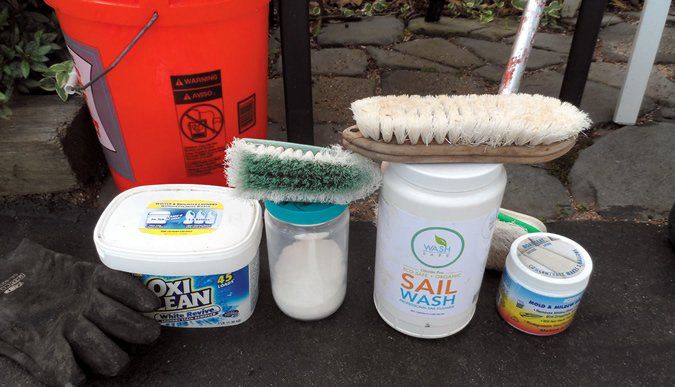
WHAT WE TESTED
For cleaners, we tested CS-530 from Challenge Sail Cloth, Oxi-Clean Powder, Sail Wash by Wash Safe, Mold and Mildew Cleaner by Iosso, a homemade concoction we call Formula B ( Inside Practical Sailor blog, October 13, 2014 ), and Star Brite Canvas and Sail Cleaner.
HOW WE TESTED
Our mainsail became the unfitting home to several families of birds over the years. Those spots needed cleaning. We also recovered some perfectly nasty Sunbrella from the recycle bin, which provided a nice assortment of mildew and rust stains. Finally, we tested a laminated sail with mildew between the layers. We sectioned off each test material (sail or canvas) and cleaned sections with each material, diluting, scrubbing, and soaking according to the directions.
OBSERVATIONS
Our first big project was cleaning the salon cushions of our 20-year-old catamaran. When they were last cleaned we can’t say, but for the 10 years we’ve had the boat, we’ve had kids running all over, spilled food and sunscreen, put our feet up, and sweated all over them.
We sectioned them off and went at them with a scrub brush and each of the sail cleaners in sequence, scrubbing vigorously but briefly, allowing to soak for two hours, rinsing liberally with a hose, and then extracting the liquid with the upholstery attachment on a carpet cleaner. Troublesome spots were re-treated. In the end they all came equally clean.
Some spots went deep into the foam. As the stain was removed, more would migrate to the surface, requiring repeated spot cleaning over a 36-hour period. This was not difficult, only time consuming.
And yet at this point the covers were not quite bright. But all was not lost. We learned you should quit when the canvas is nearly clean. It seems that the oxygen bleach weakens enough bonds that a half-day in the sun can often finish the job to perfection. They need drying time anyway, and the sun will safely finish your work.
We then tackled a sail that had been a birds nest for a few weeks. We tried Formula B and Star Brite Canvas and Sail Cleaner; both removed the surface dirt, but none appreciably affected the underlying stains. We then attacked the stains with CS-530 and Oxi-Clean, using procedures similar to those described for the cushions.
Winds were very light and on the bow, the sail is full batten and does not flog, so we scrubbed the stains right on the spars, hoisting and lowering as needed for access. In all cases, the stains were greatly reduced within two hours, and then vanished completely after several days exposure to the sun while sailing. Again, the lesson is that UV finishes the job, so quit when you are about 80 percent of the way there.
Finally, we sliced a mildewed section of an old taffeta/Mylar/Kevlar sail into squares and treated them according to the instructions. We did not scrub these, as the material would not stand it, and the results were less than perfect. But they were far better than surfactant cleaners, without the vigorous scrubbing. Again, sunlight helped, and the final result should satisfy.
PRODUCT SUMMARIES BY TYPE
Some of the products contain percarbonate, and by releasing hydrogen peroxide, remove stains chemically. These also contain surfactants. Others contain surfactants only.
Percarbonate-Based
We were impressed by all of these but could not determine real differences in performance between them. All are powders and all require 2-8 hours to work. CS-530 Mold and Mildew Cleaner, Sail Wash, and Iosso Mold and Mildew Cleaner all performed well and are recommended. In our view, however, you can do just as well using Oxi-Clean Powder, which is cheaper and possibly already in your laundry room.
Bottom line: Percarbonate-based cleaners are safe and effective when used as directed. You don’t have to buy a specialty cleaner to get the job done.
Surfactant based
For a quick cleaning, with allowing soaking time, these perform about the same as percarbonate-based cleaners.
The home-made Formula B (1 quart hot water, 1 tablespoon baking soda, 2 tablespoons washing soda, 2 tablespoons Borax, 2 tablespoons TSP) is an effective mildewcide with some preventative properties. However, it is not going to penetrate within laminates. It requires a little more pre-soak time than the Star Brite product (give it 10 minutes to work), but the results were similar.
Star Brite Canvas and Sail Cleaner is a good solid fabric cleaner. It removed what was on the surface but had limited effect on stains. Because it contains glycol ethers, we are not sure it is suitable for all laminate sailcloths.
Bottom line: Star Brite’s Canvas and Sail Cleaner is great for quick clean-up of surface dirt. For the budget conscious with a little more patience, Formula B is our Budget Buy.
CLEANING SERVICES
We have not used any cleaning services, although we have received feedback over the years from readers. Most of the users were satisfied, some expected something better, and the time required varies. All services will inspect and offer repairs. These may be required before they will risk washing them; the UV covers on some of the sails we tested were so deteriorated they would not have survived the cleaning process without damage. It is also important to be realistic in your expectations; some minor stains may remain, since the measures required to remove them might damage the sail.
Using the much-advertized LaMauney process, Sail Care cleans and re-seals the sail (using resins) to restore some level of crispness. The process does not affect the shape of the sail. They will not process laminate sails. Nylon sails are only washed. We’ve gotten mixed reviews from readers, and online comments also reflect varied levels of service. Some rave about the crisp sail they got back, others cite expensive repairs and no improvement.
Another company, Clean Sails uses a soaking process very similar to that described in this article.
Bottom Line: We don’t have enough experience to rate these services. We recommend trying some of the DIY techniques first.
CONCLUSIONS
Because stains vary, there can be no single winner. For rust stains, we like CLR. Dilute 20:1 with freshwater, soak for up to 15 minutes, and rinse. For extra measure, you could buy pH strips (at pet or pool stores) to monitor the pH, particularly with nylon. For surface dirt on polyester sails and canvas, we like Formula B; it kills mildew and leaves an inhibiting residue. For mildew and algae stains we like all of the oxygen bleach products, though CS-530 may have a slight edge in soil removal.
Just how clean did the sails and cushions come out? They were near perfect and we were stunned. The sails came clean too, after a few weeks in the sun. But we would have accepted a few stains rather than use overly aggressive cleaning methods or chemicals.
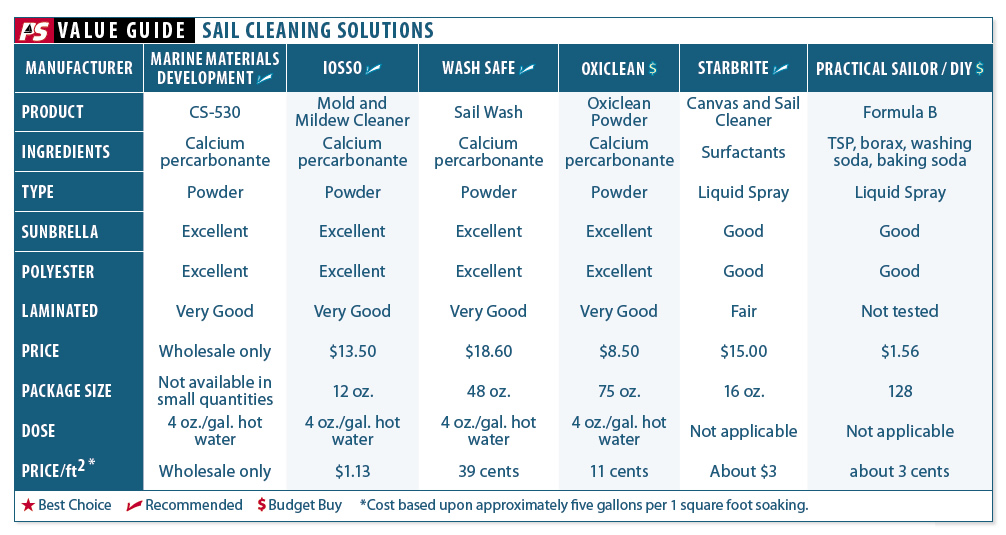
RELATED ARTICLES MORE FROM AUTHOR
Leave a reply cancel reply.
Log in to leave a comment
Latest Videos

What’s the Best Sailboats for Beginners?

Why Does A Sailboat Keel Fall Off?

The Perfect Family Sailboat! Hunter 27-2 – Boat Review

Pettit EZ-Poxy – How to Paint a Boat
Latest sailboat review.
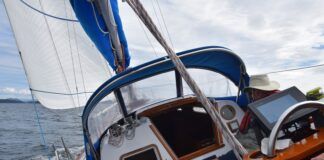
- Privacy Policy
- Do Not Sell My Personal Information
- Online Account Activation
- Privacy Manager

The 6 Points of Sail: Diagram of Wind Direction and Sail Trim
Points of sail are the different angles at which a sailboat can sail in relation to the wind. Understanding these points is crucial for anyone who wants to learn how to sail, and it’s usually taught in sailing schools. Each point has its own characteristics that determine the boat’s speed and direction.
The main points of sail are:
- Into the wind: The no-sail zone
- Close-hauled: Sailing as close to the wind direction as possible.
- Close reach: Sailing between a beam reach and close-hauled, at an angle to the wind.
- Beam reach: Sailing perpendicular to the wind, with the wind hitting the side of the sail.
- Broad reach: Sailing with the wind coming from behind at an angle.
- Running: Sailing directly downwind, with the wind coming from behind.
Understanding how to navigate through each point of sail effectively takes practice and patience. It’s important to know your boat’s capabilities and limitations so you can adjust your technique accordingly.
Points of Sail
To comprehend the points of sail, it is essential to grasp the relationship between a sailboat’s trajectory and the direction of the true wind. The points of sail encompass a full 360-degree circle, each segment representing a distinct sailing direction.

1. In Irons (Into the Wind)
Embarking on our journey, we encounter the point of sail known as “into the wind” or “in irons.” This position aligns your sailboat directly into the wind, within a range of plus or minus 45 degrees from 0 degrees. While this point of sail hinders forward progress, it serves as a pivotal moment for executing various sailing maneuvers, such as tacking and mast adjustments.
Tacking involves transitioning from one side of the wind to the other, crossing the into the wind point of sail. It is crucial to navigate this maneuver swiftly, as prolonged exposure in this “no-go zone” can impede momentum. Should you fail to traverse this point expediently and become stuck, it is referred to as being “taken aback.”
2. Close Hauled
Advancing beyond the into the wind point of sail, we arrive at the close hauled position. Sailing close hauled refers to navigating upwind, moving toward the wind’s direction. This point of sail, often referred to as “beating” or “working windward,” offers an intimate connection with the wind, enriching your experience as both captain and crew member.
During close hauled sailing, your sail assumes the role of an airplane wing, cutting through the wind head-on and generating optimal lift. Precise sail trim is paramount in this configuration, with tighter adjustments maximizing the sailboat’s ability to “point” towards the wind and optimize performance.
3. Close Reach
Continuing our voyage, we transition from close hauled to the close reach point of sail. Positioned between close hauled and beam reach, this segment represents a thrilling and rapid sailing direction. Sailors often revel in the exhilaration offered by the close reach point of sail.
Close reach resides closest to the “no-go zone” compared to other points of sail. It’s important to pay close attention to the wind and how the sails are set when sailing close reach. The sail needs to be tight, like when sailing close hauled, but loose enough so it’s just not luffing . This will help the boat sail efficiently when sailing upwind.
4. Beam Reach
As our sailboat maneuvers further away from the wind’s direction, we arrive at the beam reach point of sail. In this configuration, the sailboat is perpendicular to the wind, either on the starboard or port side. Notably, the beam reach point of sail boasts both speed and comfort, making it a preferred choice among sailors.
At beam reach, your sails are partially let out, the wind’s interaction with the sails in this position optimizes energy transfer from the lateral force to forward propulsion. The result is a harmonious conversion of wind power into the sailboat’s forward motion, ensuring an exhilarating and controlled sailing experience.
5. Broad Reach
Progressing from the beam reach, we venture into the realm of the broad reach point of sail. As we veer further downwind, the sails are let out approximately two-thirds of their capacity. At this stage, the wind doesn’t approache directly from astern but at an angle. As a consequence, the sail begins to function more like a parachute, relying on air resistance to maintain momentum.
While sailing on a broad reach, you will experience a less intense sensation of wind, yet your sailboat will continue to make steady progress. The sailboat’s orientation during this point of sail evokes a sense of descending down a slope. The serenity of the wind’s speed, coupled with the reliable forward movement, makes the broad reach a personal favorite among many sailors.
Our final point of sail brings us to the running point—a sailboat’s true downwind trajectory. In this configuration, the sails are fully let out, allowing the wind to propel the sailboat directly from behind. The experience of sailing on a running point is akin to running downhill, with the force of the wind acting as a powerful propeller.
Also known as a “dead run,” the running point of sail demands minimal attention to sail trim but requires careful attention to prevent an accidental jibe. Depending on wind conditions, this point presents an opportunity to hoist a gennaker or spinnaker sail, optimizing the sailboat’s performance when sailing directly downwind. The consistent wind direction and intensity make it an ideal moment to embrace the vibrant colors and expansive sails.
Conclusion for Points of Sail
In conclusion, understanding the fundamentals of sailing directions is crucial for any sailor. Knowing how to navigate each point of sail can make the difference between a successful voyage and a disastrous one. From sailing into the wind to running downwind with ease, each direction presents its own set of challenges and rewards.
Close hauled and close reach requires precision and skill, while beam reach provides a comfortable ride, and broad reach allows for thrilling surfing. Running downwind requires careful attention to prevent an accidental jibe.
As with any skill, practice makes perfect. Take time to familiarize yourself with each point of sail and experiment with different techniques. With patience and perseverance, you will soon become proficient in navigating all directions.
Remember that safety should always come first when out on the water. Always wear appropriate gear and follow proper procedures to ensure a safe journey.
How do I determine the point of sail I’m on?
To determine your point of sail, observe the angle of the wind relative to your boat. Look at the direction the wind is coming from and compare it to the direction your boat is heading. Adjust your sails accordingly to optimize your performance and balance.
What constitutes the best point of sail?
Determining the best point of sail is subjective and varies based on personal preference. However, the beam reach point of sail stands out as the fastest and most comfortable configuration. The optimal balance between lateral wind force and resisting keel force facilitates unparalleled forward movement on a sailboat.
How does the point of sail affect the boat’s heel?
The point of sail has a significant impact on a boat’s heel or stability. When sailing upwind, the boat tends to heel more due to the higher force generated by the sails. As you bear away and sail downwind, the boat’s heel decreases, and it becomes more stable. Proper sail trim can help maintain a balanced heel and overall stability throughout different points of sail.
Similar Posts
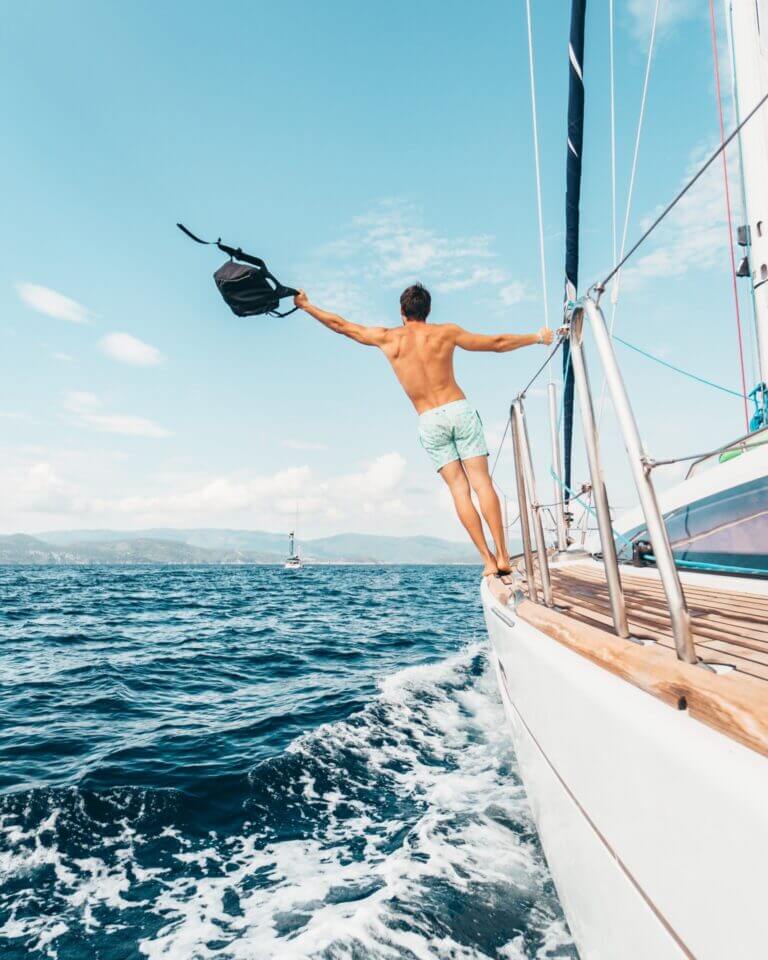
Navigating Life’s Storms: 7 Life Lessons from Sailing
Sailing is more than just a hobby; it is a lifestyle that can help you develop a wide range of skills and abilities. Whether you are a seasoned sailor or just starting, the 7 life lessons from sailing can be applied to various aspects of your life, from your personal relationships to your professional endeavors….
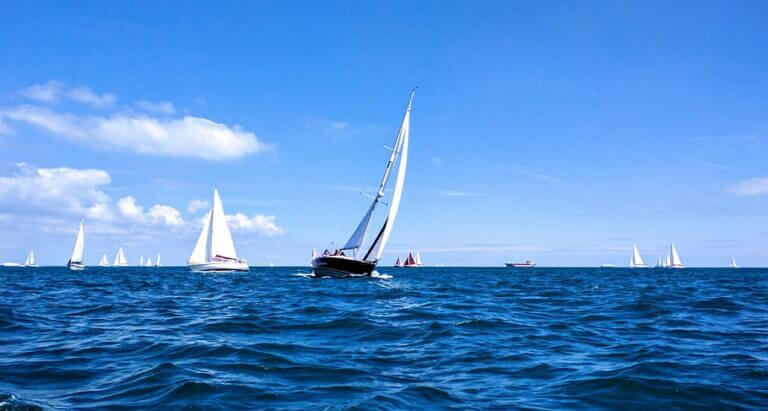
10 reasons why sailing is the best way to travel
Are you feeling restless and looking for a new way to explore the world? Tired of being cooped up in airplanes, trains, or cars for hours on end? Well, why not try something different and embark on a sailing adventure? While I may not be a seasoned sailor myself, I can tell you that there’s…

Top Sailing Safety Tips for Beginner Sailors
Sailing on a yacht is a thrilling experience that allows you to explore the beauty of the open water. However, it’s important to prioritize safety when embarking on a sailing trip. Yacht safety is not only essential for the protection of those on board, but also for the boat itself. Neglecting safety protocols can lead…

What is Tacking? How to Tack and Commands
The world of sailing is vast and complex, with numerous techniques and concepts to grasp. However, one skill that should not be overlooked is tacking. In this article, we will delve into the intricacies of tacking, providing you with a comprehensive guide on how to tack a sailboat like a seasoned sailor. Understanding Tacking What…

9 Essential GPS Navigation Tips for Sailing
Sailing is an exhilarating experience that offers an escape from the hustle and bustle of everyday life. However, navigating the open water can be challenging, especially when it comes to staying on course and avoiding potential hazards. That’s where GPS navigation comes in. GPS technology has revolutionized sailing, making it easier and safer than ever…

Anchoring Tips for Beginners
Are you ready to set sail on a journey to become anchoring aficionados? Anchoring a sailing yacht may seem like a simple task, but let me tell you, it’s no small feat. It requires a blend of nautical knowledge, careful planning, and a dash of luck (and a pinch of salt, if you ask any…
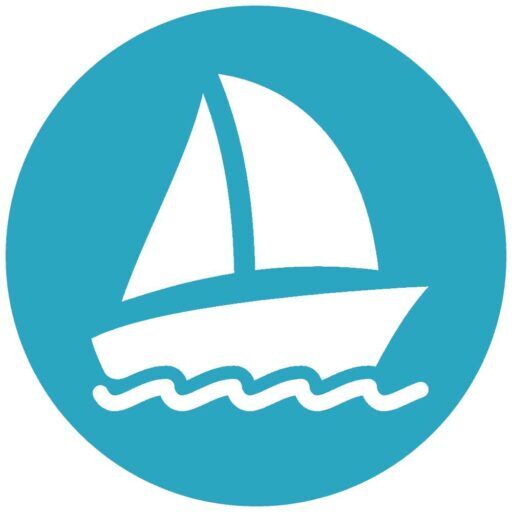
WaterCraft 101
Your guide to fun on the water!
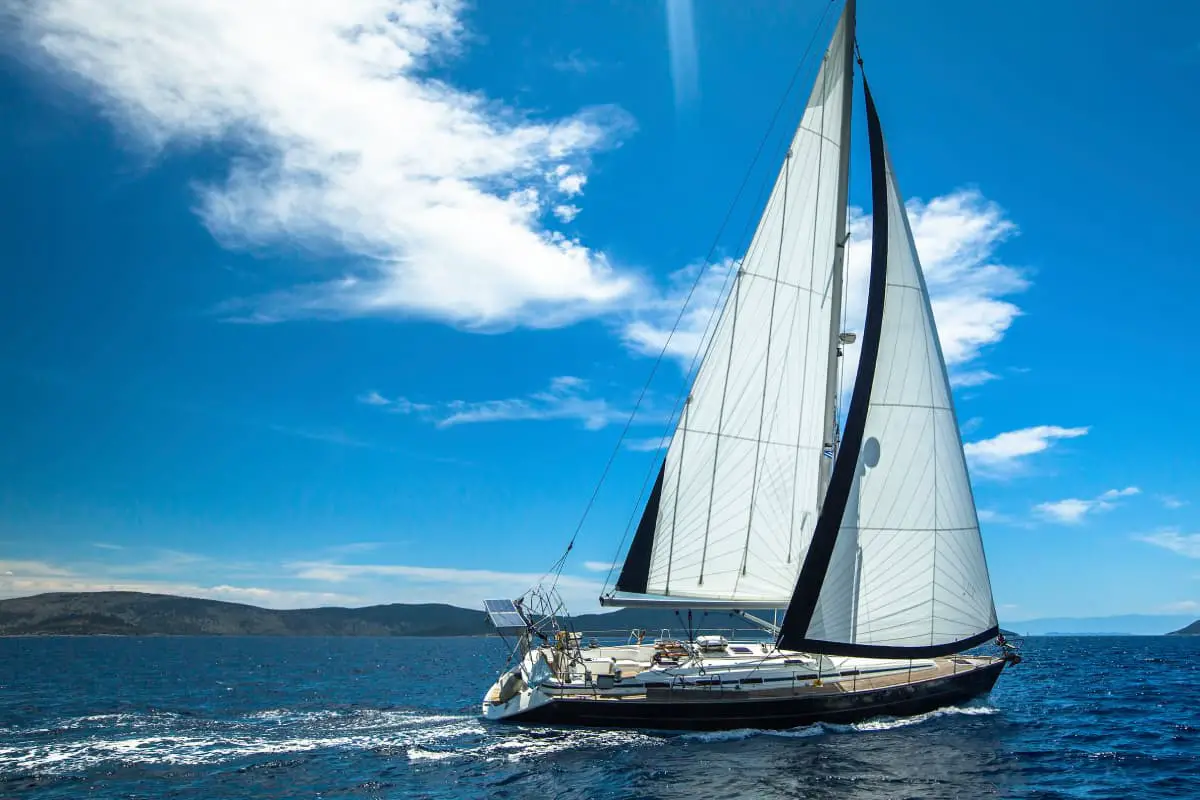
Why Do Sailboats Have Two Sails? (Explained)
If you’ve ever been sailing or watched a regatta, you’ll know that boats typically have two or more sails. It’s uncommon to see them with less than that. But what’s the reason behind this?
Sailboats have two sails to improve the boat’s maneuverability, balance, speed, and ease of handling. The front sail is called the jib, while the one behind it is the mainsail. Some boats have more than two sails to increase their stability and speed even further.
The way sailboats work is very interesting, so you’ll want to learn more! In this article, I’ll give you some in-depth explanations for why sailboats have two sails. So keep reading, everything you need to know is below.
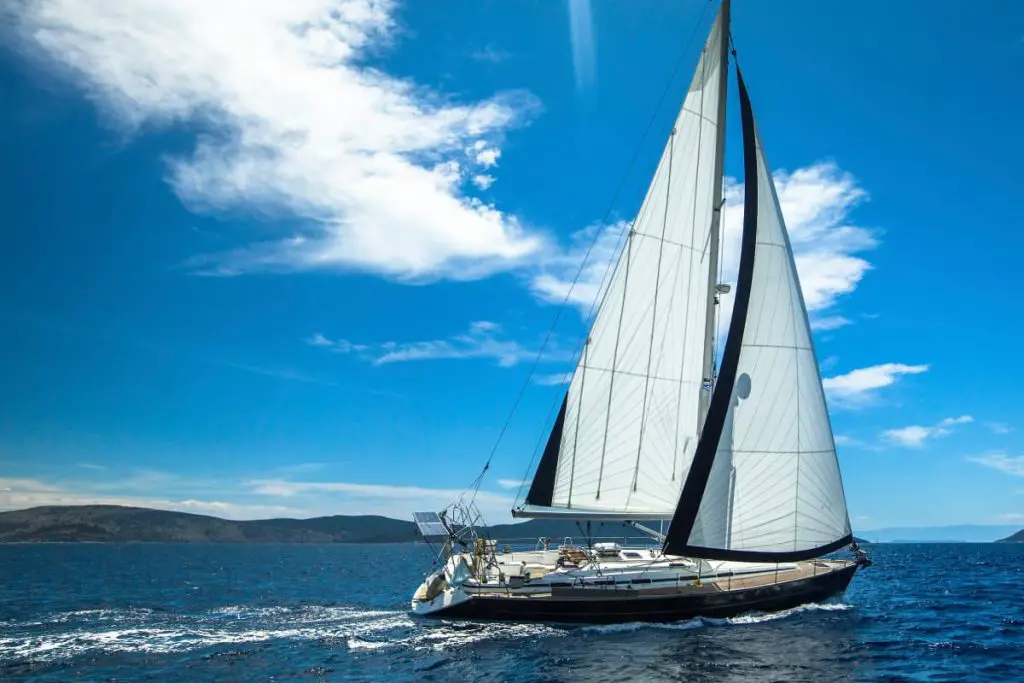
How Does Having Two Sails Help Sailboats?
It’s rare to see a sailboat with only one sail, and this might make you wonder what the science is behind this phenomenon. So, how does having two sails help sailboats?
Having two sails (a mainsail and a jib) helps sailboats by allowing the sailor to better maneuver the sailboat through the water, easily increase the boat’s speed, and have better handling over the boat overall. In short, having two sails offers improved control over the boat.
With all these benefits, sailors can handle their boats with ease. I’ll discuss these points in more detail below:
Two Sails Offer Greater Maneuverability
Many beginner sailers make the mistake of assuming that sailboats move because the wind exerts a force on the sails.
This is only partly true because when a boat has more than one sail, the wind’s current is split along the mast into two rough wind streams on either side of the sail. The space in front of the sail will have a low-pressure area, while the wind will create high pressure behind it. The pressure difference exerts a force on the sails that propels them forward.
The sail will move in the wind stream direction with the lowest pressure by being dragged forward.
The lowest-pressure wind stream gradually stabilizes, resulting in the wind moving faster on that side of the sail. This causes the sailboat to move because the wind is pulling the sail, and it is the same concept as an airplane’s wings creating lift .
Having Two Sails Allows for Increased Speed
A sailboat speeds up when a sail is perpendicular to the wind, with the wind blowing into the sail.
However, having two or more sails can help your sailboat go even faster. Some wind gets caught on your mainsail and some blows around it when you’re out on the water. The air that moves around the mainsail contributes to your sailboat’s acceleration, which you could further increase by adding another sail.
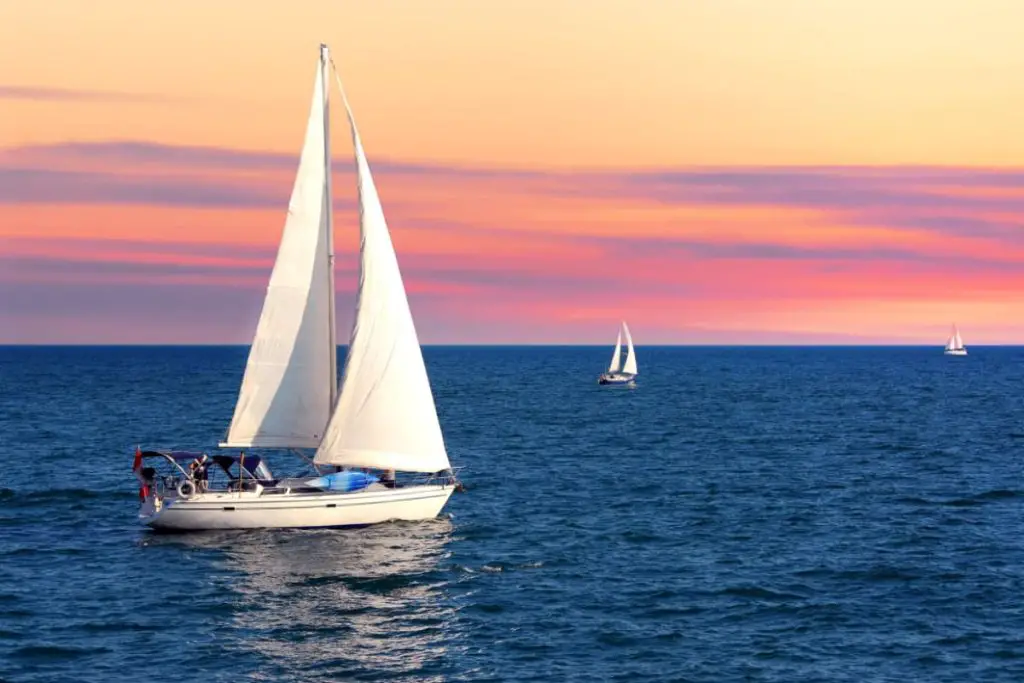
Two Sails Increases the Ease of Handling
When boats have two sails, you can handle them much easier. This is because all boats have a pivot point located behind the mast. Most of the mainsail’s surface area is behind the pivot point.
If you were to sail your boat with only the mainsail, the wind’s force behind the pivot point would be greater than the force in front of it. The sailboat would then tend to turn in the wind’s direction.
In a strong wind, sailing with only the mainsail would mean that your rudder wouldn’t be powerful enough to steer the sailboat, and you would need to rely on the mainsail to steer your boat.
However, adding a jib to your sailboat would balance out the force from the mainsail, making it easier for the sailor to handle and making the boat more stable.
A sailboat’s keel helps keep it upright by compensating for the wind’s sideways forces. However, you adjust the jib slightly to move the sailboat in another direction, proving that having two sails helps you control your sailboat more effectively.
What Are Boats With Two Sails Called?
Boats with two sails are called cutters or sloops. Both have a mast with two sails, but a cutter has two foresails, while a sloop has a mainsail and a jib. Ketches are also sailboats but feature more than one mast with multiple smaller sails.
There are a variety of sailboats out there. Below is some more information about these three sailboat varieties:
Cutter: Sail Configuration
Like sloops, cutters have a single mast. Unlike sloops, cutters usually have two headsails. Cutter headsails tend to have a lower center of gravity than the jib sail of sloops, giving cutters more stability and better control in rough conditions. Cutters are commonly seen in Bermuda-rigged or gaff-rigged configurations.
Regardless of the configuration, cutter rigging is more complex than the rigging of most sloops. This makes them a bit more challenging to handle single-handed.
Sloop: Sail Configuration
When most people think about sailboats, this is the one they see in their minds. The classic single mast, double sail configuration with a Bermuda rig is fun to sail and reasonably easy to control. The high-profile mast does, however, make them easier to capsize in rough conditions.
While the Bermuda rig is the most popular configuration for sloops, it is not the only one. Some sloops feature fractional sloop rigs or specially designed racing rigs. Fractional sloop rigs offer more stability options and usually are preferred for extended offshore use. As you may have guessed, Racing rigs are designed for speed and maneuverability.
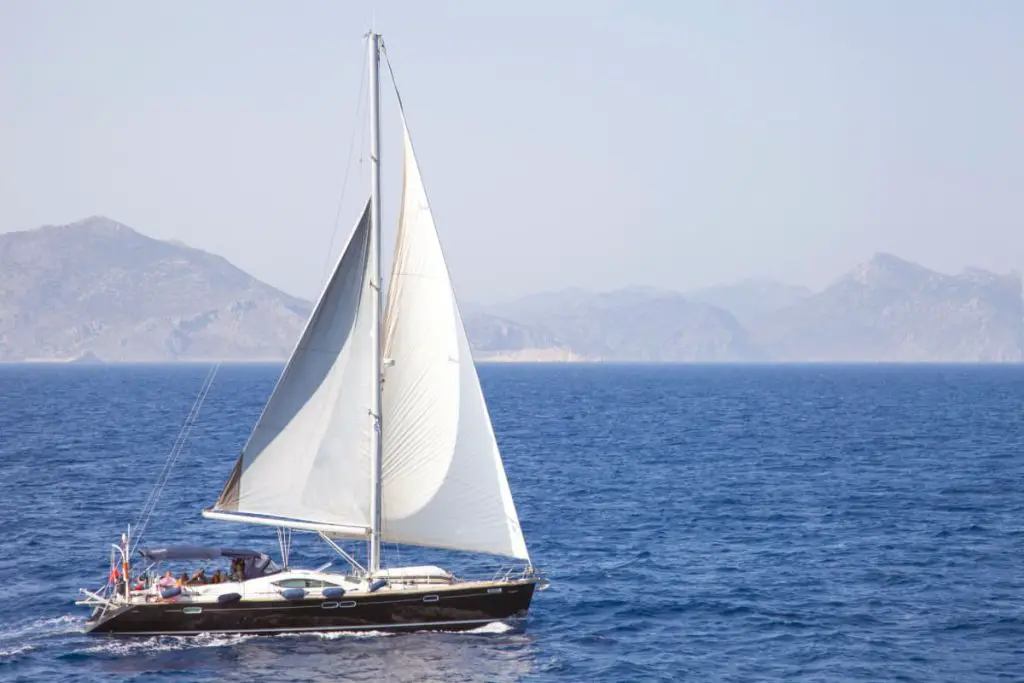
Ketch: Sail Configuration
We’ll now take a short visit to touch on a type of sailboat with more than one mast. Ketches feature a taller mainmast near the front of the boat and a shorter mast near the rear. The shorter mast is called the mizzenmast.
This split rig divides the sail plan into smaller components than a single mast sailboat. A ketch can be either Bermuda-rigged or gaff-rigged. Ketches usually have smaller sails and shorter masts than sloops or cutters, making them easier to control in difficult weather conditions.
Though generally slower than their single mast cousins, sailors who prefer safety over speed tend to favor ketches for their durability and the peace of mind that comes from having a second mast.
Yawls are closely related to ketches, yet the mizzenmasts are set further back.
Why Do Sailboats Have Two Sails – Final Thoughts
Sailboats have two sails as they allow the sailor to:
- Enable better maneuverability
- Increase their traveling speed
- Improve the sailboat’s ease of handling
Sailboats with two sails and one mast can be either sloops or cutters.
Bryan is a Las Vegas resident who loves spending his free time out on the water. Boating on Lake Mohave or Lake Havasu is his favorite way to unwind and escape the hustle and bustle of the city. More about Bryan.
Similar Posts
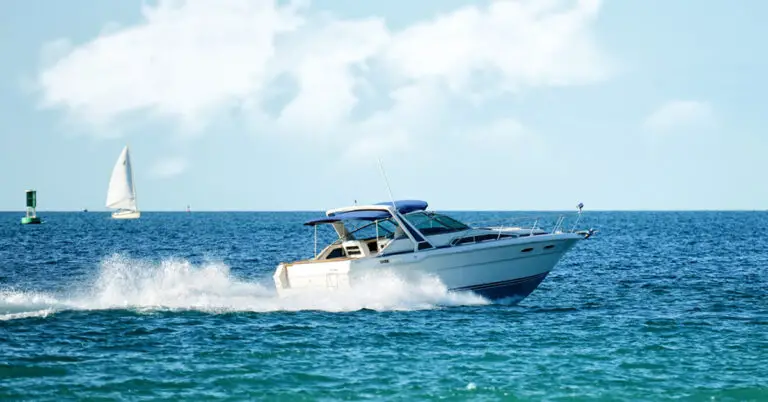
Sailboat vs. Powerboat: Which Is the Give-Way Vessel? Understanding Navigation Rules on the Water
Navigating the waters is an exciting adventure, whether you’re at the helm of a sleek sailboat or commanding a powerful motorboat. However, along with this thrilling journey comes the responsibility of understanding and adhering to the marine navigation rules, specifically those concerning the right of way or the “give-way” vessel. This aspect is vital to…
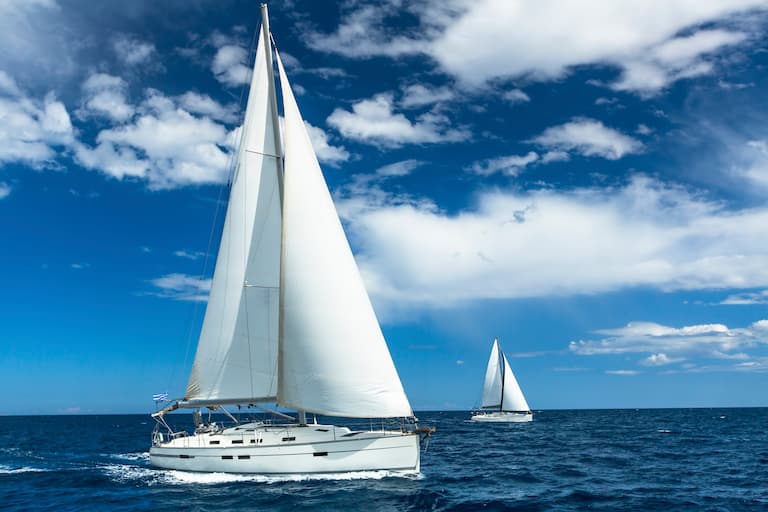
How Tight Should Sailboat Lifelines Be? (Need to Know!)
A lifeline is a safety device frequently found on sailboats and on construction sites. It’s composed of wire and stanchions, which are secured around the ship’s perimeter to prevent passengers from being thrown overboard or accidentally falling. But how tight should they be? Sailboat lifelines should be tight enough so they only stretch about two…
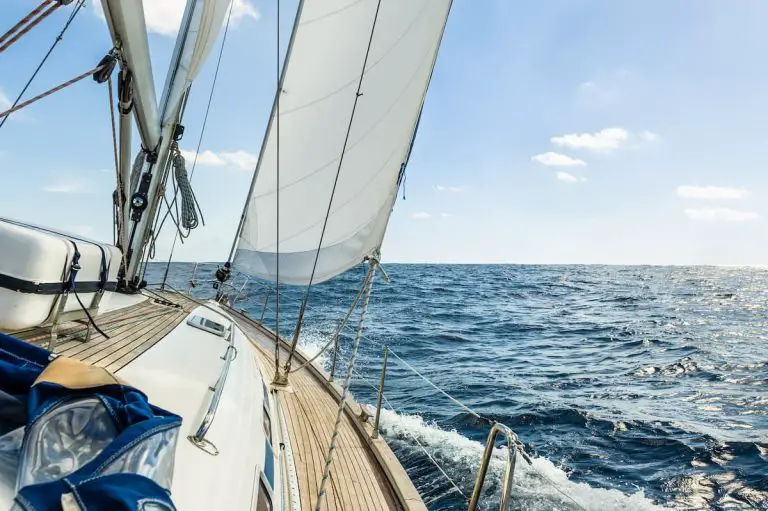
How Far Can a Sailboat Heel? (The Simple Answer)
Heeling is when a sailboat leans to one side, which can occur naturally or deliberately. When done deliberately, proper heeling enables a sailboat to travel faster. This, in turn, begs the question of how far a sailboat can heel? The optimal heeling range for sailboats varies by model and preference but usually sits between 10…
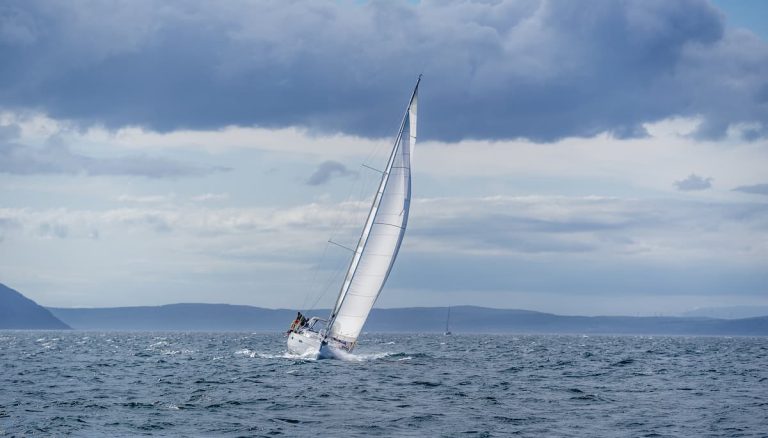
What To Do When a Sailboat Is Heeling Too Much (Explained)
Sailing is a fun activity for many people, but it comes with the innate prerequisite of being on the water rather than on stable ground. Aspiring captains must learn how to navigate and operate a boat while it rocks around in the water, which means dealing with things like heeling (i.e., leaning too far to…
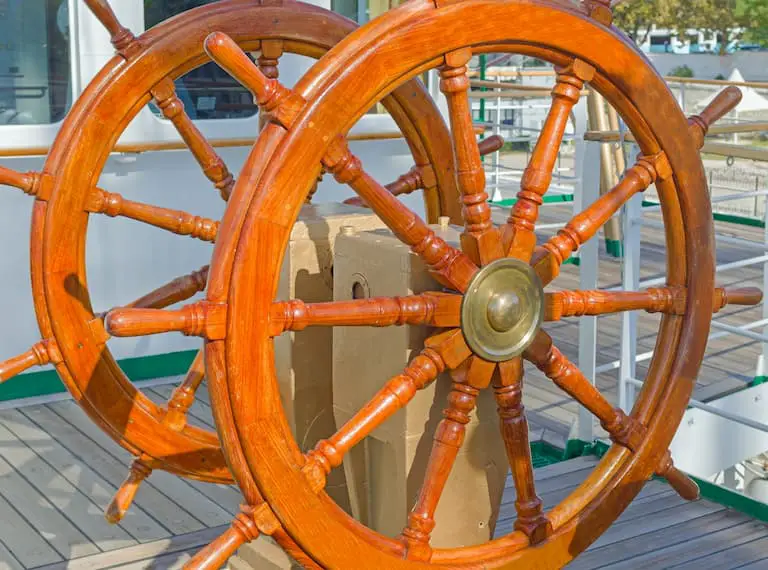
Why Some Sailboats Have Two Helms (Dual Helms Explained)
While most sailboats have a single helm with a steering wheel in the center, some larger sailboats or racing boats may have two helms. So, why do these sailboats have double helms? Are there any practical benefits of two helms on sailboats? Some larger sailboats have two helms as it helps with steering from different…

How Much Do New Sails Cost?

Last Updated by
Daniel Wade
June 15, 2022
Sails are one of the most important parts of your sailboats. They're your engine or essentially, what propels your sailboat. Buying a new one is, without a doubt, a hefty if not expensive investment. You should, therefore, learn all about different types of sails, how much they cost, and how to buy them.
Sails are one of the most important parts of a sailboat. In addition to propelling the boat, sails play an integral role in efficiency and safety when sailing. Having high-quality sails not only makes your boat heel less but can also prevent your sailboat from rounding up into the wind in gusts. It can also reduce weather helm, make steering a lot easier, make you go faster, and make sailing more enjoyable even when short handed. In short, proper sails will improve reliability, increase speed, and improve your boat's handling characteristics.
Unfortunately, sails do not last forever. They'll, at one point, wear out and you'll need to buy new ones. To make it even worse, new sails are a huge investment; one that you hope to never make any time soon. But how much do new sails cost? Well, let's find out in this guide.
The prices of buying new sails vary greatly depending on several factors such as your boat's length, sail material, quality of the fabric, and many others. For instance, a 24-feet Bermuda sloop can cost between $1,000 and $2,500 while sails on mid-sized boats can cost between $3,000 and $5,000. The price of a new sail will, of course, depend on how long the piece is.
In this comprehensive guide, we'll walk you through the process of buying sails, their prices, and making sure that you do not make a costly mistake when buying new sails.
Table of contents
How Can You Know that Your Sails Have Had Their Best Days?
Although sails are quite expensive, they seem to last forever especially on cruising sailboats . Without the stresses of competition or a yardstick of measuring whether your sails are appropriate or inappropriate for racing, it can be a lot harder to tell if your sails have worn out and need to be replaced.
This can give you a false sense of security that your sails are still in a working condition. So how do you know that your sails have had their day and what's the best time to upgrade to new sails? Well, you can know that your sails are worn out if they become saggy and dangerously long in the tooth or if they can no longer drive you upwind off a lee shore. If anything, you shouldn't wait until a self-destruct moment to buy new sails.
In essence, you should know that it's the right time to change the sails if it doesn't make economic sense to service or repair them. You should also change the sails if they absolutely refuse to work when you're trying to trim. This is because the sailcloth will break down or become extremely elastic to the point that you can no longer apply enough force to the corners or on the edges even when sailing in light winds.
How to Assess the Structural Strength and Damage of Your Existing Sails
When assessing the structural strength and damage of your existing sails, it's essential to know areas that are prone to tear and wear. While you should inspect every area of the sails you should put a lot of emphasis on the inboard batten pocket, the leech, and spreader patches.
You should also remember that stitching on your sails will get damaged by the sun and chafe long before the material itself. And because buying new sails is a huge investment, you should consider re-stitching the damaged parts if it means extending the sail's life. So how can you know that the stitches are damaged? Well, just rub your thumbnail along with the stitches. If you can pull them out easily, then they're weak and should be re-stitched. It would be appropriate to do it at an early stage to prevent it from becoming worse.
You can also assess the leech and see if it's in a working condition. You can do this by trying to poke your thumbnail into the weave fabric. If it's possible to poke the weave fabric, then it's in a bad state. That's not all; you should as well assess batten pockets for any form of damage or any worn-out patches on the sail.
As we noted earlier, you should know that your existing sails have seen their best day if they don't make any financial sense to repair or service them.
Different Types of Sails
When buying new sails, it's important to have even the slightest idea of the mainsail types. There are four main types of sails.
Mainsails - These include mizzen on yawls and ketches. They're the main driving force and should be fitted with anything ranging between one and four reefs.
Foresails - These include genoas, jibs, and can be used on cutter-rigged boats. Most boats have a single roller curling foresail. However, some have single-standing sails that are designed in different shapes and sizes but optimized for varying wind strengths. For example, you can use larger foresails when the winds are stronger and smaller foresails when the winds are somehow calmer.
Downwind Sails - These are symmetric and asymmetric spinnakers, as well as code zeros, and cruising chutes.
Storm and Heavy Weather Sails - These are storm jibs and trysails that are essential for safety, especially if you're often sailing offshore and may encounter challenging conditions. Given that reefing genoas have incompetent shapes especially when extremely reefed in heavy winds, it's recommended to have a smaller but heavier weather jib. This can be set as part of a removable inner forestay. In essence, this can be a crucial addition to your sail suit.
Choosing Sail Materials
The type of sail material that you choose when buying a new sail is another crucial thing to consider. Nearly two decades ago, the only viable option for sail material was woven Dacron. As such, the only thing to consider in terms of sail material was the grade of the woven Dacron. Sailors could choose between more durable but stiffer woven Dacron meant for cruising and a stiff, highly-resinated material used for racing.
Things, however, have changed recently thanks to technological advances. There is a wide range of sail materials with each having its own advantages and disadvantages. Let's look at the available sail materials.
Woven Dacron - This is not only one of the most durable sail materials but remains the least expensive option. The only downside is that it tends to lose shape quickly and may not retain the appropriate shape even when there's still more life left in the material.
Keep in mind that Dacron materials aren't made the same. There are Dacron materials meant for cruising sailboats . They generally use materials with the permeated finish. This is done by soaking the material in glue to bind the yarns together. Although this ensures that the material is softer and more long-lasting, the material will stretch more in strong winds, especially when it's still new.
On the other hand, there are Dacron materials used in racing sailboats. They're usually coated with a hard melamine finish to reduce stretch.
Hydrant Woven - These materials incorporate Dyneema fibers on the sails. This is fundamental in increasing resistance to substances such as ultraviolet degradation and chafe while also increasing durability and endurance. That's not all; the Dyneema fibers are known to help the sails maintain their original shape.
Laminate Sails - These are designed with load-bearing structural fibers that are crammed between two sheets of Mylar film. Several types of fibers such as carbon, polyester, Kevlar, and Twaron can be used.
However, the cost of fibers such as polyester and carbon tend to be expensive, which means that these sails might be a little costly. These materials can retain their original shape longer than other materials but have the shortest lifespan. But to increase durability, sailmakers do add taffeta layers on both sides but you may have to deal with a heavier and costly material.
String/Membrane Sails - These are molded in one piece using fibers that are aligned by following the exact load paths in the sail. These fabrics are effectively custom made and reinforced in the right places not just to maintain their original shapes but also to ensure that they remain durable.
Keep in mind that these materials are high-end products that can be costly and are mostly used in racing sailboats. This doesn't, however, mean you can't use them on your cruising sailboat . In fact, these sails are very appropriate for long voyages.
To this end, an appropriate sail material should be able to offer extraordinary durability and desirable shape retention. These are two important features to look for when buying new sails for your boat. So when buying new sails, make sure that you ask about the above-mentioned features as well as the weight of the material. Although woven Dacron is the standard material for sails, you can choose from other materials too as long as they suit your specific needs. More importantly, make sure that the prices and quality are within your specific and reasonable budget.
The Weight of the Material and Additional Extras
The weight of material used in making your sails may seem like a minute factor but it's of great importance. The idea here is that heavier material will generally be stronger and last longer. This should, therefore, depend on what you actually need but a heavier material will make the sail heavier.
In terms of additional extras, you should make sure that you ask what comes with the sails. For example, do they come with bags that can be of any use to you when out there on the water? This can be of great importance if you want to buy headsails that must be carried to the deck and hooked up. If this is the case, the bag should be bigger and longer to make carrying and transporting the headsail a lot easier.
You can also ask for boom covers. These are essential in protecting mainsails from various substances, especially when not in use. In essence, these extras are important in preserving and maintaining the life and conditions of your new sails. You should, thus, take advantage when negotiating for the new sails as it is these extras that sailmakers are willing to give out if it means making a sale.
How to Buy New Sails
Here is how to buy new sails.
Have Your Boat's Measurements
One of the most important factors that when buying new sails is your boat length. This is because the sail area is mostly determined by the boat length. If your sailboat is of popular design, the sailmaker may have enough information to make the right sail size. But if your boat is not that popular, you can take a few measurements to make it a lot easier for the sailmaker when giving you a quote. In most cases, you'll be given a form to fill in the information that the sailmaker needs in terms of measurements or anything else that might be of importance when choosing the right sails for your boat.
How Do You Want to Use the Sails?
It's very important to consider the type of sailing you're planning to do with your new sails. In most cases, there should be a fine balance between conflicting elements. For instance, the sails should be easy to handle, durable, and cost-effective. But to maintain this balance, you should always have an idea of what you want to use the boat for or how you'll be using the boat. For example, how often will you be sailing? Are you planning for long voyages? How many people do you usually sail with? Do you pick your sailing days or go out on the water irrespective of the weather?
Focus on the Detail
Do you want asymmetrical sails, symmetrical sails, or storm jibs? Are you planning to upgrade to roller reefing or will you go for a cruising chute? You should make the right choices in terms of design and the type of sail that you want. Keep in mind that more sophisticated designs such as tri-radial and bi-radial designs may be a little expensive. All in all, make sure that you put a lot of emphasis on buying sails that optimize the performance of your boat.
Choose the Right Fabric and Design
In addition to choosing the right fabric for the sails, you should make sure that the new mainsails have the right number of reefs. Ensure that each of the reefs is deep enough. You should as well decide whether to go with long or short battens.
If you're planning to use your sailboat for racing, mainsails with short battens could be the best option. This is because short battens offer more control in terms of speed, maneuverability, and acceleration. On the other hand, long battens are the best option for cruising sailboats as they are more durable even though they may come at an extra cost.
Generally, sails are often sold with standard two reefs but three reefs would be ideal for offshore sailing. This is to make it easier for you to reduce the sails to appropriate sizes in heavy weather or stormy conditions. The third reef will be essential in reducing the luff length by at least 40%. Again, you can choose sails with four reefs if you're planning to go for long voyages as this will eradicate the need to have trysails.
Compare Quotes
It's important to talk to a number of sailmakers to compare different designs and prices. The designs should be similar but prices will vary from design to design. You should, therefore, compare the prices of similar designs. You should also ask the sailmakers for detailed info on their designs and how much each design would cost you.
Estimated Costs for Different Boat Lengths
As we noted earlier, the costs of new sails will not only depend on the type of material and designs of the sails but also on the length of your sailboat. Let's highlight the estimated costs.
The Estimated Costs of Replacing a Jibs and Genoas
- Sails for boats measuring 42' to 50' can cost around $5,500-$9,000
- Sails for boats measuring 36' to 42' can cost around $4,000-$7,000
- Sails for boats measuring 32' to 36' can cost around $3,000-$5,000
- Sails for boats measuring 24' to 32' can cost around $2,500-$4,000
- Sails for boats measuring 18' to 24' can cost around $1,000-$2,500
The Estimated Costs of Replacing Mainsails on Bermuda Sloop Rigs
- Sails for boats measuring 42' to 50' can cost around $2,500-$4,000
- Sails for boats measuring 36' to 42' can cost around $2,000-$3,000
- Sails for boats measuring 32' to 36' can cost around $1,500-$2,500
- Sails for boats measuring 24' to 32' can cost around $1,000-$1,500
- Sails for boats measuring 18' to 24' can cost around $650-$1,200
It's important to note that these are estimated costs that should give you an idea of what to expect when buying new sails. It would, however, be appropriate to get a quote from a professional sailmaker, and most of them are willing to help.
The Aging Process of Your Sails
Whether you've just bought new sails or still using the old ones, the aging process of sails may depend on several factors such as the materials used, the type of use you subject them to, and the level of care you give them. That being said, it's almost impossible to accurately determine the lifespan of your sails based on the number of miles you've covered on the water or the number of years you've used the sails.
The most important thing to keep in mind is that the shapes of the sails will change gradually without you realizing it. You should, therefore, check regularly to see if there are changes in the shapes of your sails. You can also take photos occasionally to determine the changes in shape over time.
This can be a great way of assessing not just the shapes of your sails but also in monitoring both the performance and the type of handling that new sails will provide. The idea is that new sails cannot instantly move from good to bad. They'll stretch as they age and this can lead to change in shapes. When your sails lose shape, they will not point well and steering will become difficult. This will, in turn, make your boat to drag, increase heel, and ultimately reduce speed.
Prolonging the Lifespan of Your Sails
Although sails can last a long time, they'll not last forever. Replacing your older sails with new ones will instantly increase the speed and handling capabilities of your boat. Here's how you can prolong the lifespan of your new sails and protect your sail investment.
- Do not expose your sails to unnecessary sunlight and heat
- Motor your sails down if they cannot be filled or if they are not in use
- Avoid extended flogging and luffing
- Use the appropriate halyard tension
- Protect your sails from chafe
- Take off the sails when not in use
- Rinse the sails with fresh water from time to time
- Dry the sails before storing
It's a known fact that sails don't last forever. While it's difficult to exactly determine how long the sails will last, it's a good idea to replace your sails before they become severely stretched and out of shape. Using old or worn-out sails can make a huge difference in the way your boat sails and handles. Just like you'd replace worn-out tires or an old engine on your car, replacing worn out sails with new ones will improve how your boat sails. This will give you a greater sense of control and going out on the water will be more fun.
Unfortunately, buying new sails can be a costly endeavor. That's why you should be well prepared and armed with lots of information when buying new sails. In addition to having in mind what new sails would cost you, you should know how to choose the right material for the sails and the type of sails that can be perfect for your sailing.
Don't wait until you experience serious structural failure with older sails to buy new ones.
Related Articles
I've personally had thousands of questions about sailing and sailboats over the years. As I learn and experience sailing, and the community, I share the answers that work and make sense to me, here on Life of Sailing.
by this author
Sailboat Upgrades
Financial and Budgeting
Most Recent

What Does "Sailing By The Lee" Mean?
October 3, 2023

The Best Sailing Schools And Programs: Reviews & Ratings
September 26, 2023
Important Legal Info
Lifeofsailing.com is a participant in the Amazon Services LLC Associates Program, an affiliate advertising program designed to provide a means for sites to earn advertising fees by advertising and linking to Amazon. This site also participates in other affiliate programs and is compensated for referring traffic and business to these companies.
Similar Posts

Best Bluewater Sailboats Under $50K
December 28, 2023

How To Choose The Right Sailing Instructor
August 16, 2023

Cost To Dock A Sailboat
May 17, 2023
Popular Posts

Best Liveaboard Catamaran Sailboats

Can a Novice Sail Around the World?
Elizabeth O'Malley

4 Best Electric Outboard Motors

How Long Did It Take The Vikings To Sail To England?

10 Best Sailboat Brands (And Why)
December 20, 2023

7 Best Places To Liveaboard A Sailboat
Get the best sailing content.
Top Rated Posts
Lifeofsailing.com is a participant in the Amazon Services LLC Associates Program, an affiliate advertising program designed to provide a means for sites to earn advertising fees by advertising and linking to Amazon. This site also participates in other affiliate programs and is compensated for referring traffic and business to these companies. (866) 342-SAIL
© 2024 Life of Sailing Email: [email protected] Address: 11816 Inwood Rd #3024 Dallas, TX 75244 Disclaimer Privacy Policy
- Types of Sailboats
- Parts of a Sailboat
- Cruising Boats
- Small Sailboats
- Design Basics
- Sailboats under 30'
- Sailboats 30'-35
- Sailboats 35'-40'
- Sailboats 40'-45'
- Sailboats 45'-50'
- Sailboats 50'-55'
- Sailboats over 55'
- Masts & Spars
- Knots, Bends & Hitches
- The 12v Energy Equation
- Electronics & Instrumentation
- Build Your Own Boat
- Buying a Used Boat
- Choosing Accessories
- Living on a Boat
- Cruising Offshore
- Sailing in the Caribbean
- Anchoring Skills
- Sailing Authors & Their Writings
- Mary's Journal
- Nautical Terms
- Cruising Sailboats for Sale
- List your Boat for Sale Here!
- Used Sailing Equipment for Sale
- Sell Your Unwanted Gear
- Sailing eBooks: Download them here!
- Your Sailboats
- Your Sailing Stories
- Your Fishing Stories
- Advertising
- What's New?
- Chartering a Sailboat
- Sail Dimensions
What Sail Dimensions are Required to Calculate Sail Areas?
The required sail dimensions for calculating the area of any triangular sails are usually its height and the length of its foot. But that only works for mainsails and mizzens with no roach, and jibs with a 90 degree angle at the clew - and what about high-cut headsails, spinakers and cruising chutes? Read on...
Foresail and mainsail dimensions are universally referenced with the letters 'J', 'I', 'E' and 'P' approximating to the length of the foredeck, height of the mast, length of the boom and the height of the main sail - but more accurately defined further down this page.
Yacht designers need these sail dimensions to calculate thought provoking stuff such as the sail-area/displacement ratios of their creations, and sailmakers need them before they put scissors to sailcloth.
If our sailboat's sails were perfectly triangular then, as every schoolboy knows, their area would be 'half the height, times the base' - but with the possible exception of a mainsail with a straight luff, generally they're not. Here's how it works...
Main and Mizzen Sail Dimensions
These are almost right-angled triangles except for the curvature of the leach (the 'roach') which increases the sail area.
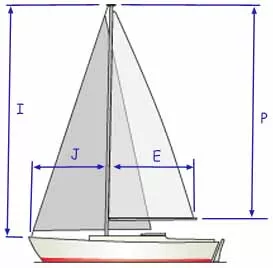
It's usually calculated as:~
Area = (luff x foot)/1.8, or
Area = ( P x E )/1.8, where:~
- 'P' is the distance along the aft face of the mast from the top of the boom to the highest point that the mainsail can be hoisted, and
- 'E' is the distance along the boom from the aft face of the mast to the outermost point on the boom to which the main can be pulled.
For the mizzen sails on ketches and yawls , 'P' and 'E' relate to the mizzen mast and boom.
For more heavily roached sails, the increased area can be accounted for by reducing the denominator in the formula to 1.6.
Clearly calculating sail areas isn't going to be an exact science...
Jibs, Genoas and Staysail Dimensions
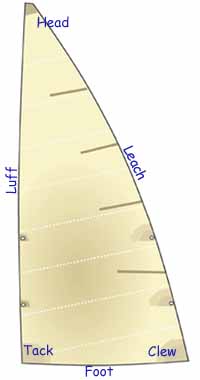
For a working jib that fills the fore triangle - but no more - and with a foot that's parallel to the deck, then you've got a 'proper' right-angled triangular sail, whose area is:~
Area = (luff x foot)/2, or
Area = ( I x J )/2, where:~
- 'I' is the distance down the front of mast from the genoa halyard to the level of the main deck, and
- 'J' is the distance along the deck from the headstay pin to the front of the mast.
Genoas, by definition, have a clew which extends past the mast and are described by the amount by which they do so. For instance a 135% genoa has a foot 35% longer than 'J' and a 155% genoa 55% longer. Areas are calculated as follows:~
Area (135% genoa) = (1.44 x I x J )/2, and
Area (155% genoa) = (1.65 x I x J )/2
High-cut Headsails
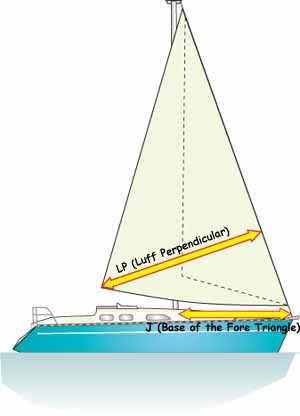
But these formulae don't work for a high-cut jib with a raised clew - unless you imagine the sail turned on its side such that the luff is the base and the luff perpendicular is the height.
It's still a simple calculation though, once you know the length of the luff perpendicular ( LP ), the sail area is:~
Area = (luff x luff perpendicular)/2, or
Area = ( L x LP )/2, where:~
- 'L' is the distance along the forestay from the headstay pin to the front of the mast, and
- 'LP' is the shortest distance between the clew and the luff of the genoa.
Spinnaker Sail Dimensions
Much like calculating foresail areas, but with different multipliers for conventional spinnakers and asymmetric spinnakers...
Conventional Spinnakers
Area = (0.9 x luff x foot), or
Area = (0.9 x I x J ), where:~
- 'I' is the distance from the highest spinnaker halyard to the deck, and
- 'J' is the length of the spinnaker pole.
Asymmetric Spinnakers
Area = (0.8 x luff x foot), or
Area = (0.8 x I x J ), where:~
- 'I' is the distance from the highest spinnaker halyard to the deck, and
- 'J' is the distance from the front face of the mast to the attachment block for the tackline.
More about Sails...

Are Molded and Laminate Sails One Step Too Far for Cruising Sailors?
Although woven sails are the popular choice of most cruising sailors, laminate sails and molded sails are the way to go for top performance. But how long can you expect them to last?
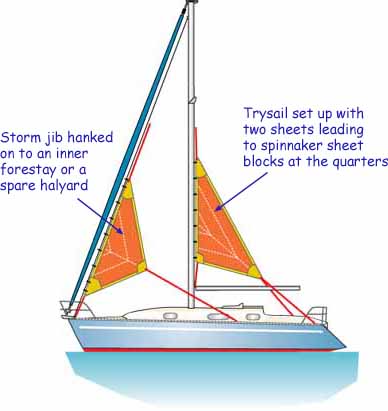
Is Carrying Storm Sails on Your Cruising Boat Really Necessary?
It's good insurance to have storm sails available in your sail locker if you are going offshore, and these are recommended fabric weights and dimensions for the storm jib and trysail
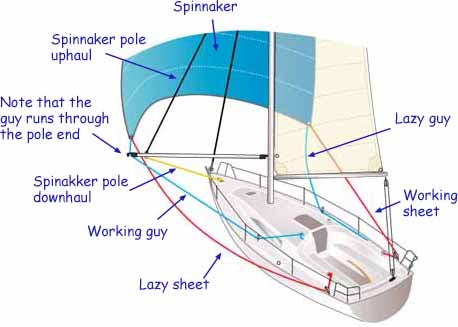
Using Spinnaker Sails for Cruising without the Drama!
When the wind moves aft and the lightweight genoa collapses, you need one of the spinnaker sails. But which one; conventional or asymmetric? Star cut, radial head or tri-radial?

The Mainsail on a Sailboat Is a Powerful Beast and Must Be Controlled
Learn how to hoist the mainsail, jibe it, tack it, trim it, reef it and control it with the main halyard, the outhaul, the mainsheet and the kicker.

Is Dacron Sail Cloth Good Enough for Your Standard Cruising Sails?
Whilst Dacron sail cloth is the least expensive woven fabric for standard cruising sails, do the superior qualities of the more hi-tech fabrics represent better value for money?
Recent Articles
Apla 42 Sailboat Specs & Key Performance Indicators
Aug 30, 24 02:51 AM
Ovni 445 Sailboat Specs & Key Performance Indicators
Aug 29, 24 03:44 AM
Catalina 34 Sailboat Specs & Key Performance Indicators
Aug 29, 24 12:14 AM
Here's where to:
- Find Used Sailboats for Sale...
- Find Used Sailing Gear for Sale...
- List your Sailboat for Sale...
- List your Used Sailing Gear...
Our eBooks...

A few of our Most Popular Pages...

Copyright © 2024 Dick McClary Sailboat-Cruising.com

My Cruiser Life Magazine
What are Those Numbers on Sails? More #BoatLife Knowledge
Have you ever noticed how most sailboats have numbers on their sails? It’s one of those small details that you might not think much about.
But depending on what sort of boat you run, those numbers might carry a lot of meaning. Pretty much every boat has sail numbering, but they mean different things to different sailors.
Here’s a look at what those numbers mean and how to choose and install them if you’re ready to be noticed on the water.
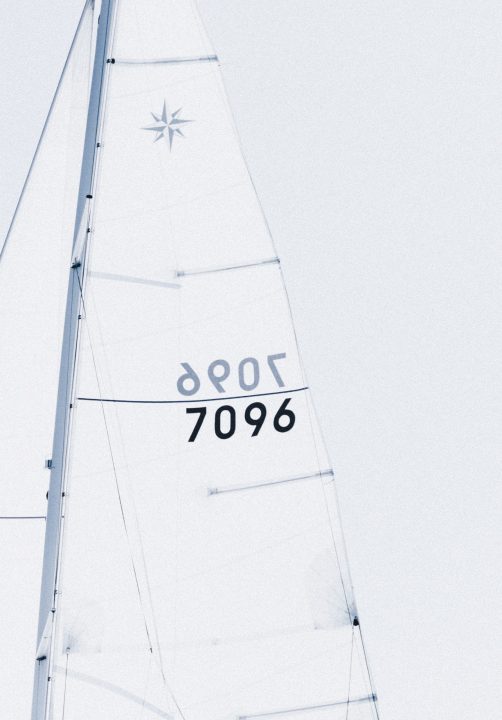
Table of Contents
What are sail numbers and what do they mean, factory numbers, one-design or class numbers (like international laser class association), racing yachts and sail number racing rules, cruising boats – owner’s choice, how to pick your numbers, how to apply sailboat numbers, sail numbers and numbers of sails, faqs – questions about sail numbering.
First off, the purpose of sailboat numbers is solely to make your boat easily identifiable from a long way away. In many instances, a group of sailboats looks indistinguishable from one another from shore. Numbers are usually shown on the mainsail, but many racing boats have them installed on every sail they have.
One thing that sail numbering is not is an official registration or documentation number. There are some cases when the number is unique and traceable, but not by any legal state authority.
In most cases, the cruising sailor will say, “so what?” But if you think about it, sail numbers can help another boat identify you and call you on the radio. For example, instead of calling the “White hulled sailboat off of Cape Henry,” a ship could call “Sailboat number 99 near Cape Henry.” That’s a lot more specific and a lot more likely to get your attention. Sail numbers are very easy to read through binoculars, after all.
In contrast, racing sailors are often identified by their numbers. In a racing class, where every boat is identical, the only distinguishing attribute on the entire boat is the number on the sails.
The same is true in the offshore racing world. Many offshore racers have unique numbers assigned by the racing governance boards in their home countries.
Four Types of Sailboat Numbers
So let’s take a closer look at the various types of numbers that might be displayed on a boat’s sails.
This one is for most cruising boats. When the boat is delivered from the factory, they install sails made by their sailmaker. These will always include the boat maker’s logo and some identifying number. Usually, this is a sequential hull number.
For example, my boat displays the distinctive CR38, indicating that it is a Cabo Rico 38. The number 99 refers to the boat’s hull number off of the factory line. Therefore, it is the 99th Cabo Rico 38 that the company made.
This system is entirely random, of course. A builder might choose a different scheme to use or put no numbers on the sails at all.
On another note, sails don’t last forever. Most sailors have to buy new sails every decade or so, and in doing so, no rule says they need to stick with the same numbering scheme the manufacturer did.
For class racing, the numbers are significant because they are often the only way to tell the boats apart while they’re on the water. The whole idea of class racing is that the boats are identical, and only the sailor’s skills win the race.
Each class association issues numbers and class rules dictate precisely how and where the number is displayed.. For example, the International Optimtimis Dinghy Association (IODA) issues numbers for several small classes.
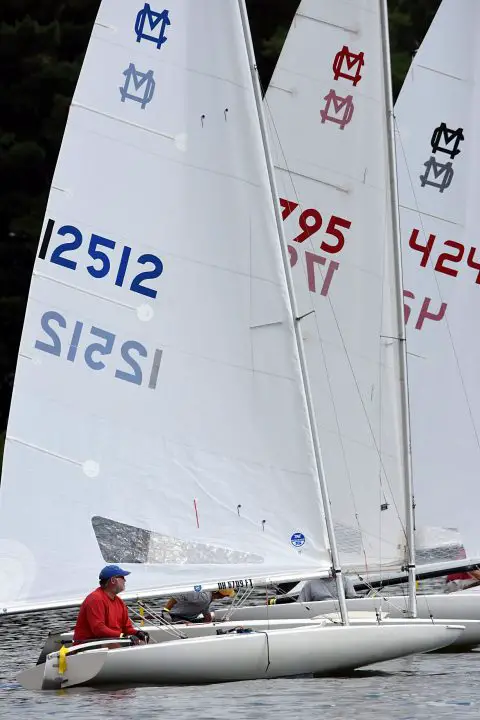
If larger boats are raced offshore in big competitions, it is usually registered with their home country’s national authority. Here in the US, that’s US Sailing. National letters or a country code will usually precede the unique sail number .
US Sailing works with regional associations around the country to ensure that sail numbers are not duplicated. But, of course, there are also large parts of the country that a regional club doesn’t cover, and in those cases, numbers are issued directly from US Sailing.
These US numbers are five digits long. The last four digits are divided up among the regional clubs. So, for example, USA 03000 would be assigned to someone from the Chesapeake Bay Yacht Racing Association .
What if the boat isn’t raced in any official events? As described above, maybe the factory installed the hull number or some other digits of significance. But if those sails are shot and it’s time for new ones, what should the skipper do?
They could choose to do nothing. If sail numbers aren’t crucial in what you do—and they aren’t for most liveaboard and traveling sailors—then you could simply not install any.
Or, you could mimic what the factory did. For example, the company insignia and number on the sail might be meaningful to you, like the maker’s badge on the hood of your car. In that case, you can have it recreated by the sail loft when they build your sails.
Or, you could do something completely original and meaningful to you and your crew. Sail lofts are using modern materials and dyes now that can make sails with printed patterns and graphics.
Many cruising sailors have designed their own logos for use on their sails. One famous example is SV Delos, whose sails feature their YouTube channel’s brand graphics and look great in their videos.
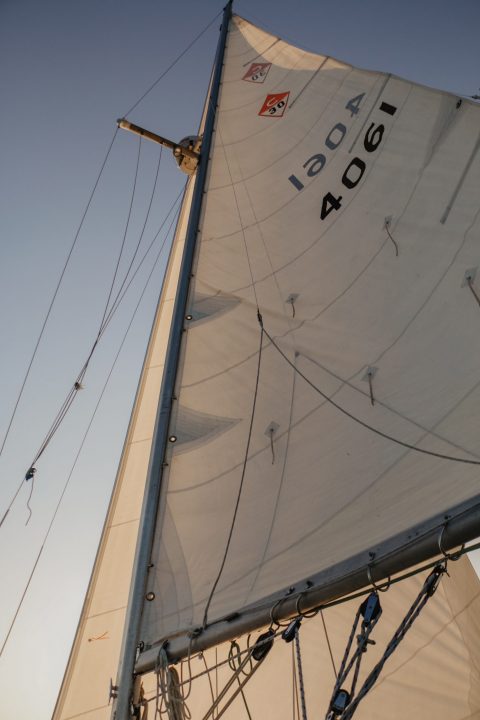
So if you have a cruising boat and need to pick some numbers, how do you figure out what to choose? If you’re buying a new sail, the sail maker can usually help you decide.
But the choice is entirely up to you. You could pick numbers of personal significance, like your birthday or anniversary. You could pick numbers about your boat, like the date you purchased her, her make and model dimensions, or the hull number.
If you don’t know your boat’s hull number, it is usually found in the middle of the HIN, which is the boat’s official hull identification number . The HIN is molded into the boat’s transom and included on all official paperwork. If your boat is registered or documented, the HIN is on the paperwork.
The first few digits of the HIN correspond to the country of origin and the manufacturer. In the middle, there should be a model code or serial number. Finally, the last four digits of the HIN are the date that the boat’s keel was laid by the factory.
If you ever want to apply your own sail numbers, it’s not hard to do. For the most part, they are made with self-adhesive lettering protected by backing paper. The biggest considerations are to ensure that the adhesive is strong enough and that material is pliable enough to be folded with the sail.
You can purchase lettering and logo material from most sail lofts or chandleries. You can also purchase pre-made block letters and numbers specifically intended for sails.
When putting the numbers on the sail, ensure that they are spaced perfectly. You’ll also want to think about how the sail will look when backlit by the sun. You can see the numbers on opposite sides, so you don’t want to let them overlap. Doing so would make both sets illegible on both the port side and starboard side.
Stingy Sailor has a great how-to on making and applying sail numbers .
Finally, we should note one final source of possible confusion. On racing sailboats, different sails are often referred to by different numbers! This isn’t an identification number specific to the boat, like the numbers discussed above.
Instead, this is a style of sail. Sails are numbered based on the wind conditions that they’re best for. Quantum Sails has a good write-up about the different shapes of jib sail and the numbers that correspond to them.
Many cruising sails may be familiar with the Code 0 (zero) sail, suitable for light air. This is an example of this numbering system used on racing boats.
What does sail number mean?
Sail numbers mean different things on different boats. They are simply a way to identify a particular boat from a distance.
On racing boats, the numbers help spectators tell who’s winning—and who’s not. On cruising boats, the numbers are often random and chosen by the boat manufacturer or owner.
How do I identify my sailboat?
Boat’s are commonly identified by a HIN, or hull identification number. This number isn’t found on the sails but rather molded into the boat’s fiberglass hull. It’s usually located somewhere on the transom.
The HIN works just like the VIN (vehicle identification number) in a car. It is unique to that boat and used on all official paperwork, like the registration. You can decode the HIN to find the manufacturer, serial number, and date of manufacture.
What is a number 4 sail?
On racing boats, different-sized headsails are given different numbers. For example, a number 4 jib is a small heavy air sail used in windy conditions.
Racers are always looking for an advantage, so like a golfer might choose a different club for a long drive, a skipper might call for a different sail combination to better match the wind speed and angle.
Matt has been boating around Florida for over 25 years in everything from small powerboats to large cruising catamarans. He currently lives aboard a 38-foot Cabo Rico sailboat with his wife Lucy and adventure dog Chelsea. Together, they cruise between winters in The Bahamas and summers in the Chesapeake Bay.
NASA's solar sail successfully spreads its wings in space
Spacecraft data has confirmed successful deployment of the futuristic technology.

More than four months after launching to space, a solar-sailing spacecraft has successfully spread its wings above our planet.
NASA's Advanced Composite Solar Sail System (ACS3) caught a ride to space on April 24 on Rocket Lab's Electron vehicle and, at the end of August, NASA shared in a release that its mission operators verified the technology reached full deployment in space. On Thursday, Aug. 29 at 1:33 p.m. EDT (5:33 UTC), the team obtained data indicating the test of the sail-hoisting boom system was a success.
Just like the wind guides a sailboat on the water, it only takes a slight amount of sunlight to guide solar sails through space. Though photons don't have mass, they can force momentum when they hit an object — that's what a solar sail takes advantage of. Thankfully for us, the spacecraft that deployed the sail contains four cameras that can capture a panoramic view of both the reflective sail and the accompanying composite booms. The first of the high-resolution imagery is expected to be accessible on Wednesday, Sept. 4.
The Advanced Composite Solar Sail System spacecraft will be put to the test over the next few weeks as the team observes the sail's maneuvering ability in space. By adjusting the orbit, researchers will be able to learn more about how to design and operate future sola- sail-equipped missions.
Related: If there's life on Europa, solar sails could help us find it
"Flight data obtained during the demonstration will be used for designing future larger-scale composite solar sail systems for space weather early-warning satellites, asteroid and other small body reconnaissance missions, and missions to observe the polar regions of the sun," Rocket Lab shared in a previous mission description .
— These scientists want to put a massive 'sunshade' in orbit to help fight climate change
— Japan declares its SLIM moon lander dead at last
— Salsa's last dance: This European satellite will fall from space soon in a spicy reentry
The location of the spacecraft in its orbit is roughly two times the altitude of the International Space Station. If you were looking at the sail from above, it would look like a square that measures nearly half the size of a tennis court at approximately 860 square feet (80 square meters).
Get the Space.com Newsletter
Breaking space news, the latest updates on rocket launches, skywatching events and more!
Join our Space Forums to keep talking space on the latest missions, night sky and more! And if you have a news tip, correction or comment, let us know at: [email protected].
Meredith is a regional Murrow award-winning Certified Broadcast Meteorologist and science/space correspondent. She most recently was a Freelance Meteorologist for NY 1 in New York City & the 19 First Alert Weather Team in Cleveland. A self-described "Rocket Girl," Meredith's personal and professional work has drawn recognition over the last decade, including the inaugural Valparaiso University Alumni Association First Decade Achievement Award, two special reports in News 12's Climate Special "Saving Our Shores" that won a Regional Edward R. Murrow Award, multiple Fair Media Council Folio & Press Club of Long Island awards for meteorology & reporting, and a Long Island Business News & NYC TV Week "40 Under 40" Award.
NASA's Perseverance rover begins ambitious ascent up a Mars crater rim
Early galaxies weren't mystifyingly massive after all, James Webb Space Telescope finds
Astrophotographer captures Comet 13P/Olbers and the Black Eye Galaxy M64 in stunning detail (photo)
- orsobubu "photons don't have mass" ... and size ... in future, this will reveal as one of the main scams in contemporary physics Reply
- DSyno How could it fly to the sun, when it's propelled by sunlight? I imagine it can't tack back-and-forth like a sailboat, since that requires friction of the water, and there is no such friction in space. It seems a solar sail could only be propelled away from the sun. Reply
- View All 2 Comments
Most Popular
- 2 SpaceX launches back-to-back Falcon 9 rockets within 65 minutes and aces 2 landings days after a failed booster touchdown
- 3 Rocket Lab's Mars probes reach launch site ahead of 1st flight on Blue Origin New Glenn rocket (photos)
- 4 This Week In Space podcast: Episode 126 — Danger! Rogue Planets!
- 5 Roll out with Optimus Prime in new 'Transformers One' trailer (video)
Stay up to date with notifications from The Independent
Notifications can be managed in browser preferences.
UK Edition Change
- UK Politics
- News Videos
- Paris 2024 Olympics
- Rugby Union
- Sport Videos
- John Rentoul
- Mary Dejevsky
- Andrew Grice
- Sean O’Grady
- Photography
- Theatre & Dance
- Culture Videos
- Fitness & Wellbeing
- Food & Drink
- Health & Families
- Royal Family
- Electric Vehicles
- Car Insurance Deals
- Lifestyle Videos
- UK Hotel Reviews
- News & Advice
- Simon Calder
- Australia & New Zealand
- South America
- C. America & Caribbean
- Middle East
- Politics Explained
- News Analysis
- Today’s Edition
- Home & Garden
- Broadband deals
- Fashion & Beauty
- Travel & Outdoors
- Sports & Fitness
- Climate 100
- Sustainable Living
- Climate Videos
- Solar Panels
- Behind The Headlines
- On The Ground
- Decomplicated
- You Ask The Questions
- Binge Watch
- Travel Smart
- Watch on your TV
- Crosswords & Puzzles
- Most Commented
- Newsletters
- Ask Me Anything
- Virtual Events
- Wine Offers
- Betting Sites
Thank you for registering
Please refresh the page or navigate to another page on the site to be automatically logged in Please refresh your browser to be logged in
Princess Cruises to sail to all regions of the Caribbean for the first time in 2026
The cruise company is offering six to 14-day itineraries around the caribbean islands, article bookmarked.
Find your bookmarks in your Independent Premium section, under my profile
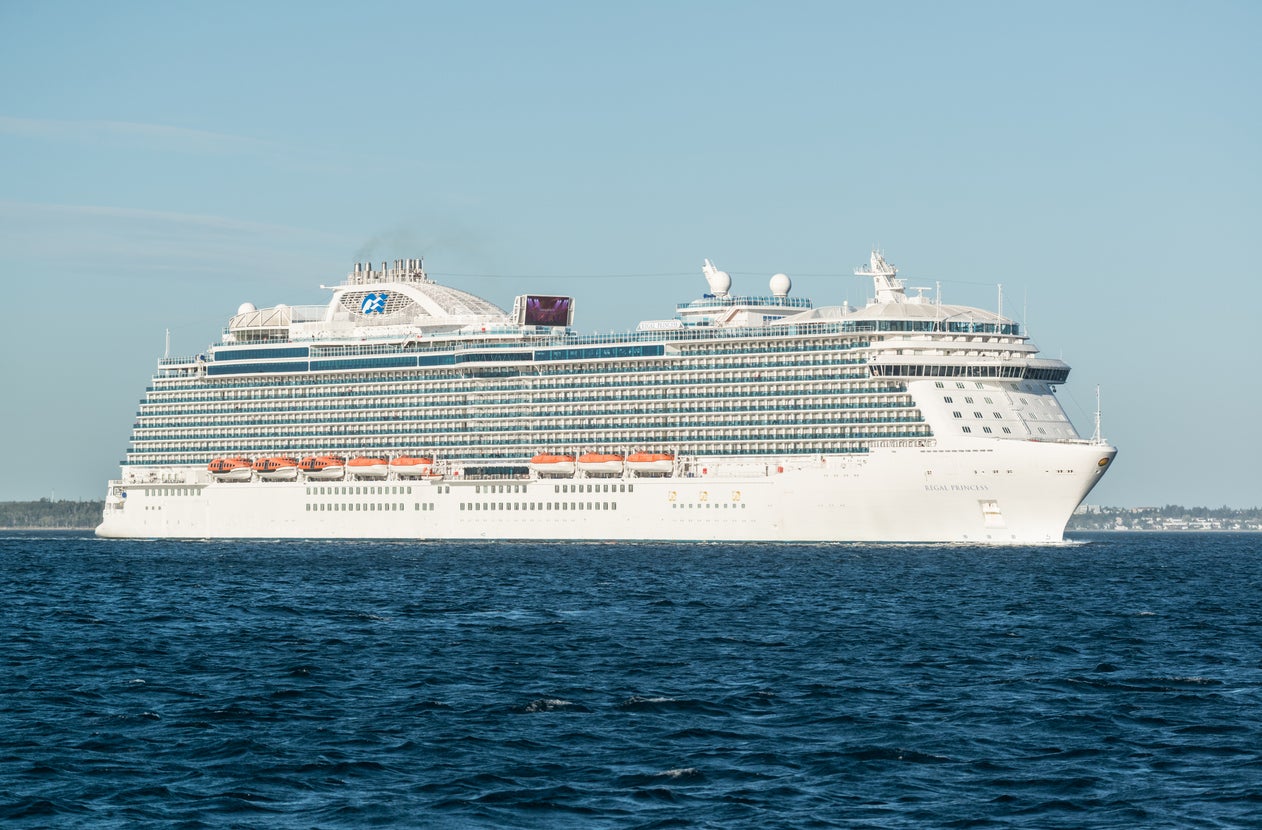
Sign up to Simon Calder’s free travel email for expert advice and money-saving discounts
Get simon calder’s travel email, thanks for signing up to the simon calder’s travel email.
Princess Cruises has announced it will be sailing to every region of the Caribbean in 2026 for its “biggest summer Caribbean cruise season ever,” with its ships stopping in summer hot spots such as the Bahamas , Turks and Caicos and Mexico.
The cruise company will have two ships departing from Florida , the Regal Princess and the Caribbean Princess , to take vacationers around the Caribbean, sailing to all regions for the first time.
The cruises are now available to book, with over 90 voyages sailing to every region of the Caribbean from two Florida ports, Port Canaveral in Orlando and Fort Lauderdale/Port Everglades.
“Princess continues to expand access to our world-class premium experience now operating from eight North America homeports,” John Padgett, the president of Princess Cruises, said.
“With ships now departing from both Central Florida and South Florida, it’s easier and more convenient than ever to set sail aboard the iconic Love Boat,” he added.
Caribbean Princess , which has accommodation for over 3,000 guests, is offering trips to both the eastern and western Caribbean on seven-day itineraries, with an option to combine the two regions on a 14-day ‘Caribbean Adventurer’ sailing.
The variety of cruises includes a six-day or seven-day trip around the eastern Carribean and the Turks and Caicos islands, a seven-day voyage around the eastern Carribean with Puerto Rico , and a seven-day sailing trip to the western Caribbean and Mexico .
Regal Princess , which has room for over 3,500 holidaymakers, is offering journeys to all regions of the Caribbean in the summer of 2026, including eastern, southern and western islands.
The cruise will embark on a seven-day eastern or western Caribbean itinerary or an eight-day cruise around the southern Carribean with the ABC Islands.
On the southern cruise, stopping at Aruba, Bonaire and Curaçao in April 2026, guests can also take advantage of extended port stays in Aruba and Curaçao, giving vacationers a chance to explore the islands for a little longer.
As for the seven-day cruises, two will journey around the eastern Caribbean, one with the Bahamas and one with St Thomas, and one other will sail around the western Caribbean, stopping at Mexico.
Guests who also want to make their holiday a little longer and visit multiple regions can sail on a combination cruise for 14 days.
Princess is offering a further two other cruises that will sail around the southern Carribean for a longer duration at the start and end of the season.
These include a Caribbean Princess voyage from Fort Lauderdale to Port Carnival, stopping at Princess Cays, Aruba, Curaçao, Bonaire, San Juan, Amber Cove, Grand Turk, and Nassau in April 2026 for 13 days.
The Regal Princess will be going on a 14-day trip from Fort Lauderdale to New York , stopping at Curaçao, Aruba, Grenada, Barbados, Dominica, St. Maarten, and San Juan in September 2026.
For more travel news and advice, listen to Simon Calder’s podcast
Join our commenting forum
Join thought-provoking conversations, follow other Independent readers and see their replies
Subscribe to Independent Premium to bookmark this article
Want to bookmark your favourite articles and stories to read or reference later? Start your Independent Premium subscription today.
New to The Independent?
Or if you would prefer:
Hi {{indy.fullName}}
- My Independent Premium
- Account details
- Help centre
A residential cruise ship that's supposed to sail the world for 3 years has been stuck in Northern Ireland for 3 months
- Villa Vie Odyssey was supposed to set sail on a global cruise from Belfast in May.
- Problems with the ship mean it's been docked there for the past three months.
- Some passengers are staying positive and using the delay to take trips elsewhere.

A residential cruise ship that was supposed to travel around the world has been stuck in Northern Ireland for the past three months.
Business Insider previously reported that the Villa Vie Odyssey was initially set to sail from Belfast in May. The ship has been docked there because it needed updating, as it's more than 30 years old. It was previously called the Braemar and operated by Fred Olsen Cruise Lines.
Villa Vie has said issues such as the aging ship's rudder stocks and recertification have delayed its departure by three months.
The 509 cabins cost at least $100,000 each. The Odyssey is due to sail around the world every 3 ½ years , visiting 147 countries and 425 destinations en route.
While the ship is stuck in Belfast, passengers can go on board during the day but not stay on it overnight.
The cruise line's CEO, Mikael Petterson, told BI in an email on Thursday that Villa Vie had provided residents with hotels, other cruises, shore excursions, and trips to the likes of Spain, Liverpool, and Amsterdam.
It's also welcoming residents on board, "where they can get their rooms ready and connect with crew and fellow residents," he added. "It is great to see the relationships building and the community bonding as we are looking forward to the next 15 years of discovery."
One couple on the ship, Johan Bodin and Lanette Canen, previously told BI they'd traveled elsewhere during the delay, to the likes of Italy, Croatia, Slovenia, and Sweden.
The couple said Villa Vie had also sent them on various excursions, including a trip to the Canary Islands and a cruise to the Norwegian fjords.
"We understand there are hiccups," Bodin told BI. "They're schmoozing us a bit to keep us happy. They're almost being too serviced-minded — I don't need to be pampered all the time."
Related stories
Holly Hennessey, from Florida, told BBC News: "We can have all of our meals, and they even have movies and trivia entertainment, almost like cruising except we're at the dock."
Angela and Stephen Theriac told the outlet they'd spent the delay traveling around Spain by train, visiting Greenland, and taking weekend trips to England.
"We keep teasing we will apply for residency here in Belfast," Angela Theriac told the BBC.
"We have eaten in every restaurant and had a Guinness in every pub," her husband added. "It is just all part of our adventure."
Angela Theriac previously told BI she and her husband had started decorating their floating condo with "personal touches," adding: "Our room is our bedroom, and the ship is our home."
Petterson, Villa Vie's CEO and founder, told BI, "We are going through the last few surveys and expect to launch within the next week."
He added that sea trials were scheduled for Monday.
Watch: Cruise ship captain breaks down 8 cruise ship disasters in movies and TV
- Main content

IMAGES
VIDEO
COMMENTS
Are you a beginner sailor and want to get acquainted with the names of the sails? Are you an experienced sailor and want to learn more details about the sails on a sailboat? Then this article is written for you! Sails form a crucial part of the sailboat because without them, there's no starting up. For that reason, there are many details about different types of sails concerning their ...
Discover the different types of sails and rigs, how they work, and what they are used for. This guide includes pictures and examples of sailboats from around the world.
A sloop-rigged sailboat typically features a mainsail, a headsail, and an additional light-wind sail, such as a spinnaker or Gennaker. The mainsail is rigged aft of the mast, while the headsail is attached to the forestay. The two most commonly used headsails are the Genoa and Jib. The sails are vital parts of a sailboat since you obviously ...
The type of sail you'll need for your sailboat depends on the kind of sailboat you have. Additionally, sails are highly dependent on the wind and weather conditions. Therefore, it's always a good idea to have different types of sails on board to navigate the ever-changing weather conditions.
If you are approaching sailing and sailboats from a very beginner's perspective, then the concept of different kinds of sails can be a strange one. We often believe we see one kind of sailboat with one kind of sail, and our simple minds lead us to believe you are only meant to move them around, and you will get to where you need to go.
As a general setup, sailboats will use three common sails, including headsail, mainsail, and specialty sail. Due to the varying wind conditions and the model of the sailboat, there are many types of sails including jib, genoa, trysail, storm jib, code zero, gennaker, and spinnaker.
So what are the most popular types of sails on sailboats? The mainsail, headsail (or jib), genoa, spinnaker, and gennaker are the most popular types of sails on sailboats. There are also a number of different configurations when considering the type of sail and mast in use including a sloop, fractional rig sloop, cutter, ketch, schooner, yawl ...
The sails are your boat's primary driving force. Your boat is designed to sail, and with good wind it will be faster and more comfortable than using the engine. Engines on sailboats are called "auxiliary" for a reason, almost every sailor hates to use them once they get the hang of sailing. But it won't happen if you don't learn to trim the sails, and to trim them you have to understand them.
Type of Sails Names: Decoding the Terminology. Mainsail and Foresail. The mainsail, as mentioned earlier, is the principal sail that catches the wind to move the boat forward. Foresail is a general term that includes various sails positioned near the bow of the sailboat, such as the jib and genoa. Genoa and Jib.
Attach the sails. Secure the bottom front (tack) of the mainsail and jib to their respective shackles on the boom and the bow of the boat. There will be a small line (outhaul) attaching the rear corner of the mainsail (clew) to the end of the boom. Pull it so the foot of the main is taut, and cleat.
So to help you navigate this world for which you often need a dictionary, here is one. These are sail names explained for beginners. Here are the 15 most common sails: Mainsail. Foresail. Genoa. Jib. Staysail. Spinnaker.
We make it easy to get new sails custom designed for your sailboat or sailing yacht, at the best prices online. Replacement sails for Catalina, Hunter, Beneteau, Pearson, C&C, and 15,000 more! Get a free quote within 24 hours or less. Headsails, Mainsails, Spinnakers, and Turtle Bags too!
Sailboats are powered by sails using the force of the wind. They are also referred to as sailing dinghies, boats, and yachts, depending on their size. Sailboats range in size, from lightweight dinghies like the Optimist dinghy (7'9") all the way up to mega yachts over 200 feet long. The length is often abbreviated as LOA (length overall), which ...
In this beginner's guide, we'll take a closer look at the different parts of a sailboat and how to orient ourselves onboard before we set sail!
The points of sail include into the wind (in irons), close hauled, close reach, beam reach, broad reach, and running, which go from windward to leeward and are all symmetric from port to starboard. Knowing the points of sail on a sailboat is important in terms of being knowledgeable about how your sailboat generates wind power while also being ...
The fibers from which sailboat sails are made could include any number of natural or synthetic materials, that can range from cotton, flax, or hemp, to polyester, nylon, and more. Deciding upon the right one usually depends on what type of sailboat you are using or your reason for sailing. The most common material used in sails is also the most ...
From assessing the damage on your current sail, to choosing the right replacement sail, to the actual process of changing the sail, we've got you covered. We'll also discuss the pros and cons of repairing a damaged sail versus buying a new one, and provide you with tips on choosing the right sail for your sailboat.
It can be a rust stain caused by a loop of chain that spent the winter lying on a sail. Perhaps a bird crawled under the sail cover and built a nest, pooping on the sail for weeks. Either way, cleaning a laminated sail presents a particularly vexing problems, since mildew likes the adhesive that bonds the material, resulting in a stain that is sealed between waterproof layers. Some of these ...
Beam reach: Sailing perpendicular to the wind, with the wind hitting the side of the sail. Broad reach: Sailing with the wind coming from behind at an angle. Running: Sailing directly downwind, with the wind coming from behind. Understanding how to navigate through each point of sail effectively takes practice and patience.
Having two sails (a mainsail and a jib) helps sailboats by allowing the sailor to better maneuver the sailboat through the water, easily increase the boat's speed, and have better handling over the boat overall. In short, having two sails offers improved control over the boat. With all these benefits, sailors can handle their boats with ease.
The prices of buying new sails vary greatly depending on several factors such as your boat's length, sail material, quality of the fabric, and many others. For instance, a 24-feet Bermuda sloop can cost between $1,000 and $2,500 while sails on mid-sized boats can cost between $3,000 and $5,000. The price of a new sail will, of course, depend on ...
Yacht designers need these sail dimensions to calculate thought provoking stuff such as the sail-area/displacement ratios of their creations, and sailmakers need them before they put scissors to sailcloth.
What Are Sail Numbers and What Do They Mean? First off, the purpose of sailboat numbers is solely to make your boat easily identifiable from a long way away. In many instances, a group of sailboats looks indistinguishable from one another from shore. Numbers are usually shown on the mainsail, but many racing boats have them installed on every sail they have.
Just like the wind guides a sailboat on the water, ... The Advanced Composite Solar Sail System spacecraft will be put to the test over the next few weeks as the team observes the sail's ...
Solar sails are an exciting way to travel through the Solar System because they get their propulsion from the Sun. NASA has developed several solar sails, and their newest, the Advanced Composite ...
NASA 's Advanced Composite Solar Sail System has achieved full deployment in space, marking a significant milestone with its sail-hoisting boom system now operational. High-resolution images of the reflective sail and supporting composite booms, captured by onboard cameras, will soon be released, enhancing our understanding of solar sail ...
17.2 The Finishing Window is the time for boats to finish after the first boat in the Division sails the course and finishes. A boat still racing when her finishing window expires will be scored points equal to the number of boats finishing within the time limit plus 25% of the
He explained that the 10m-long boat had been on previous Viking voyages before to Iceland, Shetland and Norway. "It's not a Viking boat, it's a Faroes fishing boat without a motor but with sails."
Princess Cruises will sail to all Caribbean regions for the first time ever in 2026, with stops in the Bahamas, Mexico, Turks and Caicos and ABC Islands The cruise company is offering six to 14 ...
The Odyssey is due to sail around the world every 3 ½ years, visiting 147 countries and 425 destinations en route. Advertisement. While the ship is stuck in Belfast, passengers can go on board ...